


















The results are in and we couldn’t be happier. Scania has been voted the number one* truck brand in the country by the people whose opinion we value the mostNew Zealand truckies.
We’re chuffed to have rated highest on all measures, including most preferred, comfort, safety, sustainability, performance, efficiency, service and parts. Thanks New Zealand. It means a lot.

 A PGF Transport Iveco X-Way heads north on SH1 near Hihitahi, between Taihape and Waiōuru. Photo: Faye Lougher.
A PGF Transport Iveco X-Way heads north on SH1 near Hihitahi, between Taihape and Waiōuru. Photo: Faye Lougher.

Hammar is the world leading manufacturer of Sideloaders, self-loading vehicles for containers and more. A competetive quality solution for container logistics, special transports and terminal handling.
+ Made in Sweden since 1974, delivered to more than 122 countries world-wide
+ Lift, transport and transfer up to 50 tonnes
+ Increase safety and efficiency with grounded containers
+ One vehicle, one driver, anywhere, anytime
EDITORIAL DIRECTOR
Dave McCoid
Ph: 027 492 5601
Email: dave@nztrucking.com
EDITOR
Gavin Myers
Ph: 027 660 6608
Email: gavin@nztrucking.com
For all advertising enquiries:
ADVERTISING MANAGER
Pav Warren
Ph: 027 201 4001
Email: pav@nztrucking.co.nz
Mike Devon
Ph: 027 332 4127
Email: mike.devon@nztrucking.co.nz
Maddy McCoid
Ph: 027 336 6811
Email: maddy@nztrucking.co.nz
SUB
Tracey
EDITORIAL
Faye Lougher
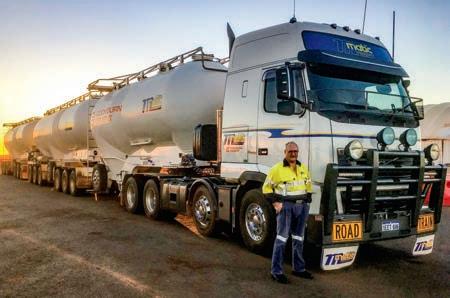


Further details and online complaints at www.presscouncil.org.nz
6 months
One
1 Year Australia (11 issues) $250




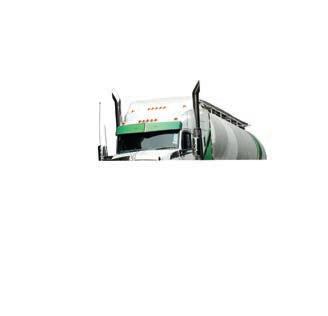


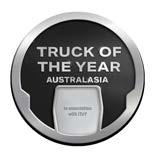



As I was sitting down to find a topic for this issue’s editorial, the latest International Transport Forum publication, Transport System Resilience , popped into my inbox. How timely, I thought, considering the extent to which ‘infrastructure’ and ‘resilience’ have dominated New Zealand’s headlines, conferences and general conversation recently. [On that point, you’ll want to turn to page 102 and read what Peter Brown from NZTA Waka Kotahi had to say at the Teletrac Navman TMS Conference.]
While we, and the ITF report, focus on the areas of infrastructure that relate to or impact the road transport industry, the country’s infrastructure problem has leached far and wide. Our old mate Nick Leggett, in his latest capacity as chief executive of Infrastructure New Zealand, is quoted as estimating New Zealand’s infrastructure deficit at just over $200 billion –including costs to build the projects we need and carry out the required maintenance on what we already have. That’s just under half of the country’s
2022 GDP. Words such as ‘substantial’ and ‘frightening’ are mere understatement. As far as transport systems are concerned, though, at least New Zealand isn’t alone. The ITF report discusses the results of an ITF roundtable on the subject, which brings together international experts from the Forum’s 66 member countries. So, as New Zealand grapples with its own challenges regarding transport infrastructure and resilience, what might we learn from our international counterparts?
It might seem obvious, but the key messages of ‘Transport networks are vulnerable’, ‘Disruptions have spill over effects’, and ‘Be systematic about resilience’ ring true. On that last point, the ITF says: “The concept of transport resilience must be built into national-level policies, long-term plans, appraisal procedures, competition policies and transport indicators.” On the face of it, the current coalition government seems to be on point with that recommendation, if a little impulsive in some of its recent decisions – Interislander,

anyone? Still, it’s early days yet…
The report notes that huge uncertainty exists on where disruptions might occur in future. Of course, we witnessed exactly that with the likes of Covid-19 and Cyclone Gabrielle. More worryingly, though, it also states that “despite progress in risk assessment, few governments currently use existing tools to identify potential risks”.
The ITF suggests an important distinction is between a system’s robustness, or mitigation – “the extent to which disruption reduces the functioning of the system” –and its capacity to recover or adapt – “the time needed to return to business as usual”. Improving robustness can be considered a form of mitigation, whereas recovery capacity can be obtained through adaptation measures … But how do we actually implement ‘resilience’?
It’s advised that resilience should be a core objective and an integral part of transport policy. We should develop analytical tools that help reduce uncertainty about future disruptions, and



develop guidance for policymakers on how to prepare for transport system disruptions. That involves estimating the costs of disruption, mitigation and adaptation, and embedding concepts such as redundancy. And finally, the report suggests learning how to deal with disruptions from other nations.
In fairness, I suspect little of this would be a revelation for the likes of the New Zealand Transport Agency, which seems to be aware of its role and responsibilities in keeping the nation moving, if traditionally a little hamstrung.
As Diane Edwards, the New Zealand president of CILT, said at the TMS Conference: “The real problem is the fact we have a three-year government cycle.” Yes, it’s the politicians for whom this may well make good bedtime reading.
Wouldn’t that be a sweet dream?
Gavin Myers Editor
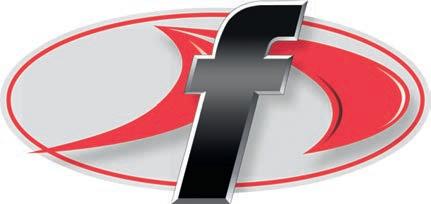


Fruehauf is excited to announce the acquisition of Adams & Currie Limited, a cornerstone in Christchurch's transport engineering sector for nearly 50 years. This strategic move enhances our market leadership and expands our manufacturing and service capabilities across the South Island. Adams & Currie’s reputation for excellence and a skilled team complements our commitment to quality and customer service. The Lunn Road site will continue operations, joined by Fruehauf's robust network to better serve our loyal customers. We celebrate this milestone, ensuring it's business as usual with promising growth and integrated service solutions ahead. Welcome to a strengthened future together!

Trailer manufacturer Fruehauf has announced the acquisition of Christchurch transport engineering company Adams & Currie.
Adams & Currie has manufactured trucks and truck bodies for nearly 50 years. Fruehauf owner and managing director Jeff Mear said the acquisition continued Fruehauf’s growth by achieving one of its strategic objectives.
“Adams & Currie has several key strengths that were attractive to Fruehauf. Its people are highly capable, skilled and experienced trailer and body manufacturers who have successfully delivered a range of products since 1976,” he said.
The manufacturing site at Lunn Road will continue to serve Adams & Currie’s needs while also providing a service centre site for South Island customers of Adams & Currie products as well as Fruehauf and Schmitz Cargobull.
Former executive directors Peter Laurenson and Keith Robinson will remain with Adams & Currie while Pat Lagan has chosen to retire.
Mear said it would be business as usual for all staff at Adams & Currie. “We will, over time, explore areas where Fruehauf’s capability can assist Adams & Currie and vice versa. There are several areas where there are distinct synergies but not concerning people numbers,” he said.
“We forecast to be growing staff numbers over future months to help attend to our growing South Island service offering.”
The Adams & Currie manufacturing site in Christchurch will complement Fruehauf’s existing manufacturing and service centre sites at Feilding and Auckland.
“Fruehauf had already secured the No.1 market position for trailer builds in 2023 and this acquisition will continue to strengthen this,” Mear said.
“The industry has many existing competitors; however, we remain focused on what we do and where we are heading, and Adams & Currie was a key part of our strategic plans to spread our reach to our many loyal South Island customers and to build resilience in our product and stronger service offerings.”

After three successful biennial events in 2019, 2021 and 2023, the fourth iteration of Wheels at Wānaka in 2025 will be the event’s finale.
“Anyone who loves machines, cars, tractors –anything and everything with wheels or tracks really – would be mad to miss Wheels at Wānaka 2025,” said event general manager Allan Dippie.
Dippie said the event had grown into more than just a vintage vehicle show, becoming a “biennial migration for vehicle owners and enthusiasts, a gathering of passionate individuals sharing their love for classic, vintage, modern and unique machines”.
“From roaring engines to gleaming chrome, the event has been a celebration of New Zealand’s automotive, agricultural and construction history and the craftsmanship that goes into creating and maintaining the mechanical masterpieces.”
The 2023 Wheels at Wānaka event was a huge success, with patron numbers reaching 40,700 over three days, compared with 25,000 in 2021.
The 2023 event generated $19.2 million in total direct spending. During the threeday event, 2500 to 3000 wheels and machines were on show, of which 350 were trucks and 106 earthmovers.
Dippie expressed gratitude for the unwavering support from partners, participants, exhibitors and the community, acknowledging the event’s financial contributions to many local and national charitable causes.
The 2025 show will celebrate 100 years of Caterpillar, with new interactive attractions and further additions to announced in the coming months.
Dippie said Wheels at Wānaka 2025 promised to
be a grand finale – “a fitting occasion to fondly farewell an event that has captivated vehicle enthusiasts from across the country and around the world”.
“The 2025 event will be buzzing with energy, with rare and exceptional vehicles, plus all number of machines, including hundreds of tractors, steam engines, cars and trucks, along with dirt bike races, interactive ATV, 4WD and rally demos, a huge earthmoving extravaganza, tractor and truck pull competitions and a non-stop parade-ground programme,” Dippie said.
“There’ll be a host of activities to engage attendees of all ages. Past participants and enthusiasts are encouraged to join in making this farewell edition a memorable one.”
Tickets for the 2025 event, at Easter Weekend 18-20 April at Three Parks, Wānaka, are on sale now.

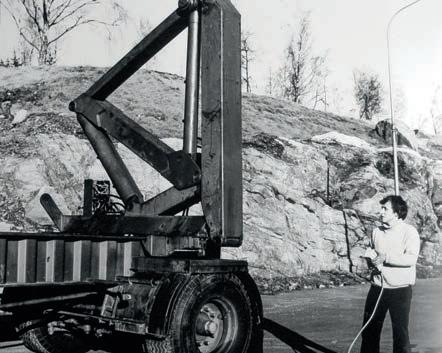
This year marks 50 years since Bengt-Olof Hammar developed the first Hammar sideloader and founded Hammar Maskin AB in Sweden. The first Hammarlift was built in the same year, later nicknamed The Shark due to its registration number HAJ 789. Haj translates as shark in Swedish.
The Shark is now something of a legend, having travelled around Sweden and Norway. In 2008, it returned home to Hammar in Olsfors where, 50 years after its manufacture, it still can be operated and lift heavy containers. The original

owner of The Shark remains a loyal Hammar customer and took delivery of its most recent Hammar sideloader in December 2023.
“Performing the first lifts with the first sideloader I built is one of my strongest memories during my 50-year journey with the company,” said Bengt-Olof Hammar, CEO and owner.
Hammar sideloaders have been sold into more than 122 countries; the company has an estimated 65-70% share of the global sideloader market, with five subsidiaries and more than 50 service stations worldwide.
Since 1974, the tare weight
for the lightest 30-plustonne capacity Hammars has decreased from about 10 tonnes to less than seven. The model programme has grown from two to seven different models, and the safe working load has increased from 30 to 45 tonnes.
In 2024, during its 50th anniversary, Hammar will take another big step in sideloader development, adding two new models – Hammar 550, the world’s first sideloader with a 50-tonne safe working load, and the new flagship model, Hammar 500.
“The Hammar 550 is a big step forward in broadening
the sideloader market and expanding what sideloaders are used for.
It has been developed for loads that are heavier and larger than any other sideloader has previously been able to handle,” said Bengt-Olof.
The Hammar 500 has a 36- or 45-tonne safe working load. It features a 6m crane reach and support legs that provide significantly increased stability.
These features allow a large handling area that, for example, enables stacking of two containers two rows deep. Its capacity is approximately equivalent to 100 metre tonnes.
CHRISTCHURCH BRANCH
9 Waterloo Road, Sockburn Phone: 03 344 5733

ASHBURTON BRANCH
189 McMurdo Street, Tinwald Phone: 03 344 5733


Scania NZ has appointed Fernando Bustamante as its new service director to help lead an eight-person team.
He previously worked as a services director with Scania Iberica (Spain and Portugal) in Madrid.
“I am very motivated about my leadership role in an area of the business that Scania NZ has committed significant, ongoing investment in,” said Bustamante.
“From the development of new service centres and workshops in Invercargill and Hastings this year to investing more than $40 million in spare-parts stock and the recruitment and upskilling of more technicians, it is all about ensuring that we have the best capacity to service our customer base.
“I am proud to lead a team that includes more than 400 technicians across our wider Scania network.”
Scania NZ managing director Victor Carvalho said improving customer experience was always top of mind.
“Every services-related investment we make is done with achieving better outcomes for our customers.
“The more expansive our service centre network is, the more highly trained technicians we have, and the more right parts that are available at their fingertips, all adds up to faster servicing of customer vehicles and less downtime off the road,” Carvalho said.
“Every dollar we invest in this area has a direct benefit to our clients’ bottom lines in their businesses.”
Bustamante hails from Argentina and has held service-related managerial roles with Scania for the past 19 years in Argentina and Spain.

It is with heavy hearts that we say goodbye to Aaron Thompson a cherished member of the Hino NZ family. Aaron was not just a colleague; he was a beacon of light, a pillar of strength, and a true friend to all who knew him.
Aaron was a man of many admirable qualities. His dedication and hard work was an inspiration. He was someone you could always rely on, someone who never wavered in his loyalty, and someone who cared deeply for those around him.
Aaron’s passion for work and commitment to excellence set him apart, making him a role model for us all.
His presence in Auckland’s Hino team for seven years was a testament to his dedication and love for his work. Aaron found joy in connecting with people and his genuine interest in others endeared him to all who had the privilege of knowing him.
Beyond his professional life, Aaron was a proud dad, an amazing brother, and a loving son. Family meant everything to him and he cherished every moment spent with his loved ones. He went out of his way to help others, whether they were customers, colleagues, friends or family.
It’s difficult to capture the essence of Aaron’s personality in words. He was a man of few words but his actions spoke volumes. Those who knew him were touched by his kindness, his generosity and his unwavering support. He had a heart of gold and a spirit that lifted others up.
As we mourn the loss of Aaron, the Hino NZ team wants to pay tribute to a man who brought so much joy and love into the world. Our thoughts and prayers are with his family during this difficult time.
Rest in peace, Aaron. You will always hold a special place in our hearts.


Daimler Truck has opened a new truck-dedicated parts warehouse in the logistics hub of Truganina in Melbourne’s west to serve its customers across Australia and New Zealand.
Situated on a 30,000m2 site, the facility will handle parts for the Mercedes-Benz Trucks, Freightliner and Fuso brands, and Alliance Truck Parts.
The new 20,000m2 facility features a solar array that can produce 125,000kW/h of energy each year, as well as a 45,000L rainwater tank, motionsensing energy-efficient LED lights, double-glazed windows and electric-vehicle charging stations.
Until now, Daimler Truck parts were kept at a warehouse shared with Mercedes-Benz passenger cars.

Daimler Truck Australia president and CEO, Daniel Whitehead, said introducing the new warehouse was a big step forward.
“This dedicated truck and bus parts warehouse is at the centre of our commitment to our truck and bus customers across

Australia and New Zealand,” he said.
“It will allow us to better meet their specific needs, which are very different to those of passenger car customers.”
Whitehead said the warehouse development fitted with the sustainability goals of
Daimler Trucks.
“Daimler Truck is a sustainability leader with our pioneering fully electric Fuso eCanter and Mercedes-Benz eActros and eEconic trucks, so it is only fitting that our parts warehouse is designed accordingly.”








UD Trucks’ most popular model, the Quon, turns 20 years old in May 2024 and UD Truck Distributors (NZ) (UD Trucks NZ) is celebrating 20 years of continuous innovation.
Since its launch in 2004, the popularity of this model has continued to grow in New
Zealand and around the world.
Marvin Fynn, UD Trucks NZ sales manager confirms, “This is a huge milestone for any truck model, showing its true versatility in applications around the globe, and New Zealand is no exception.”
UD Trucks launched the Quon

in response to increasing driver shortages and environmental challenges. The Quon represented a paradigm shift in the Japanese truck industry at the time, being the first to commercialise Selective Catalytic Reduction systems, or SCR, operating on AdBlue. This is now standard across the industry, and a legacy of the Quon.
The Quon was developed on a platform of innovation, and this continued with the launch of the “All New Quon” in 2017. This iteration focussed on the needs of the driver and the customer, but also in the consideration of the environment, which exceeded the Euro-6 emission level requirements.
The Quon continued to evolve and by 2023, UD Trucks had launched the “Advanced Quon” improving power of the GH11 engine and enhancing the driver experience even
further, inside and outside of the cab. These improvements in technology also saw even more gains in fuel efficiency and significant advancements in safety systems.
Fynn adds, “UD Trucks technology development programmes have ensured that the Quon stays ahead of the competition and the latest upgrades. The driver safety and cab comfort are no exception.
“We are grateful to the increasing number of loyal customers in New Zealand that are choosing to add the Quon to their fleets. As well, we continue to receive very positive feedback about performance and the driver experience, proving to be a valuable addition to fleets across many industries, with a wide variety of applications.
“We look forward to celebrating this important milestone with customers in the coming months.”
Truck-trailer manufacturer and service and repair provider TMC Trailers has relocated its Auckland service centre from its workshop in Wiri to a new, purpose-built facility in Drury. TMC said the move marked a significant milestone in the company’s growth and its commitment to enhancing its services offering.
“The new workshop in Drury represents a leap forward in our ability to serve our customers more effectively and efficiently,” said Richard Currie, managing director at TMC Trailers.
“Designed with the needs of our clients and the demands of the industry in mind, the new facility allows us to expand our capabilities in structural and mechanical repairs on trucks and trailers, ensuring we continue to deliver the highquality service TMC is known for.
“The decision to move to

Drury is driven by our desire to accommodate our growing operations and better serve our clients with a modern drivethrough facility with plenty of on-site truck and trailer parking.
“The new location will enable us to increase staffing levels, improve turnaround times, and
continue providing exceptional service quality.”
Auckland service centre manager Stephen (Mille) Millichamp, along with all existing team members, will be making the transition to Drury.
The new workshop will see the addition of a COF vehicle
inspection lane in late 2024.
“We’re committed to providing comprehensive solutions under one roof, making it easier for our clients to receive thorough and efficient service for their vehicles,” Currie said.



systems and components for the global transportation industry. Hendrickson’s ZMD™ ZERO MAINTENANCE DAMPING™ eliminates conventional shock absorbers by integrating the damping function into the air springs.
the most innovative, durable, lightweight and costeffective suspension systems and components for the global transportation industry. Hendrickson’s ZMD™ ZERO MAINTENANCE DAMPING™ eliminates conventional shock absorbers by integrating the damping function into the air springs.
Our Innovation Built In™ philosophy yields some of the most innovative, durable, lightweight and costeffective suspension systems and components for the global transportation industry. Hendrickson’s ZMD™ ZERO MAINTENANCE DAMPING™ eliminates conventional shock absorbers by integrating the damping function into the air springs.
Tel: +64 9 570 4721 www.hendrickson.com.au
Tel: +64 9 570 4721 www.hendrickson.com.au
Tel: +64 9 570 4721
www.hendrickson.com.au
MAN Truck & Bus has demonstrated megawatt charging on an electric truck for the first time, charging a MAN eTruck with more than 700kW and 1000A at one of the first MCS charging station from ABB E-mobility.
The Megawatt Charging System (MCS) is a new charging standard that enables superfast charging for heavy-duty electric vehicles (up to 3.75MW, compared with a maximum of 400kW with CCS).
MCS chargers are intended to provide a fast charge during the driver’s legally prescribed driving break. The new technology complements existing depot charging solutions, providing a slower overnight charge.
“With MCS, sustainable longdistance transport with trucks and buses will be possible.
Even if we are still showing a prototype here; with the new MCS standard, we have not only doubled the amperage but also the charging capacity within just a few years,” said Michael Halbherr, CEO of ABB E-mobility.
The international standardisation process for the megawatt charging system is expected to be completed this year. Alexander Vlaskamp, CEO of MAN Truck & Bus, said the goal was for 30,000 MCS charging points in Europe by 2030, about 4000 of them in Germany.
“The electric trucks are available, megawatt charging is working. We now need clear signals from politicians, not least to build trust among our customers in favour of electrification. We now need to build and scale up the infrastructure quickly.”



Trucks waiting for ferries may have an alternative to parking on Picton streets if a facility in Waitohi Domain is built.
Money has been set aside in Marlborough District Council’s long-term plan to terminate Port Marlborough’s lease of the domain and use it for parking, complete with a new ablutions block.
After the Kaikōura earthquake, when SH1 was closed, the council obtained partial government funding to build a temporary truck park on Waitohi Domain, which could accommodate up to 26 truck and trailer units. Once the highway reopened, the land was leased to Port Marlborough.
Since then, there have been
increasing issues with trucks parking on Picton streets, with the council receiving complaints from residents regarding noise at night from refrigerated trucks, and safety concerns. Council surveys have found more than 50 trucks and trailer units parked in Picton streets when ferries are delayed.
While the Riverlands Truck Stop near Blenheim provided toilets, showers, a laundry and a place to have a meal, a similar facility is needed closer to the ferry terminal.
An ablutions block with a swipe card system, similar to that used at Riverlands, could be installed with an estimated cost of $400,000. The cost of terminating the lease with Port Marlborough is $209,500.


Mason Murphy of Ranfurly Transport is this month’s winner of the Peterson Night Moves photo competition. This shot was grabbed early morning at Clarence with a sympathetic sunrise lighting up the morning sky. As Mason put it - ‘even Mother Nature supports the colour scheme at Ranfurly Transport’. Congratulations Mason! Now get your entries in for June...
ENTER NOW TO BE IN TO WIN A PAIR OF PETERSON’S SUN GLASSES
Send your best night bling photo as well as contact details into nightmoves@nztrucking.co.nz to enter








‘You can take the man out of the machine, but you can never take the machine out of the man.’ If you were going to sum up Steve Martin in one sentence, that might be it. Vocational trucker to the core, this year, the Dunedinite celebrates 20 years in business, and 45 years in an industry that’s wound into his DNA. The latest addition to his boutique fleet is typical Steve Martin – a reflection of its owner’s passion and purpose.
Story Dave McCoid Photos and by Carl Kirkbeck, Dave McCoid
Vegan, plant-based (they’re not the same evidently), carnivore, paleo, magnesium, CoQ-10, ginseng, cross-fit, Bikram yoga, cupping, blah, blah, blah! Every day, we’re bombarded by ‘experts’ telling us how to enhance our health and wellbeing through diet, supplements, introspective journeys, bizarre treatments, or some variation of an ageold exercise. But no one seems to be researching the health
benefits of the only thing that really matters. The one thing usurping all other contenders in the title race for life’s ultimate elixir … happiness. The truth is, you can eat whatever you like, pop a million pills and potions, sit chanting cross-legged on a hilltop with only a loincloth covering your whatsits, smear yourself in a Himalayan salt sludge, or exercise to the point of collapse: it all counts for shit if you’re not happy. Without happiness, you’ll be ill, grumpy,
video Crossing the Boyle River bridge on SH7.and drink for all the wrong reasons.
Both Mick Jagger and I know this to be true. I don’t know Mick at all – sadly – but I do know at 80 years young, the buzz he gets from standing in front of an adoring crowd while delivering what only he can more than compensates for an offstage life outrageously lived.
Me? Well, I’m in New Zealand’s garden city, Christchurch, in front of Steve Martin’s brand new 8x4 T610 Kenworth tractor

with 860mm integral Aero roof sleeper. The truck is hooked to his four-axle Convair bulkpowder semi-tanker, and as I stand, staring in bewilderment, I know exactly why Mick is still prancing around the stage at four score years. Something is coursing through my veins, purging every bad thing I’ve imbibed over the past month, leaving me completely refreshed, revitalised, and believing I can run a mile in bare feet over broken glass. I have no doubt
that ‘thing’ is happiness.
At that moment Rod Stewart himself appears. No, not the fake singing one, New Zealand’s own trucking one. The real one: Steve Martin, the man whose name is on the sleeper of this fine motor carriage. He’s picked up his industry nickname due to a more than uncanny resemblance to the sandpapery-voiced bard – who, incidentally, turns 80 himself next year.
Steve’s got 17 years up his sleeve on the two octogenarian
rockers, but he does share something in common with both – an absolute love and devotion to what he’s spent his working life doing, and it’s instantly apparent the moment he arrives at the scene with shades and swept-back hair. At 63 – going on 23 – a big grin appears and he says, “Cowabunga dude! Is that cool or what?” Only he could get away with a Teenage Mutant Ninja Turtle greeting at 63.
“Yeah mate. That’s cool all right.”
Like the Knowles’ Kenworth K220 or the James’ Scania 770S, there’s a lot to unpack here. If we’re being brutally honest, Kenworth’s T610 8x4 tractor in non-SAR posture sporting an integral sleeper is a machine you could get horribly wrong in the looks stakes unless you’re a true aficionado. Like its forebears from another era, the T600A, 602 and 604, you’re not starting with a classic block of clay from which to sculpt your beauty like you are with say, a bluff K-model cab, or bonneted T9/C5. Curved bonnets, set-back curvy guards, a low stance, integral sleeper cab, a heavily raked A-pillar – and adding even more cosmetic complexity over cousins of the past, a second-steer axle!
Lucky then the label ‘aficionado’ is perfect for Steve, truck-mad since he first opened his eyes and looked at the world. Nor is he alone. Nephew Reece has the diesel

chromosome somewhere in his DNA double helix and plays a vital role in day-to-day operations and the presentation of the gear. Together, he and his uncle are a great duo.
Nor is this their first T610 rodeo. Regular readers will recall Steve’s first Kenworth T610, a stunning 6x4 tractor with 600mm integral sleeper, winning the Top Truck spot in March 2021. That unit tows a B-train bulk-powder unit Steve built new a year or so before, towed by his Freightliner Argosy prior to the first 610 arriving. In the hands of Reece and Craig Hayward, the first T610 has just clocked over 850,000km and the trailers 1,400,000km – not that you’d know looking at them.
Of course, one of the greatest cosmetic enhancements you can give to a truck is to put a tanker behind it. Tubes, barrels, or bulk powder, there are few trucks that don’t look cool towing a tanker, and if you’re going to ‘top of the pops’ of the
tanker genre itself, then bulk powder takes some heading off. The new truck tows a 14.1m Convair five-hopper quad-steer and the beauty of that is the balance the quad brings to the 8x4 tractor. There are four axles and a natural rake front and back, making the whole thing look like something akin to the bullet train.
But, of course, balance and symmetry are only the start and Steve is quick to extol the virtues of the lower South Island truck customising scene – a pool of talent he says is the equal of anywhere and one he reckons is largely an undiscovered jewel.
“Ferg at McCormick Motor Bodies in Dunedin is a magician,” he says. “They set this whole thing up and it’s just faultless; they’re craftsmen. Look at the boltless guards and that fabrication behind the sleeper to tidy up gaps and make it all look seamless ... the vents made to look like light
surrounds, the deck plating – I just think it’s next level.
“Likewise, sparky Tony Mansfield at Harrex Downing and Little, who wired up the 130-plus Peterson marker lights. “The workmanship is absolutely on point.
“Then there’s the paint. Elite in Tīmaru. I think they’re without peer to be honest, and Andrew [Geddes] at Timaru Signs and Graphix has always done my signwriting. I don’t even tell him what I want. He asks but I just say, ‘It’s your canvas. Go for it!’ And look what comes back. I seriously believe we have the best craftspeople down south. I really do.”
There you have it, then! With two great family minds and a bunch of artisan craftspeople in action, the 8x4 tractor was always destined for spectacular – so much so that it earned one of the coveted spots inside the big gala event at the recent 100 Years of Kenworth celebrations at Mystery Creek.
Paused
for a coffee break at BP Raeward. It’s hard to fault.

Make no mistake, as happy a place as it is, Steve Martin
Contracting is another truckers’ trucking company, and if you’re not a full-immersion type, Darwin’s theory might well play out. That’s not saying anything about some adherence to archaic work practices to prove your worthiness, far from it. Like so many of recent, Steve says running the way we did back in the day is long gone, and keeping it tidy removes noise from the business and makes it more enjoyable to boot. No, the Darwin thing is more about who you are as a person … you know … working – trucks, eating – trucks, sleeping – trucks, TV – trucks, holidays – trucks … yeah, you get it. Testament to that is the nature of the operation versus the effort that goes into the machines. As you’ll read below, downtime is an ugly word at SMC, and some of the fleet family amass absurd mileages in no time at all. You would forgive Steve all day long if he were to take a sausage factory approach to his mechanical charges, yet every one is a showpiece, tastefully customised to within an inch of its life. Euro trucks are presented Euro-cool, and US gear US/Antipodean-cool … and never the styles shall meet. In short, presenting a plain white ‘sausage’ of freight utility to effect the daily transport requirement in this operation would be akin to hacking
your head off with a teaspoon handle. Cool on the outside is just as essential as inside the fridge van his Scania tows, and vital in the happiness culture, mood and productivity of the business.
It’s interesting when you think how many of the South Island’s devoted and slick operators come out of the Goodman Fielder camp. There is no better marketing – or assurance of product care – than passion, presentation and personal standards, and someone in the big show knows that implicitly.
Still one of the coolest trucking catchphrases ever, although in
all honesty, the days of trucks consistently clocking up big annual distances in the North Island – and even the top of the South, for that matter – are largely a thing of the past. There are simply too many people, poor and inadequate roads, few bypasses, and ever more delays at the points of load and unload.
Below mid-Canterbury, however, a couple of those factors begin to abate – there are fewer people, and as a result, better roads. Steve’s whole career has been around big mileage trucks – doubleshifting and familiarity with big annual distances are his normal. However, there are big
distances, and then … there are big distances. The 6x4 T610 in front of the B-train is hovering around 850,000km as it passes its third birthday, yet even that will induce a yawn from its owner. The triple-shifted Scania S620 on the Dunedin/ Christchurch, Dunedin/Central Otago milk and produce run has just pipped 1,100,000km at just two years and three months old. Yes, folks, you read that right. Suffice to say, horsepower in this yard always begins with a ‘6’.
“I run a Guardian Seeing Machine in that truck also and really rate it as a safety device.
“Yeah, it keeps you on your toes. The run is pretty much

On display at the 100 Years of Kenworth gala
The trucker’s trucker and he wouldn’t have it any other way. Right: The artisan work by McCormick Motor Bodies is everywhere – take this lower sleeper panel filler with vents made to look like light surrounds. event.
non-stop; the truck only switches off for its weekly service. The previous truck on the run was a Mercedes-Benz Actros 2663, and that was a bloody good machine. It was simply the support that let it down.”
A new S620 Scania was in the throes of being commissioned as we went to press. “Given the lead times on gear in recent years, the rule of thumb on that run is: on the day a new truck goes to work, you pretty much order its replacement.
“We’ll need to start thinking about the 6x4 610 soon, also. The trailers can have a spruceup sometime next year. They’re on 1,400,000km and in need of a bit of cosmetic here and there.
Stones, grit, CMA, [ice road treatment] and even flour, they all give them arseholes.”
Time for action. We are off to Nelson to deliver 27,500kg of flour into the Molenbergbranded silo at Goodman Fielder’s Nelson bakery. That payload puts us at about 47.7 tonne gross out of a potential 48. Light and airy bread might well be fantastic, but the flour tanker arriving at at the bakery arriving in a similar state?
Definitely not fantastic. The units are therefore fitted out with SI-Lodec scales in order to ensure the available compliance envelope is optimised. “Wouldn’t be without them,” says Steve.

“We can see on the tablet when loading without being in the truck, and when we’re unloading, it’s just another tool to help us know we’re all empty. Also, peace of mind when passing the check stations.”
The big Cummins fired up, Steve engages gear in the handstirred transmission and rolls out of the depot on Washbournes Road in Hornby. He winds his way to Main South Road before turning right at The Hub corner onto SH1 north. A quick stop at BP Raeward for the obligatory caffeination, and we all stand back for another moment to take the rig in.
Sitting plumb level, it’s pretty difficult to fault. The Kentweld bumper, grille bars, the stacks

are just the right size and length, the Armoury chrome rims contribute to just the right amount of chrome and colour code, and there’s little chance you’ll miss the whole thing with 131 additional Peterson lights on the tractor, another 51 on the semi, plus spots in the grille and green strip lighting. “According to Peter Swan at Convair, I’m the first to put the running lights along the top rail.”
Time’s up, the 610 rolled out and on through Woodend and Amberly before making the west turn at Waipara, just north of the CVST site at Glasnevin. Lucky, it was a lovely autumnal day and the rig made effortless progress up the Balmorals towards Culverden. By the time
 Photo: Craig Hayward.
Photo: Craig Hayward.
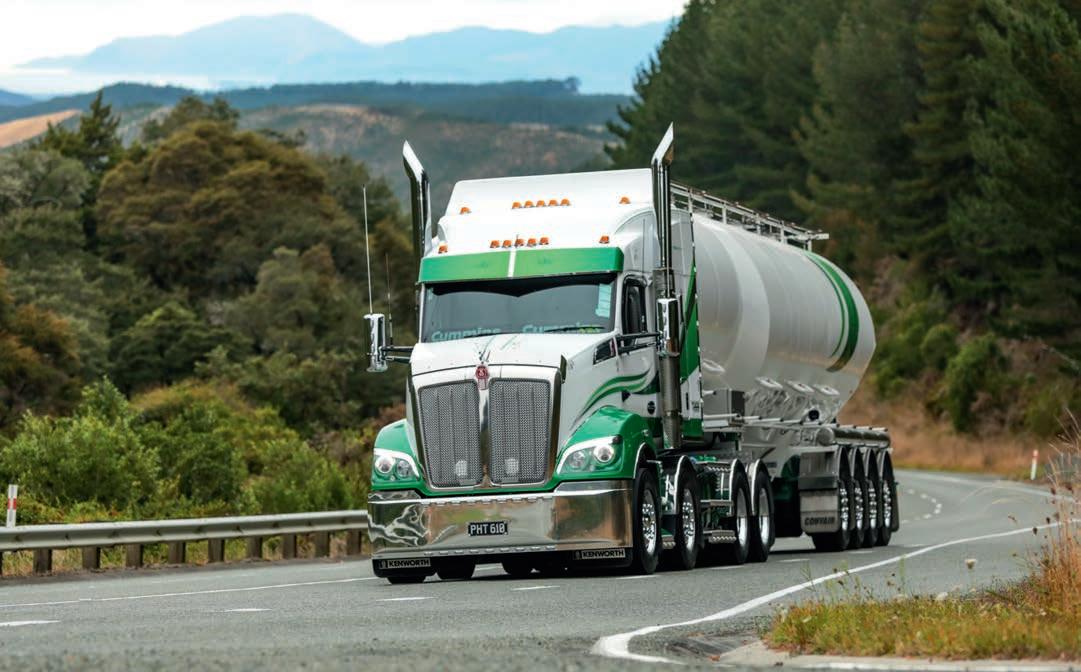
we reached the wee hamlet an hour and 20 minutes north of Hornby, the caffeine had done its job and bladder relief was required.
Steve operates between 1350 and 1800rpm as rule – tapping into the power bank on lift-off during early shifts to help get the show rolling, and as the ground speed increases, you hear the shifts shorten up, using torque to preserve the impetus gained.
It’s not the big steady climbs or long descents that test your metal in a manual truck. Finding the right sprocket before settling in for the big pull or descent should not present an inordinate challenge. The skill resides on stretches of road like
SH7 on the run from Hanmer through the Lewis Pass, and then SH65 and 6 down the Shenandoah on to Murchison and beyond. The rise and fall is relentless in varying grades and therefore road speed, with no consistency in lane width, and of course, constant directional change.
In Steve, I’m instantly reminded of Ray Feki in Tutu and Raewyn Manuel’s Western Star 4884 Ruaumoko (New Zealand Trucking magazine, September 2021). Steve lives up to every expectation you have of him when it comes to the execution of the trucking art form. His pedigree and decades in the industry manifest themselves in abundance. He
is completely at ease in his machine; it may as well be a Toyota Corolla. The shifter simply slides from one gear to another mid-conversation with no apparent signs he’s even listening to the truck –and yet we all know to what degree that isn’t the case. What the Steve Martins, Ray Fekis and Guy Knowles of the world tell us is how much the so-called boffins who bleat on about changing gears being a dangerous, inefficient, fatigueinducing distraction are, in fact, speaking through a hole in their hindmost quarters. What they are telling us is just how appallingly we’re doing at training the new generation when it comes to
understanding their machines at the seat-of-the-pants level.
“The Scania is a lovely truck and ideal for the work it’s on with multiple drivers. You wouldn’t find a quieter and smoother truck to drive, and I’ve never taken the AMT out of auto; it’s that good. But as trucks go, it’s just not me, you know? There’s nothing to do. It’s a me thing.”
The X-15 provides the perfect backdrop to events in the cab. Its guttural rumble is more than clearly evident and it certainly gets the sound meter working a little higher than we’ve been used to of recent – well into the second half of the 70 and even early 80dB range in times of action. This is truckin’.


What also exercised its presence was the large white thing full of flour hooked to the back. Running along past the Boyle River and climbing the Lewis toward the Goings section the semi was always ‘there’, and Steve says you need to be more cautious than in the B-train.
He’s a huge fan of the Convair product – “It’s the Rolls-Royce of powder tankers” were his exact words. However, neither does he take longevity for granted, making one purchasing decision he says pays handsomely when it comes to relieving stress in the units he owns – oscillating fifth-wheels. “This one runs a Holland, and the whole fleet is on oscillators. It’s just a thing I have. There’s so much twisting
and raking in the course of a day’s work and that stress has to go somewhere. I’ve got two on the B-train and Convair were a bit cautious of that originally, saying we wouldn’t feel what the back trailer was up to, but that’s all about the people you have working for you, I reckon. The Scania on the milk – that’s got one. Where we unload in Queenstown, the truck is on a severe angle while the trailer is level. Normally, a fridge trailer will let go first in the rear door frames, but that one’s mint. I’m convinced it’s the fifth wheel.”
The in-cab ride is certainly influenced by the big trailer and there’s the occasional nudge from the second steer, but nothing to write home about.
In all respects, it’s a Kenworth doing exactly what they do best, telling you how they’re coping. The 610 is barely off the mark with only 15,000km on the clock, but she scaled the steepest part of the Lewis in sixth high-split (12th) at 1350rpm and 45km/h. As the note lowers, the cab goes quiet for a moment, and two truckheads enjoy the sound of 2779Nm (2050lb/ft) of torque taking responsibility for progress away from the 459kW (615hp) of power at around 1400rpm.
In terms of spec, it’s a standard affair with a 22 series 18-speed manual Eaton Roadranger behind the 15L Cummins X-15, and to the rear of that, Meritor MT21-165 GPs

on Kenworth AG460 suspension.
Descending the other side the Jake happily holds the show at 1750rpm and 40km/h in fifth high-split (10th). Without prompting, Steve expressed his opinion on how essential it is to be able to stop dead on loaded descents in the event something is waiting around the next blind corner.
We round up the Shenandoah section north of Springs Junction and roll out through Maruia, Murchison and along the Buller River at Kawatiri toward the Hope Saddle. The surefootedness of the chassis in this country explains in part why this truck brand has earned the place it has in trucking folklore.
 Lewis Pass single lane bridge, outside and inside. Photo: Dustin Wright.
At the foot of the Shenandoah.
Lewis Pass single lane bridge, outside and inside. Photo: Dustin Wright.
At the foot of the Shenandoah.

Chris Gray is Steve’s man at Southpac, and Steve speaks highly of the relationship. “He rings you back! It’s that simple. If he doesn’t know the answer, he says, ‘I don’t know the answer Steve. But I’ll ring you back’, and he does. Every time. He’s an ex-Southern Viking man originally, and started in parts, so good habits were entrenched early. And he’s bloody easy to talk to.
“I have to mention Dean Cooper, also. He’s awesome. Anything you want, Dean can get it for you. I wanted train horns, I told Dean … I got train horns.”
The makers of Dr Who certainly
had a hand in Kenworth’s integrated sleeper range. Inside, the 860mm jobbie is a tardis, I kid you not. Outside, it looks low, sleek, and snug – inside it’s a big space. Steve’s north of six-foot and he has no issues at all standing up straight from the driver’s seat under a roof line that arcs up and away to the rear.
Grey Graphite is the official moniker for the buttoned vinyl trim.
Storage-wise, there are lockers above the driver and passenger, front and overhead, and under the bunk, which are also accessible from the outside – as is the bunk itself, #howcoolaresleeperdoors! There’s also shelving up high
either side of the sleeper, one accommodating the telly in this case. Between the steers on the right is a toolbox, and there’s a battery box on the left.
Hard plastics accommodate the high traffic areas and there’s woodgrain on the door-pulls and dash.
The 2.1m cab is a fantastic place to live and work. There’s nothing to say about the dash that’s not already been said – a clear binnacle, big, easy-to-getto buttons, great heating and air conditioning, and superb driving position. At some point, that binnacle will go full-digi and catch the K220 – who’d have thought we’d ever be heard saying that!
Steve opted not to have

the infotainment system by choice, saying in his opinion, the traditional set-ups give better sound and longer, more stable range.
There’s plenty of glass and superb mirrors. Visibility out front is fab with the bonnet raking steeply. Those car-like A pillars and bar-setting mirrors mean left/right clearance in the cab is as good as it gets in a fixed-mirror world.
The interior hasn’t escaped the Steve Martin vocational truck-nut treatment. Silver bezels adorn the binnacle gauge cluster and our friends at PearlCraft have provided the steering wheel and shifter head. Interestingly, it’s a PearlCraft-ed Kenworth SmartWheel, which


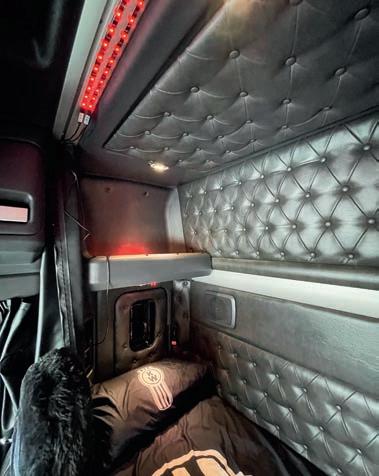
runs on an exchange basis by all accounts, meaning you send them yours, and they supply one that’s already done.
What I did really like … a lot … was the vinyl boot around the shifter. Often the custom heads look a little weird with a thin shaft under them – 10/10 for that.
Finishing it off is red strip lighting, which gives the whole thing a cool burgundy glow. To quote a ‘Martinism’ on that…”It’s a me thing.”
“The only place they’re [both Kenworths] in low-range is climbing the lookout point in Dunedin,” said Steve as we crested the Spooner’s hill north
of Nelson in seventh high-split (16th) at 38km/h and 1750rpm. At the foot of the range on the northern side, we pass through the string of hamlets between Hope and Richmond before arriving at Stoke and the bakery on Bolt Road.
“I was a bit worried about the big semi when I first got it. We can’t get the B-train into the Dunedin bakery without splitting it and using a wee shunter we have for the back half. Although the math said we could get the quad in there hooked to this one, theory versus reality … you know? I took it down for a first run-through, and it does fit, but man, it’s tight. There is no margin for error.”
Nelson is the complete opposite, it could not be easier
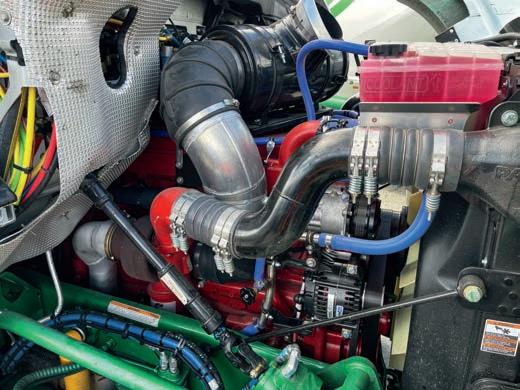
– drive in the gate and a straight back alongside the silo. We park for the night, awaiting the morning unload.
As with the first Kenworth, Steve’s gone for a PTO-driven blower mounted under the deck plate on the left. It’s a superb installation by Skookum, the local agent for the Convair product.
Powder tankers – I’ve always thought them to be a scary thing. There are horror stories about implosions when pressure differentials get out of whack, and explosions … funnily enough, when pressure differentials get out of whack – yikes! I was determined to understand the fine art of powder delivery from a gun!
Loading is easy – open the
hatches on the top and the flour just drops in via a sock from some magical place above. But then comes the getting-it-out bit, which normally means discharging into a hopper high in the sky. For that, you need a gravity-defying transport medium – enter, fast-moving compressed air.
First though, Steve hooks up the earth wires – yes, like most powders, flour can get all charged up during the unload process, and when you combine that with the considerable heat the discharge air generates zooming along the pipe, it’s best that electrical energy is given somewhere to go. Not doing so can be another reason things don’t go as planned.
Steve connects one end of
 1) T610 cockpit with a bit of ‘oomph!’. Silver bezels, PearlCraft and full vinyl boot on the shifter. 2 & 3) The outside presentation disguises the voluminous cavity within.
1) T610 cockpit with a bit of ‘oomph!’. Silver bezels, PearlCraft and full vinyl boot on the shifter. 2 & 3) The outside presentation disguises the voluminous cavity within.

the main discharge line to the blower behind the cab and the other to the input pipe running up the silo from the base. He fires up the X-15 and sits her on about 900rpm, and we are all go. That gets air moving along the main discharge line. One or two at a time, he then starts the aerators located in the bottom of each of the five trailer hoppers. They disturb and fluff up the flour, encouraging it out of the discharge tubes and into the main discharge line where it’s swished up and away into the silo and on to Molenberg heaven. The third member of the discharge trio is the top line, which essentially puts a compressed air hat on the flour in the hoppers so it does, in fact, continue to leave the show as
the load disappears. You can imagine not having the ‘air hat’ when there’s bugger all left in the hopper. It would all billow around inside and be hard to get in the exit line.
Steve can control any of those functions individually, so as simple as it sounds in principle, playing the bulk-powder discharge symphony is a learned art. The reason I say symphony is he can’t actually see anything; it’s all pressure gauges, watching the discharge hose out the back – if it’s wobbling steadily, that’s a good thing, and also the groans the hoppers make as the air does its thing. Good gauges, good sounds, and a wobbly hose mean good things; bad gauges, bad sounds, and a stiff or flaccid hose mean bad things – like









blockages. Having witnessed it all, the trailer does really sound alive, ‘telling’ you when its tummies are empty or unhappy. Interestingly, the whole thing happens at about 20psi. When you consider a truck tyre can be anything from 80 to 110psi, it shows just how complacent we’ve all become around highpressure vessels keeping our trucks and trailers rolling. There are also pneumatic hammers that ‘tap-tap’ the hoppers to loosen any residual. Done well, it’s a cinch, and just over an hour after arriving, the discharge hose is being packed away in its immaculate chrome carrier.
One thing we all learn as we get older is we don’t get many days, and every one wasted will never

be refunded. Not all are blessed to the extent Mick Jagger, Rod Stewart and Steve Martin are, where true happiness resides in their vocation of choice, and the mere act of working is a buzz.
Steve Martin has proved that in the world of trucking, outrageous uptime and presentation are not antagonistic bedmates as long as your passion matches what achieving both demands. The quid pro quo of that is when it’s your passion, you don’t realise the demand.
When you are that person, however, what truck do you choose? Well, that’s always individual, but it is the Steve Martins of the world that Kenworth builds its product for: vocational operators where the truck is far more than a tool of transport utility – trucks that can be individualised and not only tell the world what it is you do,
but who you are.
There was a lot of chat around the T610 pre-launch, in the same way there was pre the T600A back in the day. They were both very different-looking Kenworths, in the case of the 610, sleek with car-like A pillars. Would they encompass everything a Kenworth needed to be? Would they satisfy the Steve Martins of the world?
Not all change is bad. It’s often a case of moving with the times, finding your place in them without compromising who you are. In its products, Kenworth gives people the opportunity to do just that.
In conclusion, then, I give you the Kenworth T610 and Steve Martin. A product that can teach you a lot about values-based evolution, and a man who can teach us a lot about life and where its value truly resides.
Tare: 10,820kg (load certificate)
GVM: 32,000kg
GCM: 97,000kg
Wheelbase: 5400mm
Engine: Cummins X-15
Capacity: 15L
Power: 448 – 459kW (600 – 615hp)
Torque: 2779Nm (2050lb/ft)
Emissions: Euro-5
Transmission: Eaton Roadranger RTLO22918B 18-speed manual
Clutch: Eaton 2050lb/ft East Pedal Advantage 3 – VCT Plus clutch (manual adjust) with hydraulic clutch assembly
Front axle: Meritor dual MFS66-122 13.2T
Front-axle rating: 12,000kg
Front suspension: 12T taper leaf springs – load share
Rear axles: Meritor MT21-165 GP rear axles with dual diff locks
Rear-axle rating: 20,900kg
Rear suspension: Kenworth Airglide 460
Brakes: Drum
Auxiliary braking: Jacobs engine brake
Additional safety: EBSS (ABS, Drag Torque Control (DTC), Auto Traction Control (ATC)), FUP, additional productivity
Fuel: 695L
DEF tank: 160L
Wheels: Armoury chrome rims
Tyres: Front: 305/70 R22.5 (offset) Rear: 275/70 R22.5
Electrical: 12V
Cab exterior: Stamped aluminium, riveted and bonded 2.1m 860mm integral sleeper. Single-piece curved windscreen. Aerodynamic mirrors remote and heated mirrors. Cab skirts and roof spoiler.
Can interior: ISRI 6860/870 pro black air suspension driver’s seat. Woodgrain fascia. FM/AM radio and CB with four speakers and tweeters. Grey Graphite upholstery.
Extras/custom: Outside: Kentweld bumper, stainless-steel headlight surrounds, stainless bug guard with backlit bug and swan. Colour-coded stainlesssteel visor, chromed mirrors, twin stacks with 7in pipes, stencilled Kenworth shrouds on the stacks, stainless sleeper monogramed highlights, trim, and sleeper cab side skirts with marker lights. Alloy tank and cab steps with stainless-steel facia. Stainless-steel guard flair on front guard, stainless-steel second steer guard and hole-less stainless-steel rear guards with infills. Colour-coded deck plates and fabricated rear sleeper infills. Stainless-steel fifth-wheel rail covers. Custom rear stainless-steel-wrapped light bar with Peterson round lights. 131 additional Peterson marker lights. Slimline LED spotlights behind the grille. Six grille bars, painted fuel, DEF tanks, battery and toolbox (between steers).
PTO-driven blower fitted inside chassis. Inside: PearlCraft smart wheel and shifter head. Vinyl shifter boot. TV.
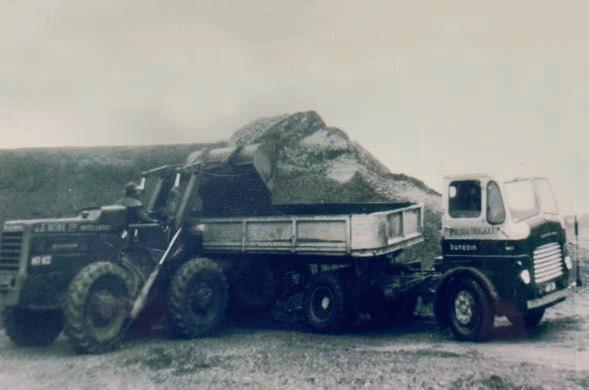

If you were looking for a time and a place to mark the beginning of the Steve Martin story, it’s Dunedin in the mid-1950s and two young fellas on the side of the road with a broken-down car. One of the two was Steve’s father, John Martin. From Motueka, he had finished his building apprenticeship and decided a roadie with a mate was just the ticket for a break away.
Anyone could have happened along at that moment, but it wasn’t just anyone who did. Wib Maxwell of Maxwell Brothers fame idled up alongside.
“Are you fellas alright?”
“Yep, yep, we’ll be right.”
“Right-oh, then. Oh well, if you need a job to sort yourself out, come and see me.”
And at that point, we could go straight to the T610 on the cover and say The End … not really.
John decided to take Wib up on his offer and soon found himself driving an Albion and tipulator on the Bluff Harbour project.
A lot of John’s work came via the company’s commercial association with Fulton Hogan,
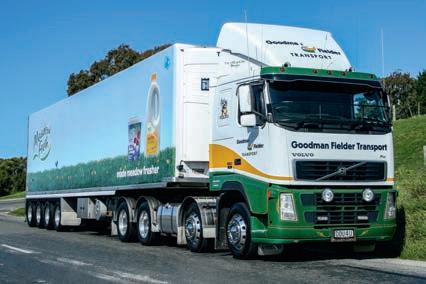
and it was while on a roading job in Mossburn that he decided to pop into a local diner where working behind the counter was Aileen. He was looking at his sweetheart and future wife.
Eventually, they set up camp in Dunedin, and John moved on to work for local carrier R A Little on a meat run to Queenstown. They had two sons, Stephen in 1961 and Lindsay in 1962.
Fun fact time! As we know, Steve has pursued a wonderful career in trucking and Lindsay is a builder in Christchurch – now there’s a perfect paternal DNA
occupational split!
“Dick Little bought Dad a brand new Mercedes-Benz 1923 4x2 tractor and he carted containers on an A-train, or logs via a dolly setup. A six-speed/ two-speed, it was an amazing truck, and he loved it. It had the two spare tyres mounted up behind the cab, side by side, and Dick reckoned that was all you needed for a log guard. He used to turn up at skids and the other log truck drivers would laugh at the single drive. Once in Tapanui, the crane driver said he’d give him a hand to get going, and then to everyone’s amazement, Dad and the Benz pulled up and away – half sideways climbing the hill leaving the site, and gone. When he got back for the second load, the crane operator said he’d been about the only one not towed that day.”
As Steve grew up, it was clear he was ‘diesel-powered’, and as soon as he was able, he was hanging around and eventually
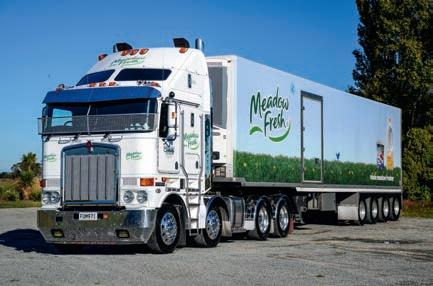



helping at the yard with whatever was happening – all the good wholesome activities: learning from the older men, riding in anything that moved, and helping with characterbuilding stuff like furniture shifts. Obviously, he would eventually join the fold, and his first real truck was a V8 petrolpowered C1800 International that was stretched and repowered with a 175hp Scania motor by company mechanic Russell Turner. “It had a sixspeed Gardner transmission and a three-speed auxiliary and was good for 85mph. I carted meat to the PPCS [Primary Producers’ Co-operative Society] cutting plant in the Kaikorai Valley.”
A change in the log fortunes saw Dick scupper that activity, and the Mercedes-Benz left the fold, much to John’s disappointment. His next steed was a new Leyland Crusader with a 290hp Detroit 8V71 – a truck he absolutely didn’t bond with, according to Steve.

“Dick eventually bought Dad a new Fuso and I was lucky enough to get the Crusader. I was about 20 years old by then and loved it – rain, hail or snow, the roof hatch was open and the windows down.”
The Crusader was eventually sold to Freightways OD Dave Bennet, replaced with a T81 Fuso, signalling the beginning of a happy association with the three-diamond marque for Steve. “I was heartbroken to lose the Crusader, but the Fuso was a good truck.”
R A Little was bought by Murray Samson in the early 1980s and Steve eventually found himself on a five-year-old International 3070, working one of the toughest physical gigs in the game – frozen meat deliveries from Dunedin through Central Otago. “That truck had done a genuine 86,000km, and I doubled the mileage in six months. The bloody heaters in them were diabolical. I used to tape butchers paper over


1) The Albion Steve’s father John drove for Maxwell Brothers. Where it all started. 2) The R A Little Leyland Crusader – his dad didn’t bond with it, but Steve couldn’t get enough. 3) The Mitsubishi FV315 Murray Samson bought to replace the T-Line. She had full bling for the day. All FV315s were cool, this one was extra so. 4) The Shadbolt Express! Tim even had a ride in this 400hp FV415. 5) The first Louisville. 6) A pinnacle truck for Steve in 1995, the Samson’s Ford LTLA. It delivered on every promise.
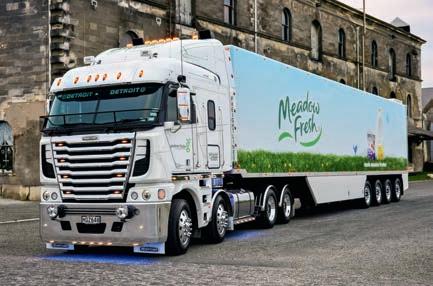
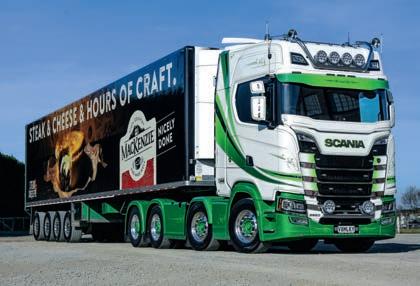
the front to try and raise the water temperature and make the heater work better. Murray was going to swap it out for an Eagle but I said, ‘Just get me a new Mitsubishi.’ He asked what I wanted on it, and I said, ‘A bullbar and chrome everything.’ And so, he did just that. It was an FV315 towing a 36ft (10.1m) fridge semi, and was a really cool truck. I won the Golden Guitars truck show with it.”
On linehaul now, as with Steve’s prior work, the trucks were double-shifted with the regular run commencing in Dunedin, carting general up to Christchurch, and then Invercargill produce south. Steve was required to be in Dunedin by 2am so the south leg driver could be at the Invercargill markets by 5am.
Next came consecutive Mitsubishi FV400 series trucks, and the second 400hp unit will always be remembered, not just for how well it went.
“I was having a break at the servo in Tīmaru about midnight and he just walked in and asked me where I was going and could he grab a lift!” The year was 1993, and ‘he’ was the one and only Tim Shadbolt – boisterous, 46 years old, and using the PR value of hitchhiking from Auckland to the deep south as the kick-start to a by-election campaign in Invercargill. Steve said though there was an element of truth, it wasn’t all PR. “It was the only way he had of getting down. He wasn’t that well-heeled at the time, apparently. He was genuine-as. I was heading right through that night and so he stayed with me. When we got to Invercargill, the telly was there, it was all go. He was great company, a really funny bloke. He was incredibly open and honest and probably told me more than he should have.” Steve laughs as he thinks back. “That truck is still around in the North Island, working as a mobile accommodation unit on movie sets.”
Then came two Ford Louisvilles, the first a Cummins N14-powered LNT, followed in 1995 by a truck he says was his
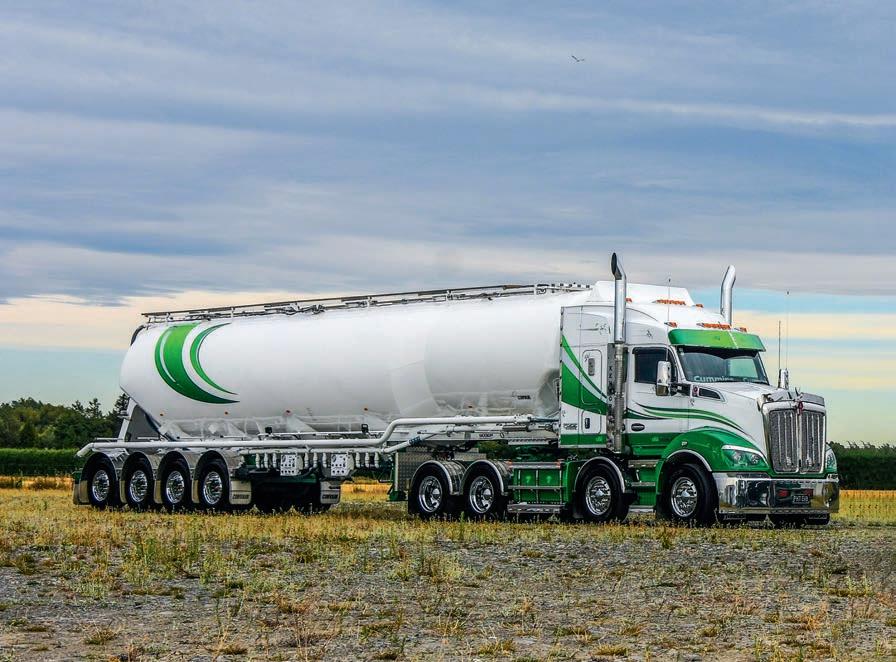
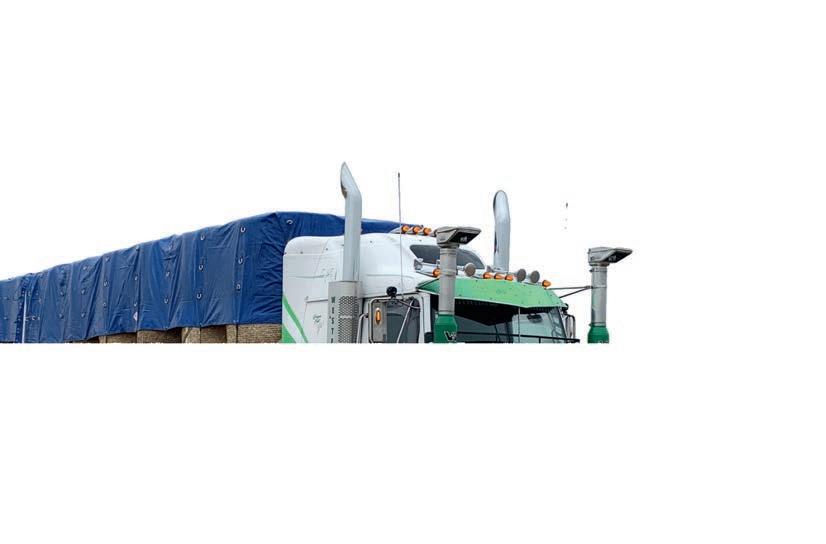

The Western Star is as cool a ‘sweeper’ as any fleet could wish for. There when needed, and when opportunity pops it’s little head up. Photo: Martin collection.
pride and joy – an LTLA or LTL Aeromax. “It was a fantastic truck and a big deal at the time. I went to the launch in Auckland, and it was on the stand at Mystery Creek that year.” The truck lived up to its promise, too: the 321kW (430hp) Detroit 60 Series was, in Steve’s words, “an incredible motor”, running out to well over 1,000,000km without being touched.
But, the only constant is change and things were certainly changing in the business. After 20 years in the R A Little and Samsons fold, all the way from enthusiastic kid to frontline driver, Steve accepted a job
offer from Alan Simms at Quality Bakers in the company’s bread distribution arm. “I started as a fleet driver for the first few years before the offer of an ownerdriver position in 2004. That was a big deal for me.” Steve Martin Contracting was rolling.
Steve’s first owner-driven truck was a Volvo FH460 daycab truck and trailer, carting bread between Dunedin and Invercargill. In unison with his previous driving history, where at least two of the same brand followed in succession, that truck was replaced by an FH520 sleeper cab. Following a restructuring of the runs, bread
gave way to milk, requiring the trusty Viking to be cut and tucked into a tractor unit so it could pull reefers. The new regular run was as familiar to him as the old – Dunedin/ Christchurch then home with stops in Ōamaru, and every second day a strop around Balclutha, Gore, Mossburn and Otautau, all in a six-days-a-week repeat cycle.
“Nothing wrong with the Volvos at all. They were bloody good trucks. But after the 520, they went to emissions fluid and I wasn’t ready for that.” [At that time, neither was the deep south network, to be fair – Ed.]
The two T610s make a spectacular duo. Photo: Andrew Geddes.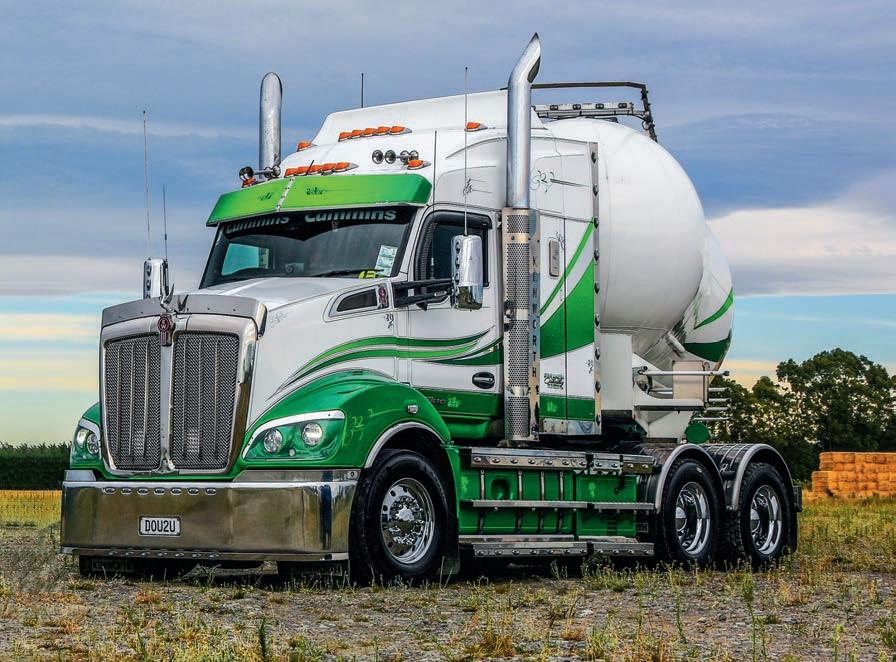



Then came the first headache. Unlike Guy and Helen Knowles, Steve didn’t escape the Cummins ISX EGR era unscathed, and the one in the Kenworth K108 Aerodyne that replaced FH520 was a troublesome child. “Five EGR coolers, three turbos, three radiators, and then a motor job all before 800,000km. Luckily it was on fleet management, so didn’t hurt me beyond inconvenience and having to cover it.” Then he rolls his eyes. “It’s been largely fine since the motor jobs so the owners after me have had a bloody good truck.”
In 2016, the first Freightliner Argosy arrived, a truck he still says today is without doubt the “cheapest truck to run I’ve ever owned. Both of them!” He glances across at ‘the old girl’, the original flour tanker tractor, now used as a backup to the two T610s and says, “950,000km and all it’s had is a clutch. That’s it.”
He’s also quick to extol the South Island’s legendary Freightliner salesman Trevor McCallum, saying, “Such a really nice guy and there’s nothing he didn’t know about a Freightliner. I sincerely wish Trevor all the very best.
for loading has moved in the intervening years to a facility on Blenheim Road in Christchurch, and although Steve still calls Dunedin home, the flour tankers operate ex-the Garden City. When it came time to replace the Argosy on flour in 2020, Steve did look at the big Cascadia, but the measurements didn’t quite fit, so Kenworth got the nod.
“The tractor’s been a good truck and attracts a lot of attention still. Last month, it slipped a liner and that’s been its first hiccup.”
Today, the fleet consists of five units – the two Kenworths on flour, the Scania, the Argosy as the spare flour tractor, and a devilishly handsome Western Star 4884 as a floating relief/ cover truck, or whatever else is needed.
The flour tankers run Christchurch/Dunedin, Christchurch/Nelson and Christchurch/Wellington. The hectic triple-shifted milk and produce run still largely follows the same pattern, except the interior run has moved from Southland to Central Otago. Day to day, Steve keeps the milk and bits and pieces rolling along, and filling in the gaps where needed – a great way to keep tabs on your business and understand what’s going on at the frontline. The reality is he loves trucks as much today as he’s ever done, and that’s where he likes to be most.
“I’d have definitely replaced the milk-run Argosy with another in 2018 had the Freightliner story here not begun to change, with increased pricing and then sadly the end of the truck.”
We’ve just mentioned the Freightliner Argosy on flour, so that’s a good segue. It always pays to answer the knock at the door because, sometimes, it is opportunity, and in late 2016, Steve took on the bulk flour deliveries ex-Tīmaru to the Goodman Fielder bakeries in Dunedin, Nelson and also up to the Hutt when product flow required. The source point
Steve confides, although he didn’t have any biological children, he has three awesome step children – Kane, Kate, and Dave Fitzgerald – along with two gorgeous grandsons, Lincoln and Lochie. Dave followed in Steve’s footsteps, with his love for trucking, and drives for RD petroleum.
Nephew Reece Martin runs the flour operation. We met Reece in the March 2021 Top Truck article. Being Steve’s nephew, and interested in the flour side of the business, he is the logical destination for succession. “He loves it, and he’s always on top of the game. He can pretty much tell you at any
moment how much flour is at the various destinations, and where the trucks are going.
No business runs without a pulse, and Steve does not hesitate to acknowledge family, mentors, bosses, peers, colleagues and staff throughout his career and takes great pride in the young people he’s helped into the industry.
He enjoys meeting and yarning with folk, although he’s certainly not a sufferer of fools in any way; you can’t be to stay in business, especially one as intense as his, with the uptime the trucks are expected to have. You could say Steve runs the old General MacArthur chestnut of beginning the relationship with 100% of his respect, and then it being up to you to maintain that. All that good stuff aside, he’ll admit in a heartbeat who the cornerstone of his approach

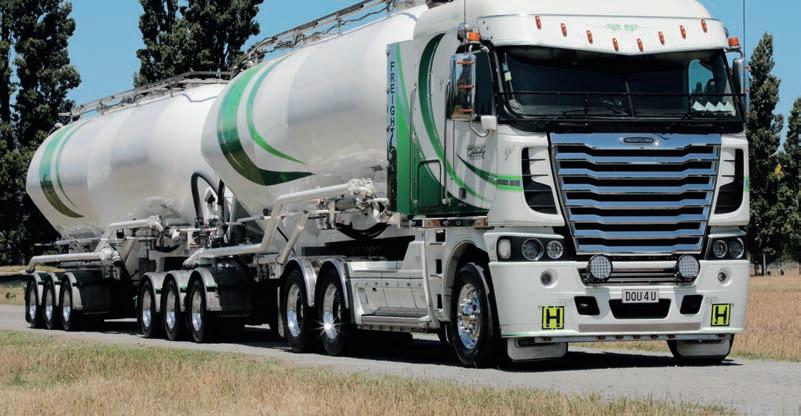
Following in the original Freightliner’s footsteps, the first flour tanker has had one clutch in 950,000km.
and attitude is – his wife Robyn.
“Robyn’s a registered nurse, working at the hospice as a community coordinator, helping people through end of life. She loves her job, and says it’s an absolute privilege to meet and

help people when they’re at that point in their journey. Robyn supported her own mother and both Mum and Dad through to the end of their lives. I can’t put into words the respect I have for her. She’s just bloody amazing.”
He chuckles, “When I’m a bit stressed, she just has this way of putting the whole thing into perspective, calming me down, and we’re good to go. She is one amazing lady and I love her to bits.”

is a chip off the old block and appears to have both diesel and flour in his veins! Now that’s a mix.
Left: Steve and Robyn proud as punch and looking sharp outside the Kenworth 100 year function in February.
What an absolute blast for two days. It was really just a bunch of truckheads having the best time with a superb machine. Thanks to Steve for letting us do this on his 20th year in business, and making it happen so easily from his end. All the best to one of the industry’s true good guys.
Thanks to Chris Gray and Richard Smart for Southpac’s everwilling cooperation and support.
Steve’s nephew Reece Martin
Every cover truck holds a special place in the history of New Zealand Trucking magazine. We love to see where their road has taken them.
• Currently owned by: Hira Bhana & Co.
• Current odo reading: 500,000km
• Mechanical work: Gearbox repairs
• Current work profile: Fresh market produce from Pukekohe to Auckland twice daily
• Currently driven by: Gerald King
• Basic original spec: Isuzu 6WG1-TCC at 390kW (550hp), Isuzu MJX16 AMT, Isuzu RT210 rear axle on Isuzu four-bag air suspension, 4,1:1
• What we said in 2013: “This is a large roomy cockpit that is a lot quieter than the 460, and with quiet braking from the Giga-Tard and the benefits of the AMT combined, it’s a nice package to punt down the road.”


Unfortunately Hira Bhana was unable to supply a current photo of HBB973 before we went to print. However, we know it is still on its original run, with its original driver. “It’s due for replacement, but we’re still pretty happy with it,” says director Amrut Bhana. PROVIDES ASSISTANCE to the driver.
Blind spots are a major contributing factor in heavy vehicle vs pedestrian/cyclist interactions, particularly in left hand turns. MAX-SAFE have a range of solutions to help increase the driver’s awareness of vulnerable road users around their vehicle. Our solutions include optional visual and audible alerts for both the driver and the vulnerable road user i.e. inside and outside the cab. One such offering is MAX-SAFE Side View™: an affordable solution based on an AI camera that detects and protects pedestrians/cyclists – ultimately enhancing safety.
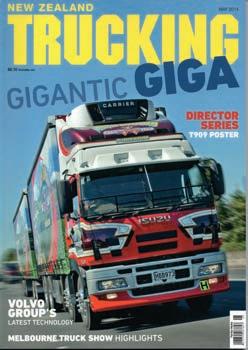
A big bold appearance meant HBB973 made a statement when it was new.


• SAFEGUARDS the side of the VEHICLE.
• PROTECTS PEDESTRIANS, cyclists and motorcyclists.
• HIGH ACCURACY – detects people (stationary and moving).
• MORE AFFORDABLE than sensor systems.
• SUITABLE for most ANZ CONDITIONS.
• Provides ALERTS and AUDIBLE WARNINGS.
• STATE-OF-THE-ART AI TECHNOLOGY.
• GREATER SAFETY and PEACE OF MIND –for Drivers & Fleet Managers.
• Part of the MAX-SAFE SAFETY ECO-SYSTEM.



 Story by Ken Kirk
Story by Ken Kirk

He’s the ultimate ‘you won’t know until you give it a go’ type bloke who has never let the chance to write another chapter in his life book go by. Having hung up the keys – almost – on a fantastic career in trucks and other things, Ken Kirk has taken the time to share his time and tales.
Kiwi-born and raised
I was born in Picton in 1948.
Dad worked at the Tory Channel whaling station at the head of the Marlborough Sounds, and I went to the station school in my primary school years and then onto secondary in Christchurch.
In May 1962, I got expelled from college at the age of 14 and a half. Mum wanted me to try another school, but I wasn’t interested. I found myself a job with one of the vegetable markets in Christchurch working as an offsider on their case yard trucks. After I had been there a few weeks, the two drivers I was
working with took a shine to me because I was a willing worker and listened to what I was told. After a few weeks of me asking questions about driving the trucks, these two men, Don and Bill, who I will be forever grateful to, asked me if I wanted to learn to drive. Of course, I said ‘yes please!’
They laid out the rules and made it very clear that if I stopped listening, the lessons would stop. I listened and they spent the next five months teaching me how to load and drive a truck the right way, as they put it. I have carried that
teaching with me all through my driving life.
Mum finally talked me into going back to school and finishing the fourth form, which I did in December that same year, but I left once that was done. We moved from Christchurch back to Picton where I found a job working for a cable-laying contractor in Blenheim.
This was about February 1964 – I was just a kid labourer until the day the truck driver didn’t turn up for work. We had two trucks. The boss drove one and the truck driver drove the other. After a lot of ringing around

he came out and said to the other labourer and I that there wouldn’t be any work that day because we didn’t have a driver for the truck that carried the ditch-digger.
“I can drive it,” I said.
“What do you mean, you’re only 16,” he said.
“Yes. I can drive as well as Charlie can and probably even better – I don’t like the way he drives.”
“But you are too young to drive, you don’t even have your car licence yet, do you?”
“No, but I’m going for it in two weeks.”
The truck in question wasn’t flash, an old flathead petrol V8 Ford with a snub nose, a fourspeed crash box, and a beer crate with a wheat sack folded on it for a seat. On it’s back was a Fordson tractor with a tooth chain trench digger. The upshot was he got me to take it for a run around the yard and then back it into the shed again.
“Well, you can obviously drive, and we do need to get to work, so let’s go.”
Two weeks later, I got my car licence and the boss applied for a special heavy truck licence for me that got knocked back, so we just kept on doing what we were doing and never got caught. Charlie never did come back so I was the truck driver until the job ended. That carried on until the contract ran out and I went home to Picton where Dad got me a start with Todd’s Transport (later taken over by Kirby Carriers). The company did general freight in and around Picton and Blenheim. I was just shy of 18, so they took me on and booked me in to get my heavy trade licence.
The day I went for my truck licence in 1966, the cop who took me remarked I was extremely competent for someone who was just getting his licence, but didn’t ask any more questions.
I worked for Todd’s for about two years and obtained my heavy trailer licence in that time. I then spent a year driving for Nelson Fisheries in their relatively new Ford Thames
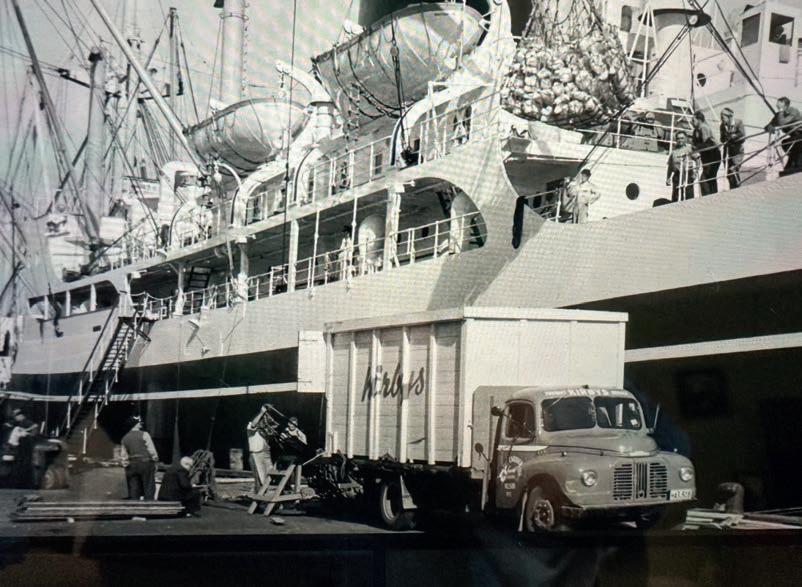
1) Port of Nelson in an Austin Loadmaster unloading mutton carcasses – note the sling-load in the top right. It was carted in a wooden bin and wrapped in muslin. 2) Ken’s first big linehaul rig was a Detroit-powered KM Bedford. Character-building stuff, but good adventures and memories. Seen here with a load of general on the Desert Road.
3) An FV315 and side loader working in and around greater Wellington as well as some linehaul. 4) A much-loved truck and job. The FV315 eight wheeler and four-axle trailer, taken here at the Makatote viaduct in the National Park in the early 1980s.
Trader (the long bonneted one), picking up catches off boats that sold to them from Port Underwood and French Pass, as well as stock loads to and from Nelson.
In 1969, I moved to Wellington and drove for BP doing tanker work delivering home heating oil and some bulk fuel to service stations. I did this for about 18 months and then moved into general freight with Container Freight for a couple of years.
A complete change of direction came in 1972 and I spent three and a half years as a relieving lighthouse keeper on lighthouses all over the country,




until my younger brother was killed in a tragic boating accident just off Tory Channel. I thought, ‘if he can die so young, I had better get moving and see some more of the world before it is my turn’, so I packed up and went to Australia for almost two years.
While there, I drove experimental Mack V8s, D8 Caterpillar dozers, graders, frontend loaders, Haulpak mining dump trucks, and anything else someone needed a driver for in the mines.
I then did a stint on a prawn boat as a deckhand fishing
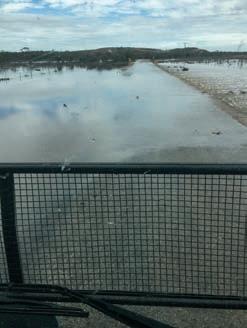

for prawns across the Gulf of Carpentaria and the top end of Australia before getting into interstate driving work, including the Darwin milk truck out of Townsville; an Aussie-cab Atkinson with a 671 Detroit and nine-speed in her. It was a good job for a few months after which I flew back to New Zealand to marry the girl who had waited nearly two years for me to come home.
We got married in 1975 and settled in the Hutt Valley. I went working for Haldane’s Haulage for a couple of years in a little TK Bedford on around-town parcel work. Haldane’s then shut down, so I decided to lease a three-ton Isuzu truck to do around-town parcel deliveries for a company that gave me guaranteed work.
That lasted a bit over a year until the company I was carting for folded. A short stint with DJ McGregor’s on linehaul furniture removals taught me I didn’t fancy doing furniture removals for a living.
By now I was 30 and I spent two years at Wellington Dairy Farmers driving bottle trucks (Dodges, Commers and Isuzus) on the Upper Hutt run before moving onto artic and trailer tanker work. About this time, road transport was starting to kick off the restraints New Zealand Rail had on the movement of road freight over longer distances, through government deregulation. There was this little family outfit just up the road from the Dairy Farmers yard that was starting to get into

that sort of work, so I applied for a job there and got it.
That little family company was J D Lyons, working out of Pomare in the eastern Hutt Valley.
I started on a TS3 Commer with a 6V53 Detroit in it. I did mainly paper reels to The Evening Post newspaper from Miramar into Wellington central for six months, and then I started getting Palmerston North and Hastings runs. I then got moved onto the side loader doing container work, mainly in Wellington and the Hutt Valley, until I got my first linehaul truck, a KM Bedford with a 6V71 Detroit and a nine-speed box. I went all over the North Island in that truck and eventually moved up to a Fuso, which in those days was getting into the big
Four trailers of lime for the goldfields. This is 700m/L consumption territory.
Fueling the Pilkington Benz in Sanson, 1988. Working with Coogee Freight Services and an over-dimensional grain lifter on board.stuff. I started doing Auckland–Wellington on a regular basis. I had the Fuso for about a year and then progressed through a couple of V8 tractor units, before getting a FV315 V8 eightwheeler and four-axle trailer setup carting Pilkington glass north and spuds south. It was a rig and work I really liked, and I stayed on it until Pilkington’s headhunted me to drive their semi for all their linehaul deliveries on both islands.
I took them up on their offer. Although I wasn’t one for corporate life, the transport was its own little corner run by Peter Paris. He and I hadn’t always enjoyed the perfect relationship when I was at Lyons, but in the five years I worked at Pilkington’s from 1983 we became good mates. We upgraded the Ford/ Hino 4626 by taking the Hino motor out and putting an 8V92 TTA twin-turbo Detroit into it. A couple of years later I got a 2244 V8 Mercedes-Benz with the twin bunks. That was a nice truck. The Pilkington trailers grew also, going from a 9.1m (30ft) two-axle setup to a 12.2m (40ft) tri-axle, and ultimately a five-axle B-train.
I decided to spend a bit more time at home to see if I could make my third marriage last – I hadn’t done so well in that field up until then. I went to work for local Wellington company Dixon and Dunlop for a year, but local tipping work wasn’t quite me. I went back to J D Lyons until I fell off a load of freight in
Auckland and hurt myself badly, and couldn’t really do a lot of the linehaul work any more. I then got myself a job as operations manager at Allied Pickford’s for a couple of years until my wife and I decided to move to Perth in 1996.
It was during the years after getting rid of my own (leased) truck that I met so many household names in New Zealand road transport, and I am still friends with a lot of them to this day. Men like Pat Lowry, Rod Lennard, Chris Knox, Ivan Win, Peter Jacobs, Steve Ratcliff, Franck Sewell, Bill Brown, the Doc, Steve Bayliss, Darrel Shellard, Guy Knowles, John Baillie, Ray Reid, Peter and John Tilby, Mo Brooking, and many others. I believe that these years, for a lot of us, were the best years of road transport in New Zealand.
I started out running around Perth for a local carrier in a little eight-tonner, getting to know the suburbs, and then moved on to a brick truck and trailer setup for delivering bricks around the metro area. I got sick of that and applied for a freight supervisor job at K & S Freighters, which I did for about a year before moving over to FCL. I stayed there for seven years in several different roles until Linfox took it over and I bailed. I don’t usually like working for big companies. I like to be able to talk to the man whose name is on the door if I

A brand new Mack Super-Liner to round out the full-on full-time driving in style. A truck that really surprised Ken with its comfort and power, here it’s seen southbound toward Perth.

Imagine having a dollar for every yarn these characters could tell. From left: Dave Holly, Ken Kirk, and Bill Brown.
have an issue over something. I went back driving for Murray West in 2004 on a FM Volvo twotrailer roadtrain, hauling sleepers and rails for the Mandurah rail line that was being put in south of Perth. I did this for about 18 months then moved over to Marleys Transport for 18 months carting grain and fertiliser in the southwest of Western Australia. My ride was another Volvo, this time an NH with a Cummins towing two short tipping bin trailers (pocket road trains to Western Australians). It was Greg Marley who taught me to back trailers properly by telling me to back the dolly and not the trailer.
Great advice, Greg, and I have never forgotten it. Thank you. Then Mitchells waved too much money under my nose, and I moved over to cart crude oil from Dongara (348km north of Perth) to Kwinana (freight/ industrial area 40km south of Perth). We used gas-powered Freightliner Argosys for the crude job and they were pigs of things. When it got hot, we quite often had to stop and turn the gas off and turn them onto diesel because the hot weather didn’t allow the gas to get enough grunt to get up the few hills we had to climb. After about 18 months on the crude,
I switched over to doing the nitrate work, which was bulk nitrate prill, and later ANSol (liquid form of ammonium nitrate loaded at 134 degrees) to Northwestern Australia. The configuration was roadtrain tippers and belly dumpers in both double and triple trailer configurations. The ANSol was dangerous shit and even in 40°C ambient heat, you suited up before loading. You didn’t just get thermal burn, you got the chemical one also.
After five years of big company ‘BS’ (Toll had taken over Mitchells), I went to drive for Peter Gilmore, driving FH Volvos and double roadtrains carting the ANSol again but for a much smaller, easier to work for outfit, moving later to the prilled bulk ammonium nitrate. The run consisted of going to Mt Newman mainly (1170km north of Perth), then onto doing the Telfer/Woodie Woodie run. One trip took a week and you covered 4400km. I worked for Peter for three and a half years until I was offered a job carting oversized freight for Coogee Freight Services doing all CBH’s work, once again in a FH Volvo. CBH is the main grain-handling outfit in Western Australia. We moved their grain lifters and
all their other freight around southwestern Australia. We did a lot of over-dimensional work at Coogee. A year later, I moved back to tankers with Matic Group, this time bulk cement with a delivery lead of 1400km each way. Again, it was a FH Volvo but the big-cab Globetrotter this time. I covered 800,000km in that truck doing a round trip every four days. I would do three trips and then have one off while the relief driver did one. Four years on the cement and I was back into general freight with MTA Transport out of Perth.
From 2016, I have been working for MTA Transport doing linehaul – first in another Volvo and then into a 119in cab Freightliner Argosy running a Caterpillar motor. The final two years have been in a new 600hp Mack Super-Liner pulling doubles and triples. Runs were mainly to Mt Newman and the mines in the surrounding country with the odd load to Port Hedland (1640km north), and sometimes a run down from Mt Newman to Carnarvon and back to Newman (a 2000km round trip). My longest run was from Perth to Alice Springs and back, which took me 12 days and was 10,000km.
During his second stint at Matic – Ken covered 800,000km carting cement in this trusty Viking.
Late in 2023, as a bit of a change, I spent a month out on a farm in the southeast of the Wheatbelt (about 460km southeast of Perth) carting grain from the farm to the CBH bins at both Lake Grace and Pengaring (See New Zealand Trucking, March 2024). I went back to the farm in mid-January 2024 to move 1000 tonnes of gypsum from the pit 105km away to the farm, over 10 days.
I haven’t stopped driving
entirely, but I’ve gone down to a little three-tonner for MTA just doing pick-up and drop-off work around Perth, as well as helping to secure freight going north on the trailers. At 75, I am finding the big truck work a bit tough, especially when the bloody trailer coupling won’t open, or the hydraulic coupling is being a pig. But I still need something to do, always will!
Stay safe and keep the tyres and the tar together.


 Cat-powered Argosy on general to Mt Newman.
Cat-powered Argosy on general to Mt Newman.

WITH THE CASCADIA, WE’RE ABLE TO WHICH IS GOOD FOR THE BOTTOM LINE”
MARK DARRAH, RELIANCE TRANSPORT
CASCADIA 116 DAY CAB
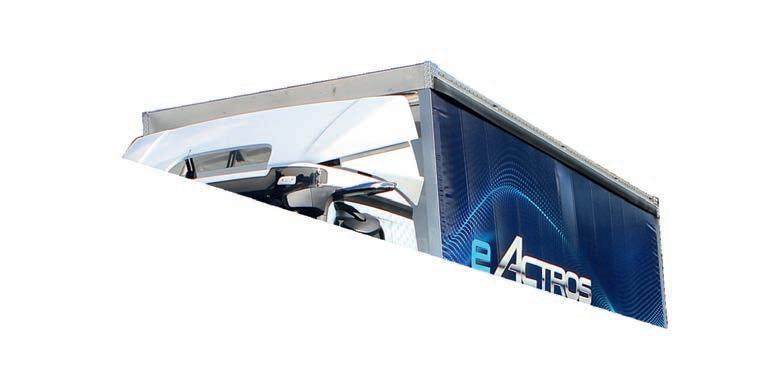

The MercedesBenz eActros 300 will be launched in New Zealand about the time you read this. Keith Andrews Trucks invited us for a silent, powerful, preview drive.
Photos by Earl Edwards and Gavin MyersBuried somewhere in the Journalists’ Toolbox of Essential Field Gear is the humble voice recorder. Today, it doesn’t physically reside in a ‘toolbox’, but is a mobile app hidden in the software of our smartphones. Regardless, whenever we’re out gathering information for a story, you can be assured the round red button on the trusty voice recorder will
get a prod.
The hard work starts when back in the office, listening though sometimes hours of conversation to pick out the nuggets of information and allimportant quotes you eventually read on the page. And when that recorder is running in the cab of a truck, listening back can be a little more difficult with all the background road, wind and engine noise sometimes


necessitating a few re-listens to properly catch what’s been said. Not once did that happen in the two-hour voice recording of myself and Matt Gillatt, Keith Andrews’ product planning manager, as we crisscrossed South Auckland and the surrounding semi-rural roads in the Mercedes-Benz eActros 300 evaluation unit the company has been trialling since the beginning of the year in the



Conversation was almost hushed as we cruised around with an interior noise level reduced by a claimed 10dB, equating to approximately half of the perceptible in-cabin volume – and when you’re experiencing it, you don’t doubt that for a moment.
In fact, listening back to the recording, there was more background noise to the discussions that took place as we walked round the vehicle at the Keith Andrews Wiri branch before driving off. And for the safety of those around the truck, a 60dB Acoustic Vehicle Alert System emits “a bit of a ‘spaceship’ noise”, as Matt describes it, up to 60km/h. “Sometimes, the loudest sound as the truck rolls past is
comments.
However, as we’ve discussed in the past, reduced noise levels inside and out of the truck are not the only advantages in operating an electric truck. So, what else does the eActros offer? It all starts with the name, eActros 300 – 300 referring specifically to the installed battery capacity from the three lithium-ion battery packs. Coincidentally, these offer 336kWh capacity and a range of about 300km.
“Local testing fully loaded has achieved a 300km range, with 20% battery charge remaining,” says Matt. CCS Type2 DC charging up to 160kW is possible, and a charge from 20% to 80% at 150kW takes 75 minutes.
their charging strategy, we ask what they want to achieve, how easy that is to achieve with the truck charged up overnight, or if they must charge up somewhere in the day, and maximising the distance they want to cover. Charging is the same as refuelling. You top it up to do the kilometres you need to do,” Matt explains.
All this is done via the Mercedes-Benz range prediction tool, which accounts for the routes, climate, topography and weights, and maps out the likes of battery consumption, charging, and others. “We’ve calibrated it to New Zealand conditions, and we’re pretty confident with its accuracy,” comments Matt.
In the world of OEM electric

differentiated itself by opting not to drop in an electric motor between the chassis rails, turning a driveshaft and a diff, but to engineer its own eAxle. This incorporates two liquid-cooled electric motors, a two-speed transmission, and the differential in the axle unit.
“It’s a point of difference for us,” Matt says. “An eAxle offers better weight distribution, because we can position the batteries better, and offers more efficient drive with fewer moving parts. It doesn’t affect axle capacities; the eActros offers the same axle limits as a diesel truck would.”
A 4x2 and 6x2 rigid, and 4x2 prime mover, will be offered at launch, all with the same eAxle.
On the point of axle weights,
 The eActros 300 is incredibly easy to drive in traffic, on the motorway or on rural roads. The Acoustic Vehicle Alert System emits a 60dB sound up to 60km/h. Mercedes-Benz’s eAxle incorporates
The eActros 300 is incredibly easy to drive in traffic, on the motorway or on rural roads. The Acoustic Vehicle Alert System emits a 60dB sound up to 60km/h. Mercedes-Benz’s eAxle incorporates

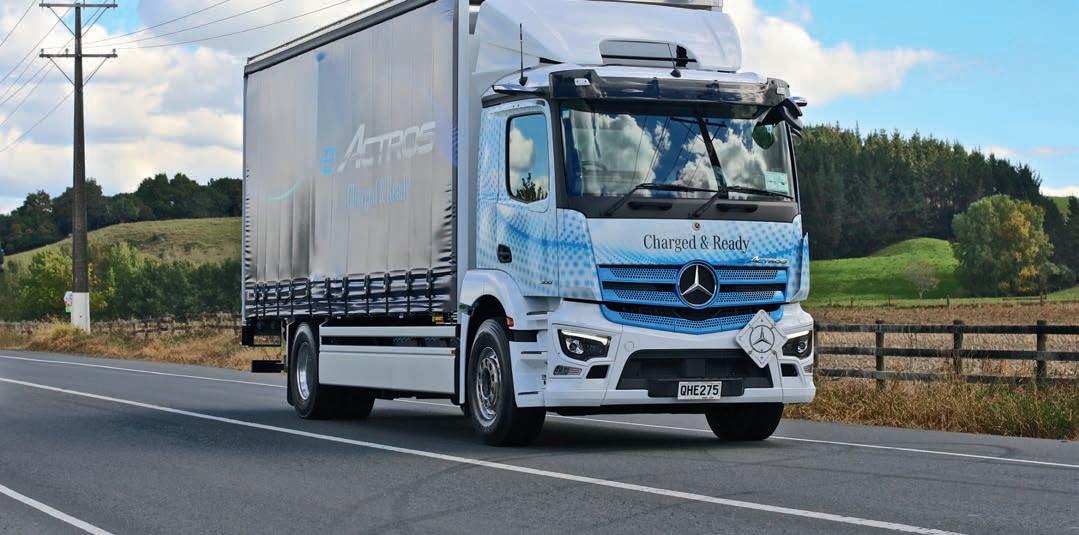


the topic of New Zealand’s VDAM restrictions comes up.
“In Europe, these get an extra tonne [over a diesel equivalent – to make up for their heavier tare weight]. So, this has a 10-tonne tare and a 19-tonne manufacturer’s GVM.” In New Zealand, the VDAM-restricted GVM is 15 tonnes, with a payload of 4.5 tonnes. “Hopefully, we can get to higher weight limits for these trucks,” he adds. Air suspension is fitted all round. Up front, where the engine used to be, is the ‘front box’ which holds the two 12V batteries, an electric steering pump, electric air conditioning pump, and electric air compressor, among other gubbins. Immediately obvious when looking at the truck are
the side-impact protection beams. The eActros complies with the ECE R100 standard for high-voltage vehicles. “The batteries are built and tested to destruction. If it detects an insulation compromise or excessive temperature in the batteries, for example, the system will shut down and it can be placed into a locked-out state. This is not a requirement in New Zealand, but we offer it,” says Matt.
Safety is of the highest priority, he explains. As part of the ‘intrinsic safety for highvoltage motor vehicles’, the eActros features trip wires at the driver’s seat, which the fire service can cut to immediately disconnect the high-voltage system and completely disable
the vehicle if needed, as well as an ‘e-stop’ button within easy reach of the driver, which does the same and can also be used as a high-voltage lockout in the workshop.
However, climbing into the eActros 300’s M ClassicSpace cab (the sole option), the only button I’m interested in is the start button to the left of the steering wheel. With a press, the eActros buzzes into life, the dash lights up and the ‘Ready’ light illuminates in the left-hand dial – now a power meter – on the 10in driver’s display. As we pull out the Keith Andrews Wiri dealership, the eActros takes off with the immediate energy so familiar of electric vehicles. The eAxle offers up 400kW (536hp) peak and 330kW (443hp)
continuous output, and heading toward the motorway, you wouldn’t guess we’re loaded up to max GVM (VDAM).
We’re set up in one-pedal driving mode, meaning lifting slightly off the accelerator will let the truck glide along; lifting off more will engage energy recouperation, slowing you down. The five levels of recouperation are selected by the traditional right-hand exhaust brake wand. When using the brake pedal, the truck slows with recouperation first before getting into the foundation brakes. The pedal travel is long but there’s a lot of ‘braking’ power before the need for the foundation brakes arises – if it does. All the while, the power meter indicates what the



drivetrain is doing and where the energy is going.
It’s not as complicated as it may sound, and the recouperation braking is so natural, you get used to it very quickly. If anything, it’s the acceleration that needs getting used to. There is no hesitation and the eActros jumps off the line if you’re hard on the throttle.
The transmission shifts at 30km/h with a slight pause, and the second ratio carries you all the way to 90km/h. At full highway speed, the wind is the loudest noise (round town, it’s the sound of passing vehicles).
Slowing for traffic on the motorway, I turn off the recouperation and just let the truck roll along using its inertia.
How long it’ll roll for is amazing, too, with no mechanical resistance to fight.
We turn off to tackle the semirural roads around Whitford, Brookby and Ardmore and the eActros is as easy to drive here as a car. We try a hill start, and the eActros steps off and holds first gear until the climb begins to level out, not shifting before it knows the second ratio won’t lose the momentum. Flicking the powertrain into ‘power’ mode unleashes the full 400kW (for a while, in the interest of heat management). Conversely, flicking it onto ‘range’ limits max output and max speed.
Truly, I could’ve driven around for hours playing with all the different driving modes and scenarios.


“Driver training is important with these vehicles,” says Matt. “People have been driving diesel vehicles for a long time, so they get it very quickly when they start driving a new truck. With this, it’s about driving efficiently, using the recouperation to put the energy back into the batteries … Our driver-trainers teach foresight driving, looking as far down the road as you can to make decisions far ahead of time, so that the glide mode and recouperation braking can be used as much as possible. If you’re slick, the brake pedal will be used just for coming to a standstill.”
At launch, the eActros will come with a warranty of six years/360,000km, or 18,000 charge cycles on the batteries,
so operators should have full confidence in the vehicle.
“It’s about bums in seats. We need to show it operates largely like a normal Actros, and it’s easy to drive and comfortable,” says Matt. Other than being electric, it really is Actros as we know it, and that familiarity will surely be an advantage.
“The eActros 600 shows there’s no turning back, it’s designed to be an electric vehicle and it’s quite a way off for our market. The eActros 300 is available to us now. It has its market segment – metro, interregional, golden triangle – and we just need to focus on that.”
An eActros rolling silently up and over the Kaimais? That’s when things will really start getting interesting.
Alex ‘Mac’ McLellan was a colourful, larger-than-life character. He had a big-hearted personality, and always put everyone else’s wellbeing and welfare first. We take this opportunity to celebrate Alex’s life by talking to a few people who worked alongside him, capturing their memories and what Alex’s friendship meant to them.
Jonathan Bhana-Thomson chief executive, New Zealand Heavy Haulage Association
“Alex was a valued member of our board for around six years, and after one of our board meetings we were chatting about a home game for my team the Hurricanes against his team the Highlanders the next day. In the heat of that conversation I made the misfortune of betting against Alex over the outcome of that game. Well, my team lost, and what that meant was that at our annual awards dinner I had to wear a Highlanders jersey for the entire night.
That was a painful thing for me, and Alex was very humble in the way that he did it, but he gloated all the way. For me it typifies Alex, he always carried through with what he said he was going to do. Some people might not have made you do it, but with his sense of humour
and in a funny way he made sure he had a Highlanders shirt there on the night for me to wear. So yeah, I learnt not to bet against Alex after that.
It will continue my pain printing this in the magazine, but Alex will have a wry smile on his face knowing that this episode has not been forgotten.”
Greg Sheehan ‘The Sheriff’ Overdimensional Pilot Extraordinaire
“On a trip to the South Island to deliver a couple of new trucks to Invercargill we dropped in to catch up with Alex at the Balclutha yard. We were welcomed by Alex with a big smile and he proudly gave us a guided tour of the yard. With my history with Mercedes-Benz trucks, Alex made sure I had a drive of a 1418 Merc that he had there.
Later we arrived at the family home, headed into the house and sat down. Alex says ‘would you like a beer?’ ‘Yes please’, and while Alex is getting the refreshments, this big fat cat walks in the back door, I say ‘hello pussy cat’. Alex turns and says ‘that’s SPCA’. ‘What do you mean, SPCA?’ I ask. Alex explained ‘oh, our son Isaiah named him that when he first came in here, because it just arrived as a stray, and Isaiah said to me ‘Dad, some prick’s cat’s arrived’ and that was it, that’s how he got his name’. You can imagine the place erupted with laughter.
Alex and I spent quite a bit of time working on the board of directors of the New Zealand Heavy Haulage Association and eventually I was elected to be
chairman. Alex supported me very well in that role, he gave me a tremendous amount of support and that’s something I will never forget. We had a great time there, a lot of hilarity around the boardroom table at times, just from a quick quip that he might have made, because he was that sort of bloke – anything that you could joke about or see the lighter side of Alex was right there front and centre.”
Nigel Hope Bus Truck Recovery International
“I met Alex through the classic truck runs back in the early 2000s. Alex was very active in the scene; it was a hobby that he really enjoyed. Alex was always good at giving others who did not have a truck one of his so that they could enjoy the rally. That was the measure of the man right there. Yes, it helped keep his trucks moving, but you could clearly see that he really enjoyed seeing others enjoy the hobby as well.
I remember Alex purchased an old tow truck off Huck McCready, and it is fair to say that it really was at the end of its working life. I think Alex purchased it because it was a classic, and it fitted in with his collection. Well, even though it was a classic, Alex still sent it out to do a couple of jobs. We would have to take turns at manhandling and dragging this old wire cable. The guys hated it whenever Alex would suggest they take the old truck out to do a job, because they knew they would end up being the ones who would have to drag the cable out.”
Paul Britton Britton Housemovers
“I served as a fellow board member with Alex on the New Zealand Heavy Haulage Association board. Alex was a savvy operator who had a very good handle on the transport industry, and he was extremely generous with his time and sharing his knowledge. I cannot stress just how much he assisted me with understanding business acumen at our meetings. We would discuss issues and the like that we might be experiencing, and Alex would offer other perspectives and solutions that you perhaps had not thought of yourself. Alex would really listen to what you had to say, he was genuinely interested in how business was going for you. More than he knew, Alex really assisted me in many areas of our own business.”
Ewan Richmond Fire and Emergency New Zealand“In the early days of the business, there were those days that might have started off with a bit of a disagreement, and later in the day he’d always call up on the radio and say ‘where are ya big nose?’ (He always called me ‘big nose’ and I called him ‘conk face’ from out of Monty Python’s Life of Brian – he definitely had a great sense of humour.) I’d be a few minutes away from base, and he’d then say ‘right, I’ll be at the yard, we’ll shoot around to the war office for a debrief’ – and that is what we did, we’d head around to the RSA for a beer, and have a catch up, and put things right. There was no ill feeling. He was one of the nicest


people I have ever had the pleasure of working with, sure we worked hard, we played hard, and he always made sure we had the weekends off. He would say ‘we work hard enough during the week, so go and have the couple of days off’.
Alex was a very big part of my life, he believed in me and helped me see my own potential, and even after I had left the area, Alex always made the effort to stay in touch and see how I was getting on. A true mate.”
 Shona Robertson Road Transport Logistics (RTL)
Shona Robertson Road Transport Logistics (RTL)
“Mac was a loyal man that was passionate about the industry and the people in it. I will always remember Mac for the support he gave me and my colleagues in our roles within the RTA, he was one of my biggest cheerleaders. His practical, wise, advice was always welcomed. His approach was respectful, he took time to understand the issues, he gathered facts and asked questions when
over-spec their new KWs. While his tone was making out he was stern and concerned, his eyes sparkled and there was a grin on his face as he made reference to the extra dollars it cost him – he loved it. He was so proud of Kim and the boys, Mac spoke often about how lucky he was that he got to be back behind the wheel living the dream, and leave them to run the day to day business. Rest easy Mac.”
Wayne Williams Transport Services Limited (TSL)
“Alex could talk to anyone anytime no matter where he was, even when on a bus trip or plane trip. He would chat to the person on the other side of the isle and get to know them, and by the end of the trip be mates.
In a respectful and friendly way he called every woman he met, no matter what their age, ‘girl’. He was caring and loved whanau, he was a great friend to all, and a man who accomplished a lot in his life. He would always do his best to accommodate his clients, he loved his job. He also did his best to help others in the industry, any hour of the day or night, no task was too big or too small for him. He just mucked in and made things happen, that is the calibre of the man.”
James, Tracy and Nelson Yorston
Yorston Transport
needed. If he didn’t agree with you, he made sure his thoughts were tabled, and respected the outcome whether he agreed with it or not. He recognised the need for our industry to look at the future and make changes that will support our members more, as opposed to keep doing things the way they have always been done. He had our back and for that I will be forever grateful.
My last chat over a few drinks with Mac was at the Kenworth 100-year celebration, he was sharing stories with me about his boys and their passion to
“Mac once said to me, ‘If you have good work ethics you provide for your family’. Mac’s work ethic was unbelievable, and he always did it with a smile. He would sort things there and then, not 10 or 20 minutes later.
An example of this was a Saturday morning back in 2022, when we suffered an unfortunate accident with one of the trucks in our fleet. Mac was immediately on the phone to us, saying if we needed anything at all, he will get straight onto it. Heartfelt, genuine and giving, that was Mac.”
Above: Mac’s pride and joy, fleet No.53, gave him precious time back behind the wheel.“So, when we put this Lomas Transport, based out of Kerepēhi on the Hauraki Plains, is a small regional carrier with a preference for Japanese trucks. Its latest addition to the fleet is a neatly styled Giga CYJ 530, a nod to the local area and a great mentor to company owner Tom Lomas.
In trucking circles, few gestures honour a friend and mentor more than naming a truck after them. One way, perhaps, is to go a step further and have them help design the truck’s livery. For Tom Lomas, that person is Allan Green, who took him under his wing more than 20 years ago – and roping Allan in on the new truck was exactly what Tom did when Lomas Transport ordered its new fleet No.6, an Isuzu Giga
CYJ 530 Super-High.
“Greenie and I have been mates since I was a young fella,” says Tom. “He was an O-D at Provincial Freightlines and I was an employee there. While I was busy being cheeky to him in the yard one day, he took me aside and said, ‘If you’re going to learn, you need to learn properly or you can piss off with the rest of them.’ So, I stuck around.
“He must’ve seen a bit of
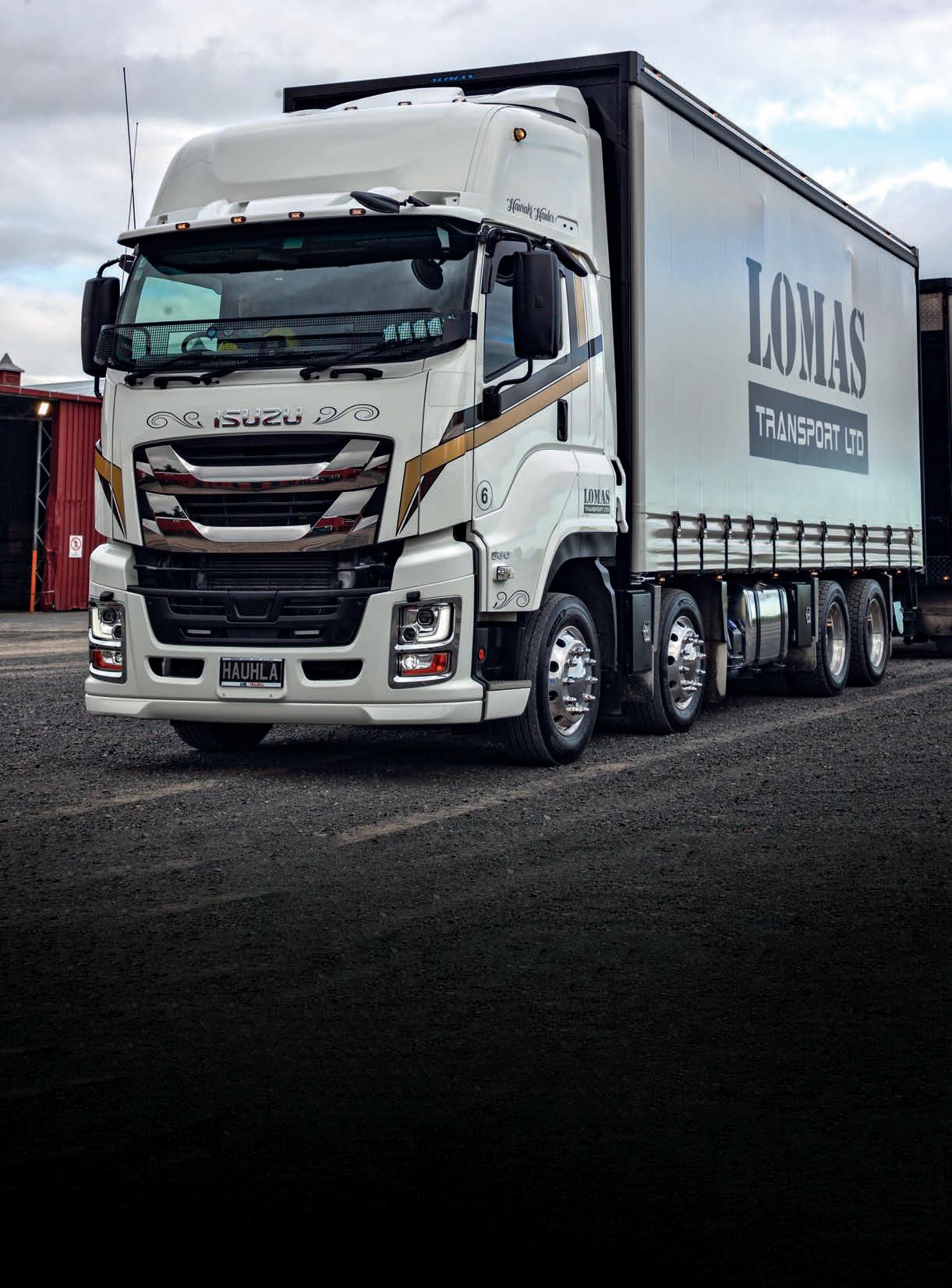
spirit in me and that I was prepared to listen as a young lad. I had a few bits of timber thrown at me over the years, but I dodged enough of them to still be here and still be good mates with him,” Tom laughs.
Twenty years later and with eight trucks in the Lomas Transport fleet, today Allan does a bit of casual driving with Tom “to keep the cobwebs off the logbook”, as Tom puts it.
truck on the road, I asked him, ‘Greenie, how would you like to design this one?’ And he was keen. I wanted black, he didn’t, so we went for dark grey. The gold stripe is a nod to the history of the gold in the Hauraki area.
“Finally, as his company was Hauraki Haulage, we named it Hauraki Hauler with the numberplate HAUHLA. A tip of the cap to Greenie being a good mate and mentor along the way,” Tom says.
The truck was bought through Shane Ward at CAL Isuzu Whāngārei (“Call him ‘The Taniwha’,” laughs Tom), and CAL Engineering built the 7.5m body. CAL Engineering also refurbed the four-axle Domett trailer and extended the drawbar.
“We were permitted to go







Loading up for the run to Auckland.


longer than 20m. For access around the Coromandel Peninsula, we didn’t want a five-axle trailer, so a longer drawbar was the better option. We can also jack-knife it comfortably without butting the unit up.”
Completing the build are Structurflex curtains, a Zepro tail lift, Alcoa Alloys and that all-important signage, applied by Automint Hamilton. “Andrew at Automint … he’s been very good to us, very flexible, and does a great job,” says Tom.
Tom says Isuzu is the preferred brand for the company’s work in the golden triangle. The Giga does regular loads from Claymark Kopu [which kindly allowed
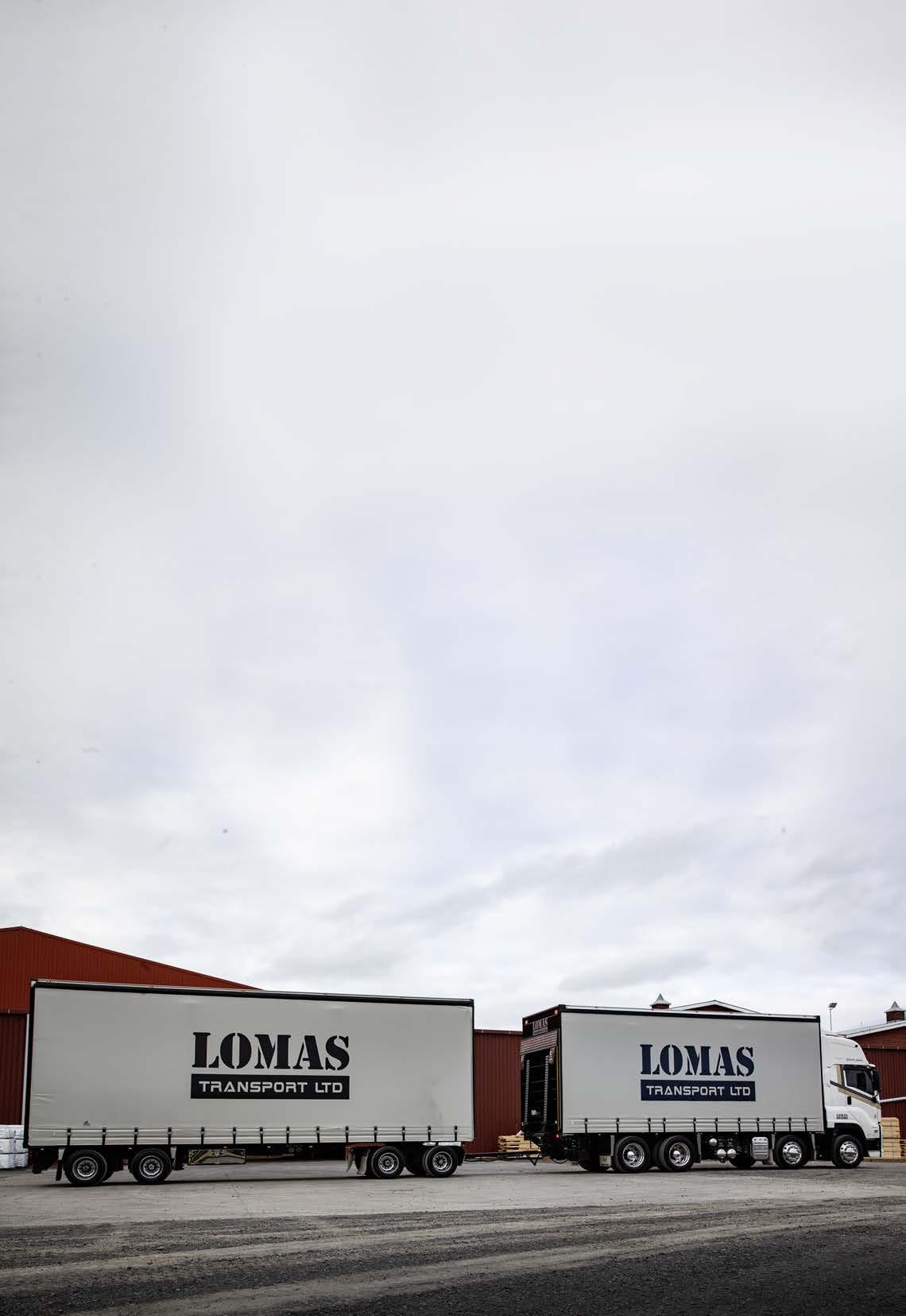
us the use of its yard for the photoshoot] to Auckland, and it will loop the peninsula at least twice a week, volumes permitting. Otherwise, it can be spotted flitting around the wider Waikato, Bay of Plenty and Auckland areas. The main driver on Hauraki Hauler is 31-year-old Graeme Clayton, with Murray Lomas tasked with the second shift.
“I offered Graeme our old R620 Scania, and he chose the Isuzu over that! He was happy to be on the Isuzu,” Tom says.
“I’m really liking it so far. They’re good trucks for the stuff we do around here,” Graeme says.
Graeme’s driven for Lomas Transport for three years now,
having started on one of the six-wheeler Isuzu beverage trucks.
“After leaving school, I did farming before going to Auckland to get a qualification in roofing, which I did for six years. I never thought anything of trucking. When I moved back to Turua, I got a call saying there’s a job at Smart Environmental if I wanted it and got my licence. So, I obtained my Class 2, but working with rubbish isn’t fun. I did that for a year, then went and found a different job for a bit before I found out about a driving job at Lomas through Tom’s uncle, who was our neighbour,” Graeme explains.
“Driving’s where it’s at for me
now, and Tom’s great to work with. He places a lot of trust in us to get the job done, which I like.”
Graeme’s wife, Steph, also does some casual work for Lomas Transport, and their fiveyear-old son Joseph is catching the truck bug by all accounts.
“Joey’s crazy about it. He knows what all the trucks are, and anytime he can come in the truck with me, he will! He loves to grab the CB and try to talk to the guys on the road,” Graeme says. Four-year-old daughter Ana is not quite as enthusiastic, but that might just be a matter of time.
Perhaps one day, they’ll find themselves dedicating a truck to a mentor and friend, too.







It was the shiny trailer wheels that caught Alison Verran’s eye, followed by the 1967 Chevy Impala on the deck.
Glenn “everyone knows me as Plow” Plowright was heading to collect a spotless red 2014 Corvette from a dealership in Te Rapa, Hamilton, when Alison did a quick U-turn to go and say gidday.
Plow has been driving for Express Vehicle Transport for “easy 20 years, I think”. He keeps his 2020 IVECO Stralis 460 EEV looking very sharp. New Plymouth-based, Plow had travelled up to Auckland that day, loading and unloading vehicles around the city, followed by a couple more drop-offs in Hamilton on his return. Then it was back to New Plymouth with these eye-candy cars on the back, which were to be on show at the annual AmeriCARna event.
Plow says he has always loved trucks. “I grew up watching the trucks drive past my school in Bell Block. I used to hang out by the fence and arm-pump them! I was one of five boys. The others all used to wash trucks on weekends, and then I joined in. It’s what we all did back then.
“I went into the panel and paint industry for a few years. Then an opportunity came up

for me to drive for Car Haulage NZ. I drove for another couple of companies after that and then came here. I’ve been driving for about 28 years now. I love driving … as long as I’ve got aircon and sounds, I’m happy.”
Plow is not too keen on the state of our roads, though. “They’re shit,” he laughs. He’s also not happy with some of the traffic management workers. “They’re a joke,” he says, “their vehicles pull out in front of you; they think they’re invincible. A lot of
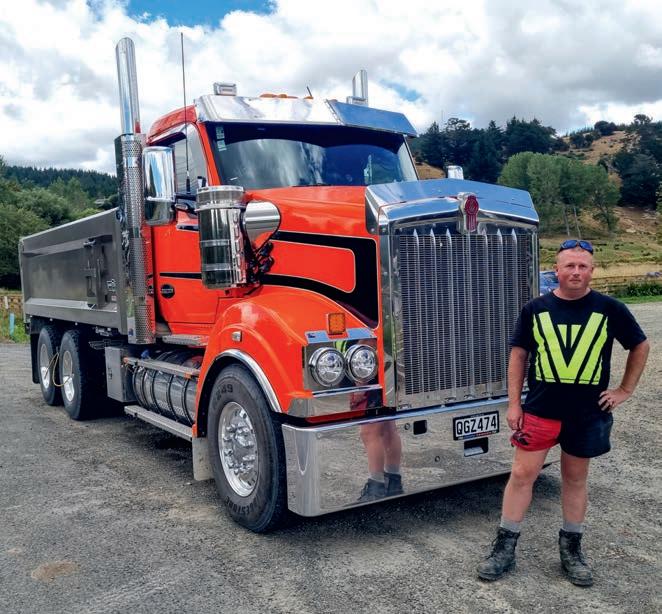
them haven’t a clue how to do their job. It makes you wonder who is running these places. There appears to be a distinct lack of training. Gone are the days you start as a stop/go sign operator, learning on the job and working your way up, therefore knowing the ins and outs of the industry as you go.”
Alison finished the chat with the essential vexing question, “White bread or brown?”
Plow paused for a bit and said, “Molenberg … is that white or brown, though?”
Quyntyn Morgan pulled up behind Rochelle Thomas in the 2023 Kenworth T610 SAR he drives for Kieran Oliver Contracting at a stop/go sign on the way out to Castlepoint Beach, Masterton. When told they could be there a while, Rochelle thought it would be a great opportunity to get a photo!
She hopped out of her ute and asked him if he would be keen. But before long, the road reopened, so they met up at the Tinui Café and Bar.
Quyntyn says the truck is brand new. It had only been on the road a week and done only 2500km. He has been with Kieran Oliver for three years and driving for five and says he chose to go truck driving as a career because trucks are cool.
Quyntyn was on his way to deliver concrete blocks for forestry operations at Erindale, Hawke’s Bay. He said the worst thing about driving is getting the truck dirty – and muddy in winter! His favourite thing about driving is being out and about, seeing the countryside and views.
Quyntyn’s vexing question was the choice between bacon and egg or mince and cheese pie. Mince and cheese it is.

STOP PRESS! Big news since we last rolled down Wheels at Wanaka memory lane. Next year is the last one – the grand finale! This cannot be missed – plain and simple as that.
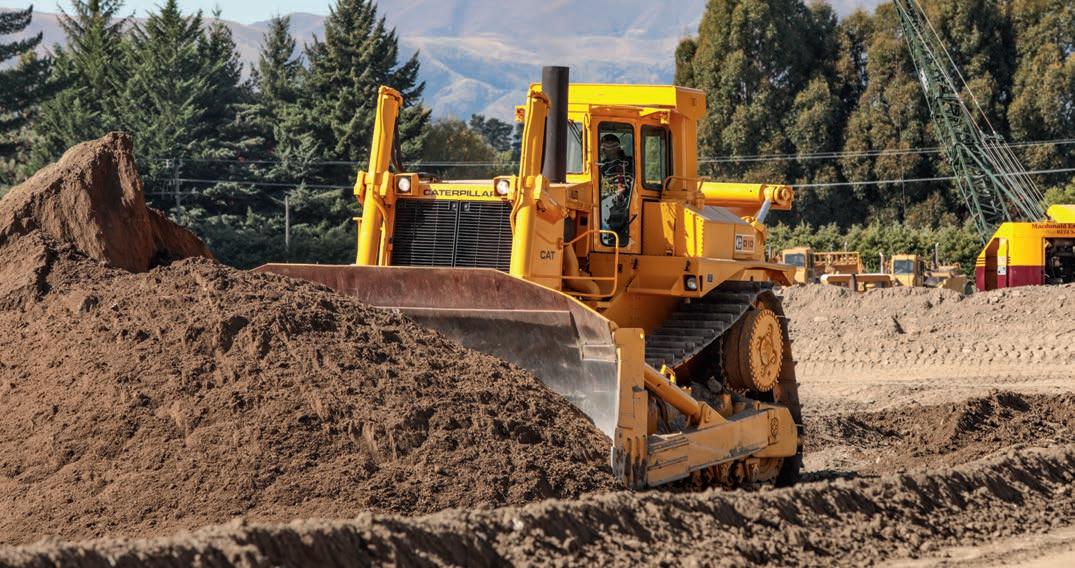
Not the picture I had earmarked but one that demonstrates the enormity of the situation. Paul Clarke pushes everything aside in his Caterpillar D10 84W single stack machine. Not New Zealand new, but all the 84Ws were that little bit special. Like him, you too absolutely have to push everything aside to be at the final hurrah in 2025.



Kiwi truckies might remember JAC, which has had a presence here and across the ditch in the past few decades. Now, the brand has re-entered with real backing from a local automotive juggernaut – and it’s aiming high with a new range of lightduty trucks.
At the end of 2023, JAC Motors New Zealand announced it was on the brink of a launch, with a new range of electric
light-duty trucks going through local evaluation and testing. In March, the company celebrated its official opening and vehicle launch.
It enters the market with some serious backing from NZ Automotive, a subsidiary of Colonial Motor Company. Among the 21 other brands within the Colonial Motor Company stable are Southpac’s Kenworth and DAF truck brands – and that means JAC will leverage Southpac’s network for servicing and logistics of JAC parts. Retail is currently offered through Southern Autos JAC Manakau City in the North Island, and Avon City JAC Christchurch in the South Island.
“We’re proud that JAC can continue to build on the incredible reputation Southpac
has in the industry,” says Andrew Craw, general manager JAC Motors NZ.
“Our partnership with Southern Autos is a little different for a truck brand, breaking the mould for traditional truck sales by offering Kiwis the opportunity to be fully supported by a more traditional vehicle dealership experience. We see this as a great option for some of the smaller businesses that may only have one or two trucks, and want a team that can do the heavy lifting for them in the transition to EV.”
Speaking at the Southern Autos launch event, Jason Robb, dealer principal Southern Autos JAC, adds: “We feel we can be more flexible. With EV trucks, there is a lot more to it than just selling the truck. We’re adopting

a more consultative approach and working hard on customer experience, whether someone’s after one truck or 100.”
JAC Motors was established in 1964 and currently employs 33,000 staff across 130 countries. In December 2022, it entered a joint venture partnership with VW. It has an existing joint venture with Cummins, a 50/50 auto finance company with Spanish Santander Bank, and has entered a joint corporation with Huawei to develop smart EVs.
Representing JAC Group at the launch, Mr Xiang explained that in 2023, JAC had a total sales volume of 592,000 units (of all kinds of vehicles), with an 18.4% year-on-year increase. It exported 250,000 vehicles, a 60% year-on-year increase, to 132 countries. The company
 The interior seems good quality and comfortable.
JAC has tested the new models to a range of 200km. Photo: JAC.
The interior seems good quality and comfortable.
JAC has tested the new models to a range of 200km. Photo: JAC.

invested CN¥2.2 billion (NZ$514 million), or 5% of revenue, in research and development. In 2024, it plans to up this to CN¥4.5 billion ($1.052 billion), 8-9% of revenue. In the next five years, R&D will exceed CN¥20 billion ($4.677 billion), with more than 30 products planned.
“New Zealand is a highend strategic market for JAC. New energy vehicles play an important role and more and more operators are choosing low-carbon, green, intelligent, efficient solutions. Based on a deep understanding of commercial vehicles, we bring two high-end, intelligent EV truck products that represent JAC’s R&D results in advanced motors with low power consumption, and electronic control systems and driver assist

systems,” Mr Xiang said.
The first trucks to launch are three of the brand’s electric light-duty models, with Cummins-powered diesel units currently undergoing compliance testing. These will be fitted with Cummins 3L and 4L engines with manual and automatic transmissions in sixand nine-tonne GVM versions. Further details on these will be released in time.
As for the new electric models, buyers have a choice of the N60EV, N75EV and the N90EV, with the ‘60’, ‘75’ and ‘90’ alluding to the three GVM options.
According to James McAllister, truck sales at Southern Autos JAC, the nine-tonne unit offers the heaviest GVM among current light electric trucks. With tare weight ratings of 3150kg to
3370kg, buyers can expect fair payload ability. Wheelbase options range from 3365mm to 4475mm. Buyers can also select from various turnkey models fitted with locally supplied decks and bodies.
Two permanent-magnet synchronous motors are offered, with 65kW/415Nm rated and 130kW/1200Nm peak outputs, or 90kW/550Nm rated and 171kW/1050Nm peak outputs. These drive through a twospeed FAST transmission. Only one battery option is available – a liquid-cooled CATL lithiumiron phosphate battery pack of 106.95kWh capacity. JAC Motors has tested the trucks in Auckland and claims a loaded range of 200km. Operators can expect a fast charge time of 48 minutes from 20% to 80%.

“We’re focusing on last-mile businesses – 200km should be enough for a day with overnight charging. We’re taking a consultative approach to charging; we’ll learn how the customer intends to use the truck, if they need charging solutions installed, what the best solution is. Understanding their business also applies to advising them on the right vehicle. If diesel is better for them, we’ll tell them.
“The JAC Motors website even has a calculator that will indicate which is the better cost option,” says Andrew.
These may be light-duty trucks, but they are not light on tech, especially regarding safety. Offered standard is advanced driver assistance system (ADAS), advanced emergency braking (AEB), lane-departure warning system (LDWS), hill-start assist (HAS), electronic stability control (ESC), dual airbags, a reverse camera, and automatic lighting with LED daytime running lights.
An automatic circuit breaker cuts battery power in the event of a collision, and a high-voltage interlock detects potential loose high-voltage connections and alerts the driver or technician when working on the vehicle.
An 8in touch-screen infotainment system is fitted, and an electric drive selector and electric park brake differentiate the cabs of the electric models. Initial impressions of cab comfort and quality are good, and we at New Zealand Trucking will be interested to see how the whole package comes together when we test-drive the trucks in the coming months.
JAC Motors New Zealand is backing its new EV range with a five-year/200,000km warranty.
Ashleigh Waugh, chairman of Colonial Motor Company, concludes: “We’re excited about this brand and this opportunity. It adds a significant portfolio to our business in the short term, and in the medium term, it has the potential to become a significant part of our business.”
Three models will be offered, six, 7.5 and nine-tonne GVM.




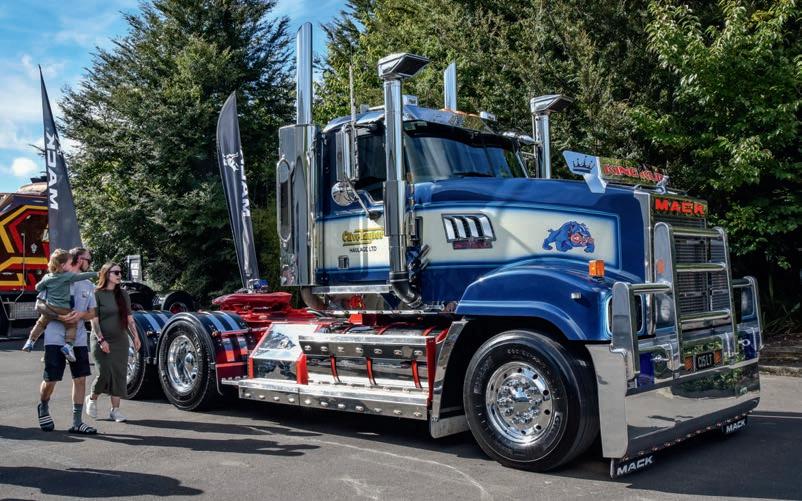

Fine weather, fine trucks, and fine beer – it can only be the Tui truck show!
There’s something about the Tui truck show that seems to guarantee fine weather, and this year was no exception. A total of 110 trucks registered for the event, a little down on the previous two shows but still a good turnout of trucks from near and far. About 500 spectators enjoyed the live music and display of gleaming trucks, including two mature ladies who said they came along for the first time because they’ve always loved trucks.
Jesse Robinson from event organiser The Experience Collective said this year the event was focused on appreciating the truckies, “owners and drivers, who make so much effort to prepare their trucks and bring them along to share with us all at the show. The rigs were impressive. We were overwhelmed with the amazing sponsors who came on board this year; the prizes were awesome, and we hope they made it worthwhile for our truckies.”
The $1100 raised from registration fees will be donated to maintenance at Mangatainoka Reserve via the Mangatainoka Reserve Restoration Project.
Robinson thanked the sponsors: Auto Art by Rochelle; Commercial Fleet Services; Bowden’s Own Premium Car Care New Zealand; Repco New Zealand; Kiwi Shine WorX; Supreme Automotive Refinishers; MyTrucking; Volvo Trucks Palmerston North; Mack
The immaculate LT Super-Liner of Clive Taylor Haulage, a deserved Star of Show and Best American winner. Best Image went to the Mills 1974 Kenworth W924. Beale Trucking was awarded Local Star.Trucks Palmerston North; Total Truck Spray; Kiwi Fleet Wash, and Penske Palmerston North.
This year, the judges noted why they chose each winning truck, illustrating the hard work that went into their decisions.
The immaculate 2005 Mack Super-Liner driven by Andy Maynard from Clive Taylor Haulage won Best American award and also the Star of the Show, named in memory of Pahiatua truck driver Lincoln Johanson, who died in February 2018. The judges said the SuperLiner was in incredible condition for a working truck. “It’s an awesome truck, well presented, and he gets the kids involved.”
In addition to a painting of his truck by Auto Art by Rochelle, he received vouchers and prizes from Tui Brewery.
This year, there was a prize for the Most Original, which went to Johnny Burling’s 2012 Peterbilt. The judges praised the attention to detail inside and out and said it was an “old truck, but looks better than new”. The prize was a custom-made brazier.
The People’s Choice went to PTS Logistics’ 2005 Mack SuperLiner, well known for previously being part of the Menefy Transport fleet, owned by the late Bryan Menefy.
The Best Fleet went to Dannevirke Transport, showing the effort put in to ensure the trucks looked as good as they could on the day. The judges said they were “clean as can be for working stock trucks”.
Local Star again went to Beale Trucking, the company always turning up to support the show. The judges commented that its trucks were always extremely well kept.
Best Image went to Justin and Allen Mills’ 1974 Kenworth with its “amazing artwork, polished like a mirror”.
Taking a break from milkcollecting duties for the day was a 2018 Volvo FM540 Fonterra milk tanker. Fast approaching the million-mile mark, the truck still looked immaculate – a credit to the drivers assigned to it.
Next year’s event is scheduled for 30 March 2025.

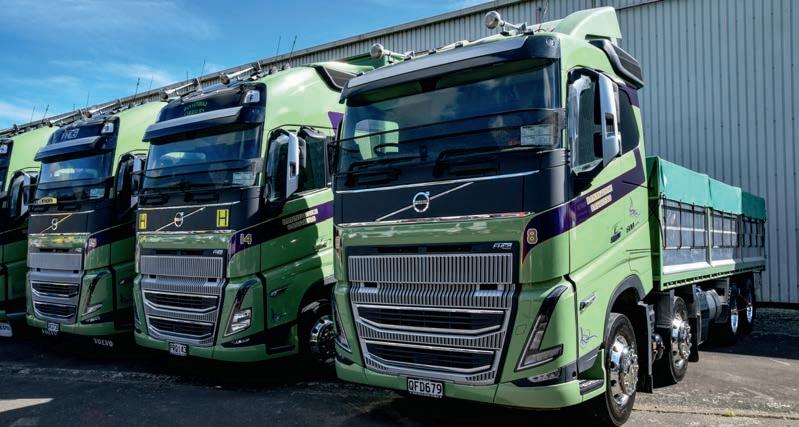




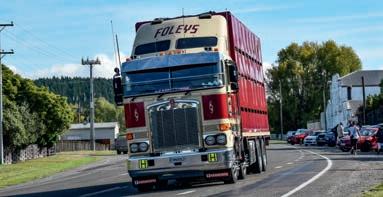
 People’s Choice went to another LT Super-Liner, this one entered by Jarvis Miller, PTS Logistics.
Dannevirke Carriers was awarded Best Fleet.
Best Japanese: The Wairarapa Scrap Metal Hino 700. Peter Bennett’s Bedford J1 took out Best Other.
People’s Choice went to another LT Super-Liner, this one entered by Jarvis Miller, PTS Logistics.
Dannevirke Carriers was awarded Best Fleet.
Best Japanese: The Wairarapa Scrap Metal Hino 700. Peter Bennett’s Bedford J1 took out Best Other.




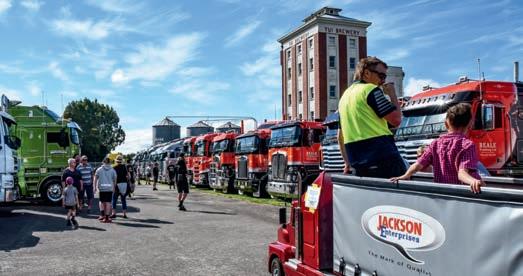
STAR OF THE SHOW, sponsored by Auto Art by Rochelle 2005 Mack Super-Liner LT – Andy Maynard, Clive Taylor Haulage
PEOPLE’S CHOICE, sponsored by Kiwi Shine WorX Masterton 2005 Mack Super-Liner – Jarvis Miller, PTS Logistics
BEST FLEET, sponsored by Total Truck Spray Palmerston North and Kiwi Fleet Wash – Dannevirke Carriers
LOCAL STAR, sponsored by Bowden’s Own, Repco and Kiwi Fleet Wash – Beale Trucking
MOST ORIGINAL, sponsored by Jackson Enterprises 2012 Peterbilt 388 – Johnny Burling
BEST IMAGE, sponsored by Supreme Automotive Refinishers Masterton 1974 Kenworth W924 – Justin Mills, Allen Mills and Son
BEST AMERICAN, sponsored by Commercial Fleet Services Winner: 2005 Mack Super-Liner LT – Andy Maynard, Clive Taylor Haulage
Runner-up: sponsored by Mack Palmerston North 2024 Kenworth W900 SAR – Callum Tews, HOG Haulage
BEST JAPANESE, sponsored by Total Truck Spray Palmerston North Winner: 2023 Hino 700 – Janice O’Brien, Wairarapa Scrap Metal Runner-up: 2022 Fuso Shogun – Soraya Gommans, BBT Logistics
BEST EUROPEAN, sponsored by Volvo Palmerston North Winner: 2023 Scania R tow truck – Willy Matson, Cox Heavy Haulage Runner-up: sponsored by Penske New Zealand 2024 Scania R620 – Brett MacDonald, MacDonald Contracting
BEST CLASSIC (20 to 40 years), sponsored by Commercial Fleet Services Wairarapa
1976 R-model Mack – Kerry Mather, Black and Gold Mack
BEST VINTAGE (40+ years), sponsored by Total Truck Spray Palmerston North and Kiwi Shine WorX 1968 Kenworth W924 – Bruce Tucker
BEST OTHER, sponsored by MyTrucking 1966 Bedford J1 – Peter Bennett
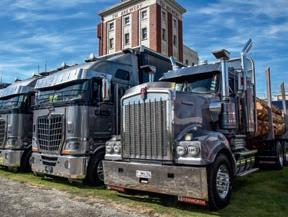

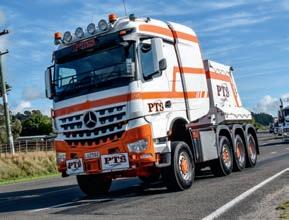

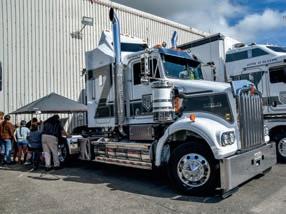

 Cox Heavy Salvage Scania R650 XT won Best European.
Kerry Mather’s 1976 R-model Mack won Best Classic.
The 1968 Kenworth W924 of Bruce Tucker, Best Vintage.
Cox Heavy Salvage Scania R650 XT won Best European.
Kerry Mather’s 1976 R-model Mack won Best Classic.
The 1968 Kenworth W924 of Bruce Tucker, Best Vintage.

We’re incredibly proud to be voted #1 in safety in NZ Trucking magazine 2023 national trucking survey. From stronger cabs, to smart emergency brakes, to side-detection alerts, our focus is always on the best possible protection for our drivers and fellow road users.


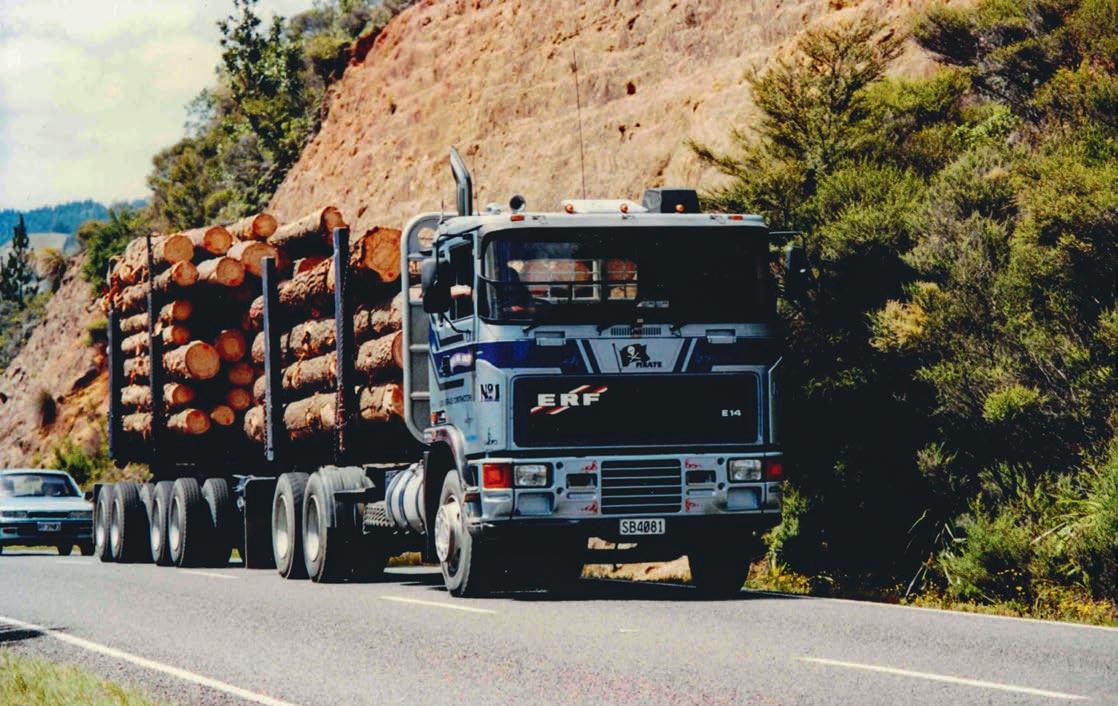
Ken Angus pre-AZTEC, captured here climbing the Stadia hill on the eastern flanks of the Coromandel in his E Series ERF, The Pirate, in 1994. A 405hp Cummins and 15-speed Roadranger, with Rockwell diffs and Hendrickson rubber block suspension made up the truck’s vital statistics, and it ran Kraft log gear. A lot more lay ahead for this top-bloke than just the road.






Everything you need to keep you going on the road.
Trucking industry news and interviews | Roading Reports with Kiwi Truck Tyres | UDC Business of Trucking with Cameron Bagrie | Sport with Clint Brown | The Brolube and AC Filter Fishing Report with Mark Kitteridge | Clean Co Truck Wash Weather Report | News on the hour | And the best classic rock and country music!







Drivers need to keep learning and adapt to changes in the transport sector or risk being left behind, says Royce ‘Jumbo’ Te Huia.
Jumbo Te Huia is part of the iconic Coromandel Te Huia family, who have been in the transport sector for over 40 years. He currently drives for Chris Angus Transport and has completed a range of training with MITO.
“I got involved in transport because my whole family is involved in transport, and we are all truck drivers,” Jumbo says.
“My father was an ownerdriver, and it all escalated from there.”
Jumbo says that when you’ve been working as a driver and in transport for such a long time, some people might think that extra training wouldn’t be beneficial.
“Because you’ve driven for so long, you think you know everything, but you don’t,” he says. “When you start going through all the courses with MITO and all the scenarios that come up, you realise there’s a lot there you might not know.”
Jumbo says that while it may have taken some time, older and more experienced drivers are becoming more open to doing extra training.
“If you don’t move ahead with the new technology and new protocols that are happening, you might not even be in the game of being a truck driver. You’ll just end up stubborn and angry, and you’ll be left behind.”
Jumbo said the training helped him change the way he did things.
“A lot had to do with being a bit more patient and knowing all the different laws that apply to your operations,” he says.
“Knowing all the safety aspects about your job is
probably one of the most important things you can learn. Safety is a huge thing for logging; it’s massive. That’s why completing training is important, not just for new drivers but also for drivers like me who have been doing it for a long time. It is a good reminder not to take things for granted.
“When you’ve been doing the same job for a long time, you can get into a mode of, ‘Oh. I know this, and I know that’. But things have changed; things are always changing. You’ve got to be prepared for these changes, and training will help you with that.
“These days, we’ve got all this new technology in our trucks – cameras looking at your eyes and devices checking your heart rate. You’ve got to make sure you are managing everything properly.”
Jumbo says training is important to attract younger people into logging, because
the rules now mean they aren’t allowed to ride along on the job.
“I was virtually born in the truck. We lived in a truck,”
Jumbo says. “You can’t take kids in trucks anymore, so they’re not experiencing it young. You can’t take young people into the port, or onto a mill site. That really needs to change if we are going to get young people into logging.”
Jumbo was the 2023 Log Truck Driver Excellence Award Winner, something he says was a great achievement.
“As well as driving the truck, I’m also a driver-trainer and the operations manager for Chris Angus Transport. If there are new courses that come up, I’ll do them. I’m always looking to improve and get ahead and things like that.
“You’ve always got to try to improve where you can, especially if you can make things a lot better for fellow drivers.”

New Zealand Certificate in Commercial Road Transport (Heavy Vehicle Operator) (Level 3)
This programme will provide you with the skills and knowledge to safely and competently operate heavy rigid vehicles or heavy combination vehicles. This programme goes beyond vehicle licence requirements to enable improved job performance and enhanced employment opportunities – whether you’re new to the commercial road transport industry or an existing heavy vehicle driver.
Enrol at mito.nz/hvo
New Zealand Certificate in Commercial Road Transport (Specialist Driver) – Transportation of Logs (Level 4)
This programme provides heavy vehicle drivers with the skills and knowledge required to safely and competently operate heavy combination vehicles, to ensure the efficient transportation of logs.
Enrol at mito.nz/logtransport

MITO is a business division of Te Pūkenga – New Zealand Institute of Skills and Technology. We support on-job learning and career development for the automotive, transport, logistics and extractive industries.
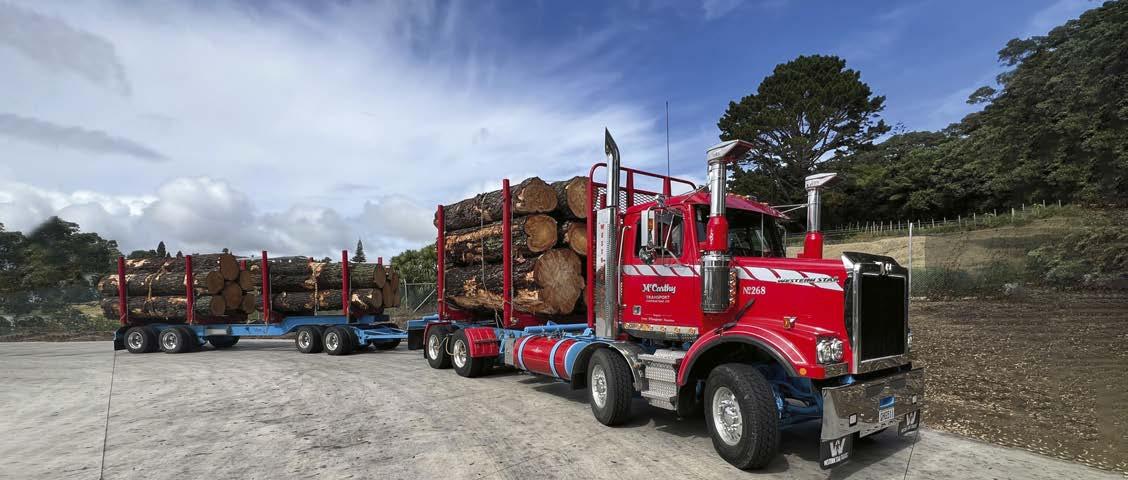
OPERATOR: McCarthy
Transport, Wanganui
ENGINE: Cummins X-15
15L 373kW (500hp) 2508Nm (1850lb/ft)
TRANSMISSION: Eaton
Roadranger RTLO22918B 18-speed manual
REAR AXLES: Meritor RT46160
REAR SUSPENSION: Airliner air suspension
BRAKES: Drum. ABS, EBS
SAFETY: ABS, EBS
BODY/TRAILER: New McCarthy log gear on truck,
International 9870 T6 6x4 tractor – Sky Roof sleeper
OPERATOR: Tranzstar Freighting, Rolleston
ENGINE: Cummins X-15 15L 410kW (550hp) 2508Nm (1850lb/ft)
TRANSMISSION: Eaton UltraShift MXP 18-speed AMT
REAR AXLES: Meritor RT46-160
REAR SUSPENSION: International IROS
BRAKES: Drum. ABS, EBS
SAFETY: ABS, EBS
FEATURES/EXTRAS: Alloy bumper, fridge, stand-alone aircon, hydraulics
PAINT: Factory
OPERATION: New Zealand-wide general and oversize freight
DRIVER: Reece Etwell
SALES: Shaun Jury

4 x Western Star 4884FX 8x4 rigid –day cabs
refurbished McCarthy trailer
FEATURES/EXTRAS: Flat
Texan bumper, stainless steel bug deflector
PAINT: Slippers Refinishing, Wanganui
SIGNAGE: Autostripes, Wanganui
OPERATION: Log transport throughout central North Island
DRIVER: Andy
SALES: Mitch James
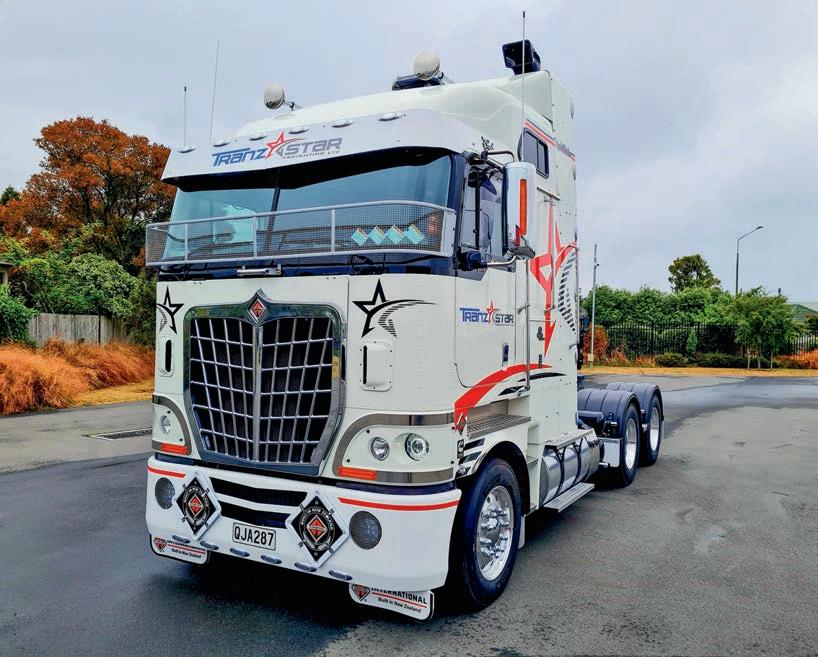

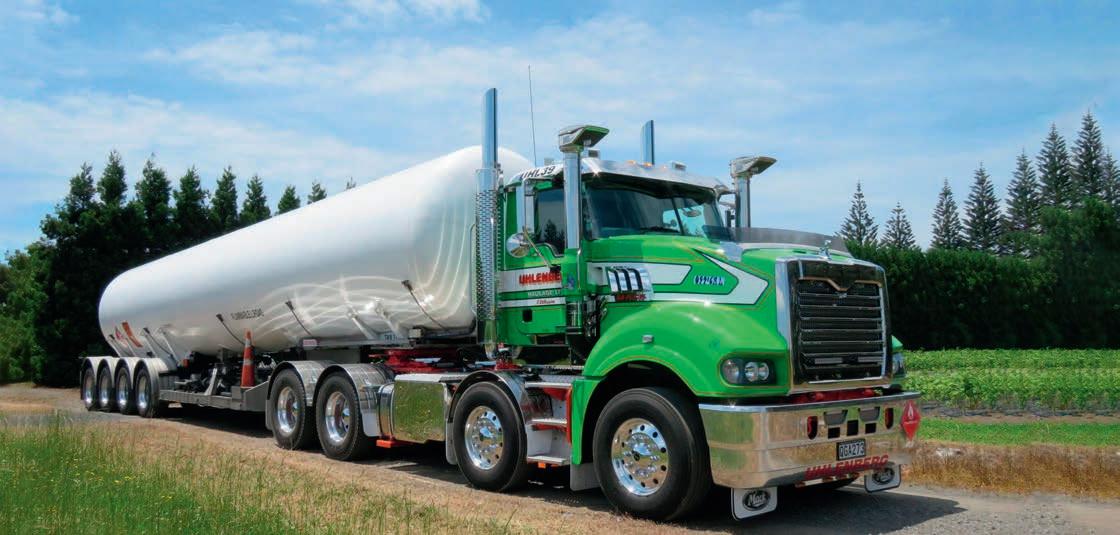
OPERATOR: Uhlenberg Haulage, Eltham ENGINE: Mack MP10 448kW (600hp) 2800Nm (2065lb/ft) TRANSMISSION: Mack M-Drive 12-speed AMT
REAR AXLES: Meritor RT46-160GP REAR SUSPENSION: Mack air ride
BRAKES: Disc. ABS, EBS
SAFETY: ABS, EBS
Mack Super-Liner CLXT 8x4 tractor – day cab
BODY/TRAILER: Lowes 44kL bulk LPG tanker
FEATURES/EXTRAS: DG spec, PTO hydraulics, drive cam PAINT: Factory
SIGNAGE: The Sign Shop, New Plymouth OPERATION: Bulk LPG deliveries throughout the North Island DRIVER: Clayton Haakma SALES: Grant Moody


OPERATOR: Midlands Rural Transport – ‘Jack Turner’ livery ENGINE: Scania DC16 16L
Euro-6 574kW (770hp) 3700Nm (2729lb/ft)
TRANSMISSION: Scania Opticruise GRSO926R 12-speed AMT with 4100D retarder
REAR AXLES: Scania RB735 hub reduction
REAR SUSPENSION: Scania air suspension rear – spring front
BRAKES: Disc, ABS, EBS
SAFETY: ABS, EBS, AEB, ACC BODY/TRAILER: New Kraft Engineering truck deck with
Scania 770S B8x4NA 8x4 rigid –sleeper cab
refurbished Nationwide crate, new five-axle Kraft livestock trailer and Nationwide crate
FEATURES/EXTRAS: Scania scales, fridge, coffee machine, microwave, V8 leather trim, overnight A/C unit, CTI, Alcoa Dura-Bright alloy rims all around PAINT: Fleet Image
SIGNAGE: Caulfield Signs and Graphics, Rotorua OPERATION: Livestock cartage in and around the King Country
DRIVER: Anthony Mott
SALES: Callan Short



OPERATOR: R and R
Transport, Gisborne
ENGINE: UD G11TD 343kW (460hp) 2250Nm (1659lb/ft)
TRANSMISSION: ESCOT-VI
12-speed AMT
REAR AXLES: Meritor hypoid

with cross locks
REAR SUSPENSION: UD
eight-bag air suspension
BRAKES: Disc. ABS, EBS
SAFETY: ABS, EBS, ESC, LDW, LCS, ACC, EBA
BODY/TRAILER:
UD Quon CG32 460 8x4 rigid –day cab
Specialist, Wiri
FEATURES/EXTRAS:
Polished alloy wheels, Airplex air deflector, side skirts and sunvisor, stone guard, roofmounted 9in Big Red LED
OPERATION: Night freight between Gisborne, Napier and Palmerston North
DRIVER: Rahul Rahul SALES: Nigel McFadyen


OPERATOR: Galvanising
Hawke’s Bay (GHB)
ENGINE: Scania DC13
13L Euro-6 302kW (410hp) 2150Nm (1585lb/ft)
TRANSMISSION: Scania
GRS895R AMT with 3500 retarder
REAR AXLE: Scania R780
REAR SUSPENSION: Scania
air suspension rear – spring front
BRAKES: Disc. ABS, EBS
SAFETY: ABS, EBS
BODY/TRAILER: Kraft
Engineering custom two-axle
SALES: Callan Short Scania P410 A4x2NA 4x2 tractor – sleeper cab
semi-trailer FEATURES/EXTRAS: Factory fitted turntable, custom chassis covers PAINT: Factory
OPERATION: Bare steel and galv finished product throughout the North Island
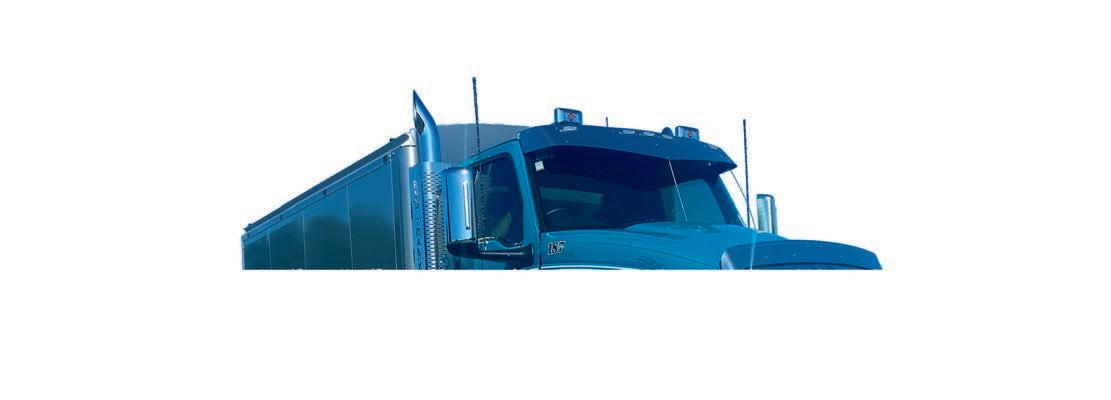
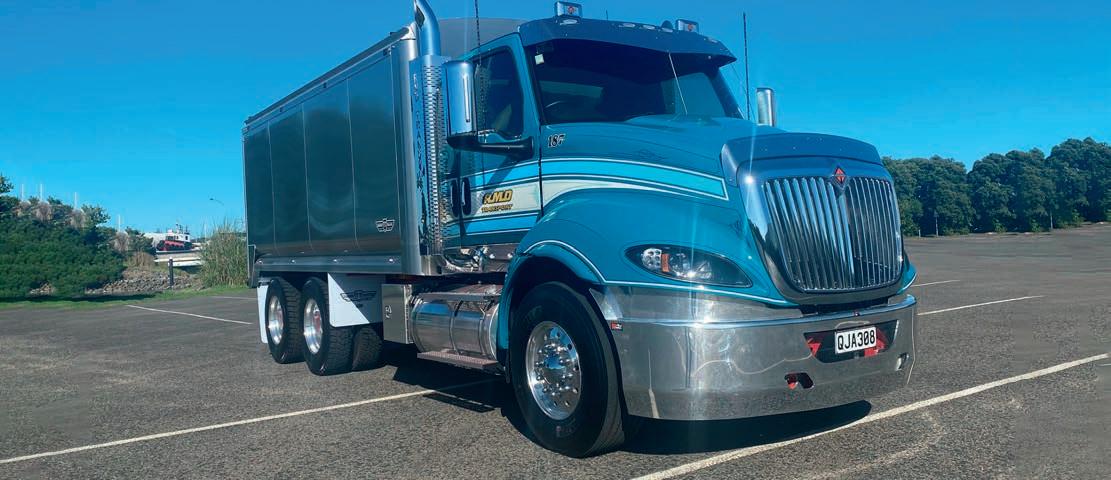
OPERATOR: RMD Transport, Tauranga
ENGINE: Cummins X-15
15L 459kW (615hp) 2779Nm (2050lb/ft)
TRANSMISSION: Eaton
Roadranger RTLO20918B 18-speed manual

OPERATOR: T and J Charlton Transport, Taupo
ENGINE: Cummins X-15
15L 459kW (615hp) 2779Nm (2050lb/ft)
TRANSMISSION: Eaton
Roadranger RTLO22918B 18-speed manual
REAR AXLES: Meritor RT46160GP
REAR SUSPENSION: International IROS
BRAKES: Drum. ABS
SAFETY: ABS
BODY/TRAILER: Transport & General Transport Trailers tipper
body and matching five-axle trailer
FEATURES/EXTRAS: Ali Arc polished front bumper, stainless steel drop visor, Premium-Plus interior trim, twin fuel tanks, twin exhaust stacks
PAINT: Factory
OPERATION: Fertiliser deliveries throughout the North Island SALES: Jarod Maclennan
REAR AXLES: Meritor MT21165GP with full cross locks
REAR SUSPENSION: Kenworth Airglide 460 air suspension
BRAKES: Drum. ABS, EBS
SAFETY: ABS, EBS
BODY/TRAILER: Logging
Kenworth K200 8x4 rigid – flat roof sleeper cab
equipment and matching fiveaxle trailer by Patchell Industries
FEATURES/EXTRAS: Big Foot
CTI, SI Lodec scales, Malcolm Cab Solutions stainless steel work, BroLube auto greaser
PAINT: Cab: Fleet Image, Hamilton. Chassis: Patchell
Industries SIGNAGE: Fleet Image, Hamilton
OPERATION: Log transport throughout central North Island
DRIVER: Justin McDonnell SALES: Tim Finlay






New Zealand has a rich heritage of body and trailer building, and we’re proud to showcase some recent examples of Kiwi craftsmanship every month. To feature on these pages, send a photo, features and the manufacturer’s name to carl@nztrucking.co.nz.
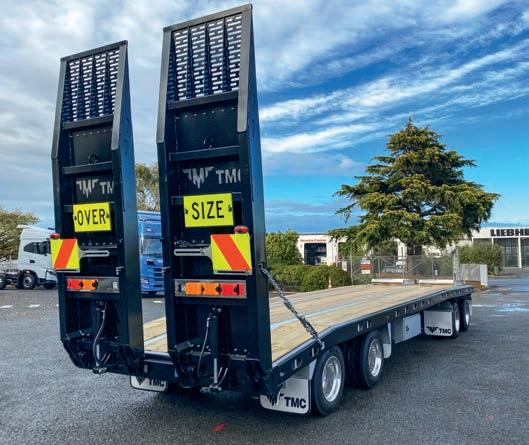
A new four-axle plant trailer was the requirement for PCL Contracting of Porirua. All it took was a catchup with the team at TMC Trailers of Hornby, and the wheels were turning on the build. It features multiple anchor points, as well as front-mounted foldover alloy load-through ramps, allowing access to the deck of the truck.
Running on 17.5in ROR drum brake axles on Weweler air suspension, the combination is completed with Xinfa polished alloy wheels.
FEATURES: 3200mm long x 1000mm wide rear loading ramps, adjustable over-width signs with warning lights, tool lockers. TMC Trailers, Hornby
A new K200 for Green Transport of Taupō has just received a bulk-bin wood fitout at MillsTui’s Rotorua workshops, and the finish is outstanding.
Starting with a Mills-Tui F135 tipping five-axle trailer, matching bins were constructed with the truck bin fitted with hydraulics and winch for self-loading of the trailer.
Narrowed ROR axle sets on air suspension keep things running down the road, with Knorr-Bremse EBS keeping things safe and stable.

FEATURES: Hella lighting throughout, CTI. Mills-Tui, Rotorua
Since 1953

A high-cube solution to service chipliner duties for Symons Group came off the drawing board at Mills-Tui of Rotorua. The starting point was a Mills-Tui F195 alloy clip panel X-treme Wide Belt ejector trailer with
a matching tipper body for the truck. Both are fitted with PowerTarp semiwet-weather electric tarps. The trailer runs SAF air-suspended axle sets with Knorr-Bremse EBS to keep stability down the road in check.

FEATURES: Pacific load cells, Bigfoot CTI system, custom tool lockers, Bridgestone tyres. Kraft Engineering, Rotorua

The premier name in the world of truck and trailer wheels
Delivering the great professional look of a wheel in combination with significant weight saving benefits and the strength of a quality forged aluminium wheel makes ALCOA Wheels stand above the rest.
FEATURES: Peterson LED lighting package, access ladders, custom stainless-steel light bar infills.
Mills-Tui, Rotorua
Middle Hills Contracts from Central Hawke’s Bay needed a logger package for a new T909 in its fleet. It was straight over to the team at Kraft Engineering to work its magic, and the resulting build is nothing short of hot!
The five-axle trailer runs Hendrickson INTRAAX airsuspended disc-braked axles, with a Wabco braking system keeping progress in check.
A custom headache rack with KW bug cutout, loads of polished stainless steel as well as Peterson LED lighting, make the unit pop day and night.

The first inductee into the Bridgestone Million Mile Club this month is smoking hot – literally! Now owned and operated by The Big Smoke BBQ Company of Mt Maunganui, it is used to haul the company’s equipment to catering jobs. Originally new to Balle Brothers, the 1993 K100E Kenworth runs a 3406e Caterpillar with 18-speed Roadranger transmission.
When the truck was built new, it was smack dab in the middle of a creative era where all manner of configurations were explored to find perfect axle loading. Fair to say that at times some bizarre combinations graced our highways; the K100E with set-back axles really was one of those questionable designs. However, according to all who drove this variant of the cabover Kenworth, the verdict was always the same – it rode and handled extremely well. At some stage in its life the truck received a makeover, and at this time, the axles were pushed forward to the standard location.
Ex-truck driver turned BBQ guru Mike Jeffries comes clean on how he got to own the Wingman. “Yeah, I suppose you could say it was my midlife crisis,” he says with a laugh. “But seriously, it really is exactly what we need for the business; the amount of gear we take to a venue now for some of these larger events is
huge. So, yes, the deck space gets well used, and we tow the big BBQs behind it.”
The truck was in great condition when Mike purchased it. “It is a credit to the drivers before me that the interior was in great shape; it had been well looked after,” he explains. “We did a lot of work to it to make it what we needed. Tri-Dek Engineering built the new deck for it, Fleet Image in Hamilton gave it a fresh paint job, and Marty’s High Performance
Signs gave it the look. Everyone’s done a great job, it has come up real good. We’re very happy with it. We have some plans and ideas for future additions; a possibility is a mobile home kind of body on it, like an oversized limo so we can do things like craft brewery tours, cruise ship tours and brides’ hens nights … that 1980s porno look, deep-buttoned vinyl, easy clean,” Mike says with a laugh. Keep us posted, mate, we can’t wait to see it.


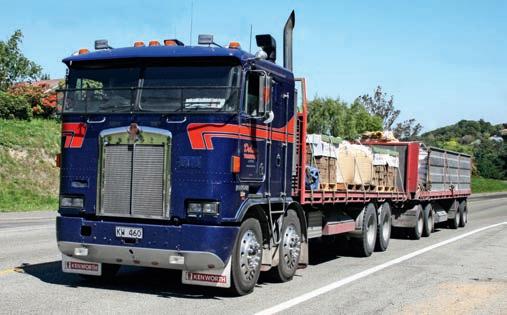

Our second inductee into the club for May ’24 is this tidy 2016 Volvo FH540 Globetrotter for Thawley Orchard Company of Mahana in the Tasman district.
The big Globetrotter began its working career running about the South Island for Heartland Haulage out of Timaru on a Toll contract. Built with the trusty 540hp
D13 and I-Shift, the 38-pallet Fruehauf unit running 50 tonnes has been a solid performer, according to logistics manager Aaron Thawley.
The unit is driven by Kevin Borland, and he loves it. Having previously driven a 2006 FH12 480 as well as a 2011 FH540, he has good experience with the Volvo brand. Aaron explains: “The
truck mostly runs between Nelson and Hastings for us carting apples, apple trees and packaging, with the odd trip to Auckland and Timaru. It works hard, but has been a good solid runner, and barely been off the road for more than a few days at a time since it joined the fleet, it really has been very reliable. We have the unit maintained by Dean’s Truck Services of
Motueka, and they work hard to get it turned around and back out the door for us as quick as they can.”
The truck was purchased by Thawley Orchard Company with the mindset of it doing about 300,000km over five years. Instead, it has churned those out in just over half that time. So, yes, we say, ‘Go the mighty Globey.’

Bridgestone and New Zealand Trucking Media want to recognise trucks that have achieved this milestone in the act of carrying the nation on their backs. Each month, up to eight trucks will be selected, and will feature in the magazine, as well as on our social media.







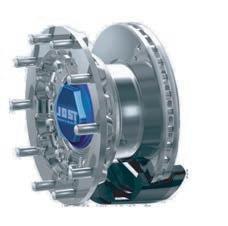

New Zealand ceased exporting live cattle in 2023. Across the Tasman however, the industry continues to be a major contributor to Australia’s export earnings.
The Northern Territory is a major player in Australia’s live animal export industry, with over 240,000 animals leaving the Darwin Port in 2023.
Cattle from across the Northern Territory, Western Queensland and the fringes of Western Australia are assembled at export yards, primarily within 100km of Darwin.
Here, the animals are held under quarantine, health inspections take place, and a diet of dry feed is
introduced in preparation for their journey by ship.
Up to three vessels call at the Darwin port each week, and depending on their size, they carry between 1000 and 20,000 animals.
Primary destinations for the cattle include Indonesia, Malaysia and Vietnam.
Road trains cart the cattle from the export yard directly to shipside at Darwin’s East Arm Port. The number of trucks required is
Story and photos by Craig McCauley
contingent on the vessel size and how far away the supplying yard is located from the port.
‘Deck’ is the common term used by graziers (station owners) and livestock agents when arranging transport, rather than ordering trucks for a specific number of animals.
A standard triple combination comprising of three 12m (40/41ft) double-deck trailers is referred to as a six-deck unit.

 Road Trains of Australia is a name that needs no introduction; however, the original green and white colours have since given way to blue and yellow. Today, the fleet runs a mix of Kenworth and Mack trucks. No. 41, a Mack Titan, is seen near Mataranka heading north towards Darwin.
BW and AL Murphy are pastoralists who run a livestock haulage business as part of their operation. This Kenworth C509 is a little different to many of the C-Series Kenworths that inhabit Northern Australia. A Truck Art custom-made 72in Aero II sleeper has been fitted in place of the normal Kenworth 60in bunk.
Road Trains of Australia is a name that needs no introduction; however, the original green and white colours have since given way to blue and yellow. Today, the fleet runs a mix of Kenworth and Mack trucks. No. 41, a Mack Titan, is seen near Mataranka heading north towards Darwin.
BW and AL Murphy are pastoralists who run a livestock haulage business as part of their operation. This Kenworth C509 is a little different to many of the C-Series Kenworths that inhabit Northern Australia. A Truck Art custom-made 72in Aero II sleeper has been fitted in place of the normal Kenworth 60in bunk.
Compared with New Zealand, trucks remain on the front for a lot longer in Aussie as this 2005 T904 of John Clarkes shows.

Class Pays, a Kenworth C509 from the South Australia-based Trans Australia Livestock fleet, isn’t an everyday sight in the Northern Territory. It is seen on the outskirts of Darwin, loaded with cattle.

Red Range Stock Supplements hail from Kununurra just over the West Australian border. Their Kenworth C509 is usually seen in front of a set of triple flat decks. With its powder-coated bullbar and tanks, it certainly doesn’t look out of place towing a set of cattle trailers.
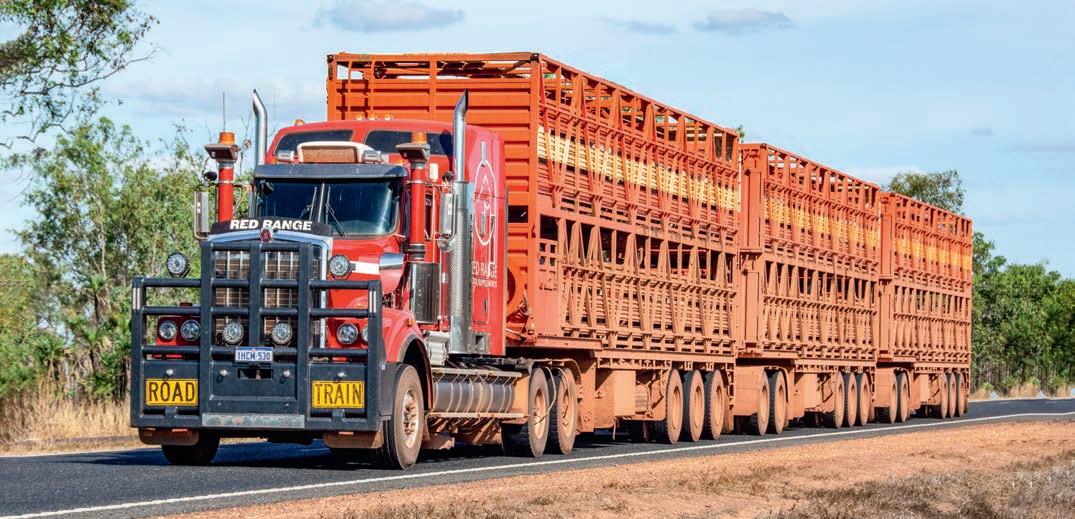
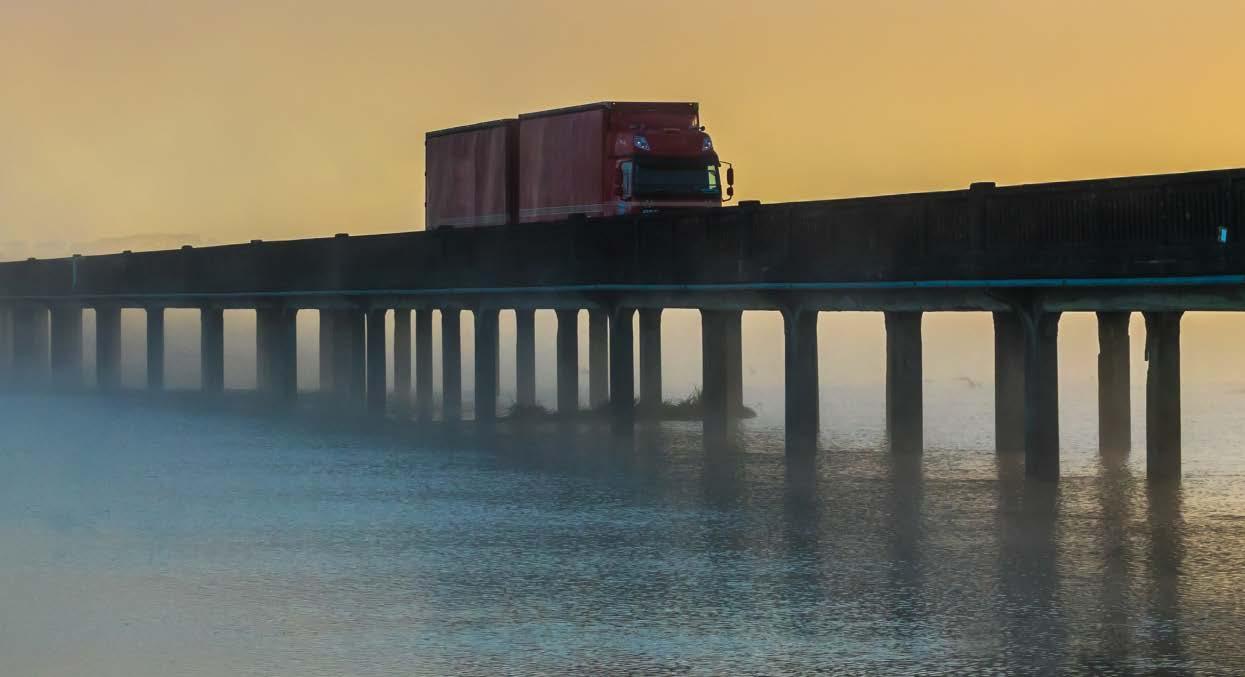




The M729II Eco is the successor to the M729 and Ecopia M749 drive tyres. Its development represents another step towards Bridgestone’s evolution as a sustainable solutions company.
The M729II Eco is the successor to the M729 and Ecopia M749 drive tyres. Its development represents another step towards Bridgestone’s evolution as a sustainable solutions company.
The M729II Eco is the successor to the M729 and Ecopia M749 drive tyres. Its development represents another step towards Bridgestone’s evolution as a sustainable solutions company.
The M729II Eco is the successor to the M729 and Ecopia M749 drive tyres. Its development represents another step towards Bridgestone’s evolution as a sustainable solutions company.
The M729II Eco is the successor to the M729 and Ecopia M749 drive tyres. Its development represents another step towards Bridgestone’s evolution as a sustainable solutions company.
Available sizes
Available sizes
Available
Available sizes
Key Features
Key Features
Key Features
Key Features
Key Features

• M729II Eco delivers the market leading wear life of the M729 with a 20 percent lower rolling resistance, while also boasting the benefits fuel saving and emissions reductions.
• M729II Eco delivers the market leading wear life of the M729 with a 20 percent lower rolling resistance, while also boasting the benefits fuel saving and emissions reductions.
• M729II Eco delivers the market leading wear life of the M729 with a 20 percent lower rolling resistance, while also boasting the benefits fuel saving and emissions reductions.
• M729II Eco delivers the market leading wear life of the M729 with a 20 percent lower rolling resistance, while also boasting the benefits fuel saving and emissions reductions.
• M729II Eco delivers the market leading wear life of the M729 with a 20 percent lower rolling resistance, while also boasting the benefits fuel saving and emissions reductions.
• Delivers industry-leading wear life and durable reputation with up to 10 per cent better wear life than its predecessor.
• Delivers industry-leading wear life and durable reputation with up to 10 per cent better wear life than its predecessor.
• Delivers industry-leading wear life and durable reputation with up to 10 per cent better wear life than its predecessor.
• Delivers industry-leading wear life and durable reputation with up to 10 per cent better wear life than its predecessor.
• Delivers industry-leading wear life and durable reputation with up to 10 per cent better wear life than its predecessor.
• Contributes to a reductions in C02 emissions through reduced fuel.
• Contributes to a reductions in C02 emissions through reduced fuel.
• Contributes to a reductions in C02 emissions through reduced fuel.
• Contributes to a reductions in C02 emissions through reduced fuel.
• Contributes to a reductions in C02 emissions through reduced fuel. Available
Auckland Central, Auckland North and Northland
Auckland Central, Auckland North and Northland
Auckland Central, Auckland North and Northland
Auckland Central, Auckland North and Northland
Bay of Plenty and Gisborne
Bay of Plenty and Gisborne
Rodney Wallace 021 220 2466
Rodney Wallace 021 220 2466
Rodney Wallace 021 220 2466
Auckland Central, Auckland North and Northland
Rodney Wallace 021 220 2466
Rodney Wallace 021 220 2466
Rodney.Wallace@bridgestone.co.nz
Rodney.Wallace@bridgestone.co.nz
Rodney.Wallace@bridgestone.co.nz
Rodney.Wallace@bridgestone.co.nz
Auckland South and Waikato
Auckland South and Waikato
Rodney.Wallace@bridgestone.co.nz
Rodney Morkel 027 216 3734
Auckland South and Waikato
Auckland South and Waikato
Rodney Morkel 027 216 3734
Rodney Morkel 027 216 3734
Auckland South and Waikato
Rodney Morkel 027 216 3734
Rodney.Morkel@bridgestone.co.nz
Rodney.Morkel@bridgestone.co.nz
Rodney Morkel 027 216 3734
Rodney.Morkel@bridgestone.co.nz
Rodney.Morkel@bridgestone.co.nz
Rodney.Morkel@bridgestone.co.nz
bridgestone.co.nz
bridgestone.co.nz
bridgestone.co.nz
bridgestone.co.nz
Bay of Plenty and Gisborne
Trevor Bunyan 021 718 861
Bay of Plenty and Gisborne
Christchurch, Nelson, Marlborough and West Coast
Christchurch, Nelson, Marlborough and West Coast
Trevor Bunyan 021 718 861
Trevor Bunyan 021 718 861
Bay of Plenty and Gisborne
Trevor Bunyan 021 718 861
Trevor.Bunyan@bridgestone.co.nz
Trevor.Bunyan@bridgestone.co.nz
Trevor Bunyan 021 718 861
Trevor.Bunyan@bridgestone.co.nz
Trevor.Bunyan@bridgestone.co.nz
Trevor.Bunyan@bridgestone.co.nz
Wellington, Wairarapa, Manawatu, Hawke’s Bay and Taranaki
Wellington, Wairarapa, Manawatu, Hawke’s Bay and Taranaki
Wellington, Wairarapa, Manawatu, Hawke’s Bay and Taranaki
Wellington, Wairarapa, Manawatu, Hawke’s Bay and Taranaki
Christchurch, Nelson, Marlborough and West Coast
Christchurch, Nelson, Marlborough and West Coast
Michael Sharpe 027 582 0682
Michael Sharpe 027 582 0682
Christchurch, Nelson, Marlborough and West Coast
Michael Sharpe 027 582 0682
Michael Sharpe 027 582 0682
Michael Sharpe 027 582 0682
Michael.Sharpe@bridgestone.co.nz
Michael.Sharpe@bridgestone.co.nz
Michael.Sharpe@bridgestone.co.nz
Michael.Sharpe@bridgestone.co.nz
Michael.Sharpe@bridgestone.co.nz
Canterbury, Otago and Southland
Canterbury, Otago and Southland
Evan Armstrong 021 190 4929
Evan Armstrong 021 190 4929
Wellington, Wairarapa, Manawatu, Hawke’s Bay and Taranaki
Evan Armstrong 021 190 4929
Evan Armstrong 021 190 4929
Evan.Armstrong@bridgestone.co.nz
Evan.Armstrong@bridgestone.co.nz
Evan Armstrong 021 190 4929
Evan.Armstrong@bridgestone.co.nz
Evan.Armstrong@bridgestone.co.nz
Evan.Armstrong@bridgestone.co.nz
Canterbury, Otago and Southland
Paul Robertson 027 274 3437
Canterbury, Otago and Southland
Paul Robertson 027 274 3437
Paul Robertson 027 274 3437
Canterbury, Otago and Southland
Paul Robertson 027 274 3437
Paul.Robertson@bridgestone.co.nz
Paul.Robertson@bridgestone.co.nz
Paul Robertson 027 274 3437
Paul.Robertson@bridgestone.co.nz
Paul.Robertson@bridgestone.co.nz
Paul.Robertson@bridgestone.co.nz
Will Shires meets up with a pair of UK heavy-haul operators who share their thoughts on the hoops they and others in the business must jump though to get the job done.
There are 184 counties in the UK, and most have their own rules and regulations regarding the movement of oversized loads, which proves a complete headache for heavy hauliers.
Daniel Wood knows this only too well. He moved from a family-run general haulier to become transport manager at Cranage Haulage, a heavy

haulage specialist based in Cheshire, northwest England.
“Think of all the normal restrictions and hassles a general haulier faces, with drivers’ hours, safe parking, customer rates and the driver shortage, and on top of that you have everything else,” he told me, when I caught up with him recently.
The “everything else” he’s referring to doesn’t just include the swathes of red tape imposed by the different counties but all the other bureaucracy that affects the sector. And there’s a lot of it.
Cranage Haulage and its sister company Ascroft Transport are based at the same site but are run as separate businesses. Each has its own customer base and carries out distinctly different work. Cranage, formed in 2004, concentrates on moving
specialist plant and equipment on its fleet of low-loader trailers, including road rail cranes. In recent years, it’s added some Hiabs and flats to its 18-strong truck fleet, which has allowed it to increase its flexibility. “It’s a one-shop stop,” explains Daniel. “If there is a big machine to move, and a lot of kit needs to be taken off it, we can ship the whole lot. There’s no need to bring in subcontractors to lift buckets, walkways and other attachments.”
Ascroft, which celebrates its 30th anniversary this year, predominantly moves new equipment and has a longrunning contract with Finning, which is the UK’s sole supplier of Caterpillar equipment. In addition to collecting plant from UK ports and delivering it to Finning’s UK National
Distribution Centre, and onwards to customers, it also moves UK-manufactured Caterpillar ADTs and loading shovels. It’s a contract the haulier is fiercely proud of, and eight of its 14 tractors are finished in Finning’s distinctive black livery.
Another thing both companies pride themselves on is providing an exceptional level of service. “We do things properly, and there’s absolutely no cutting corners here,” says Gareth Edwards, MD of both Ascroft Transport and Cranage Haulage.
This insistence on doing things right, coupled with the legislation-heavy sector they operate in, results in a staggering number of hoops to jump through. A good example of this is the 400-plus movement orders the companies apply for every week.
Required for any journey where a truck runs overwidth, overweight or overlength, a typical movement order application might generate 30 replies from each authority, all of which must be checked carefully. This is enough to keep two staff members permanently employed across the two businesses.
Gareth explains that the biggest headache is caused by the lack of consistency and uniformity between the different areas.
“Some places, such as North Wales, will only accept a movement for one day,” he explains. “While Merseyside is three days, Manchester is 10 days and West Yorkshire and Lancashire are 30 days. It can be tough when you’re traversing

through these places.”
Gareth adds: “The real challenge occurs when a part doesn’t arrive in time, there’s a delay at the docks, or the job is rained off. And now, because we are running compliantly, through no fault of our own, we run into problems. So, we ask for help and request an extension to the movement order.” This involves a lot of additional legwork and admin, with subsequent date and route changes, and numerous calls to local authorities and police forces.
There are also abnormal load curfews to consider, which can affect travel at peak times, weekends and bank holidays. And in some counties, you can’t move in darkness.
“But, of course, you can’t just pull into a layby,” Daniel reminds
me. “You have to plan very carefully where you’re going to sit out a curfew.
“And then there are all the small intricacies – like vehicle registrations,” he continues. “You need the registration on the movement order. But it might be seven days before the move, and anything can happen in that time. We have had movement orders rejected just because of the registration change. So, then we have to resubmit, which could take another five working days.”
While both companies represent the pinnacle of professionalism, mistakes can happen, often through no fault of their own.
Jack Ollerton, operations director at Cranage Haulage, gives the example of a driver
who collects a 4.5m-wide machine, but when he measures it, he finds that it’s actually 4.6m wide. “It might have had an extra set of steps bolted onto it. And now you could be parked up for a week,” he explains.
“This isn’t because someone has done the job wrong, or cut corners, but is simply down to a clerical human error,” says Gareth.
Perhaps the hardest part is having to relay all of this to a customer, who might have an expensive machine waiting to be delivered. Daniel says: “You have to explain what you’re going through, when all they want to do is move the machine to the job to start earning money.”
Another area where a bit of uniformity wouldn’t go amiss is with police escorts. Although self-escorting vans have been

permitted in the UK for about 20 years, the police will insist on providing an escort for certain widths. The exact width varies from force to force.
Police escort pricing can be eyewateringly expensive, and according to Adam Pritchard, transport and compliance coordinator for Ascroft Transport, it’s rare to see any change out of £2000 (NZ$4200), even for a short journey. Incredibly, the rate can vary depending on who attends, with police sergeants commanding a premium. Both companies pass these costs onto their customers, some of whom are surprised to discover that the police fee can be higher than the actual move rate.
“Meanwhile, we get calls asking us to move a 20-tonne excavator this afternoon, and we must explain that it doesn’t work like that. It’s crazy the hoops you must jump through just to move a machine,” says Daniel.
“For me, it’s been a massive learning curve. The intricacies surrounding the planning are phenomenal, and it’s blown my mind what’s involved. It had certainly helped being surrounded by 50 years of heavy haulage experience.”
Excluding a lone Cat-powered Foden Alpha, both companies operate exclusively Scania fleets.
Although Ascroft has previously mainly run Scanias, until recently Cranage did have several Volvo interlopers. “One was an FH16 600, but it was let down by the dealer backup,” says Daniel.
Among the Ashcroft Scanias are three 540S tractors, which Edwards says are doing phenomenally well on fuel. “They’re getting 9mpg (26L/100km), and I can’t believe how well they perform,” he says.
But the hard work is carried out by a Scania 770R XT and a

770S XT, both of which are rated at 150 tonnes.
“With a V8, the more weight you put on, the more they dig in and give you power,” Daniel tells me. “With a 770, the country is flat, even at 80 tonnes. At 40mph (64km/h), it doesn’t slow down. The wagon eats the road all day long.”
Double-drive tractors are generally kept for four years, while 6x2 mid-lifts remain on the fleet for five years. “That’s when we want to turn them over for the best residual values,” explains Daniel.
All but two trucks are autos, a move Daniel thought the company would never make. “We fought autos for a long time, but with the 730, you couldn’t have a manual, and the drivers chose the horsepower over manual gearboxes. Autos really have come on a lot,” he admits.
Both companies have run a selection of different makes
of low-loader, including Nooteboom, Broshuis and Faymonville. The current trailer of choice is Faymonville, and the companies recently invested more than £1 million (NZ$2.1 million) on three new VarioMAX low-loaders, one for Cranage and two for Ascroft.
It was UK distributor Traffco’s highest-value UK low-bed order to date. There are also three flats on the fleet, which run behind Hiab-equipped tractors. Between them, the two companies have a fleet of five Mercedes-Benz Sprinter escort vans. They’re fitted out to the highest standard with all the relevant kit, and a high level of comfort for the drivers.
Another vehicle that caught my eye was a 1989 Mercedes 6x6 wrecker. The V10-powered beast is ex-Singapore military and is used for recovering dead plant. There are plans to paint it in Cranage’s distinctive blue livery.
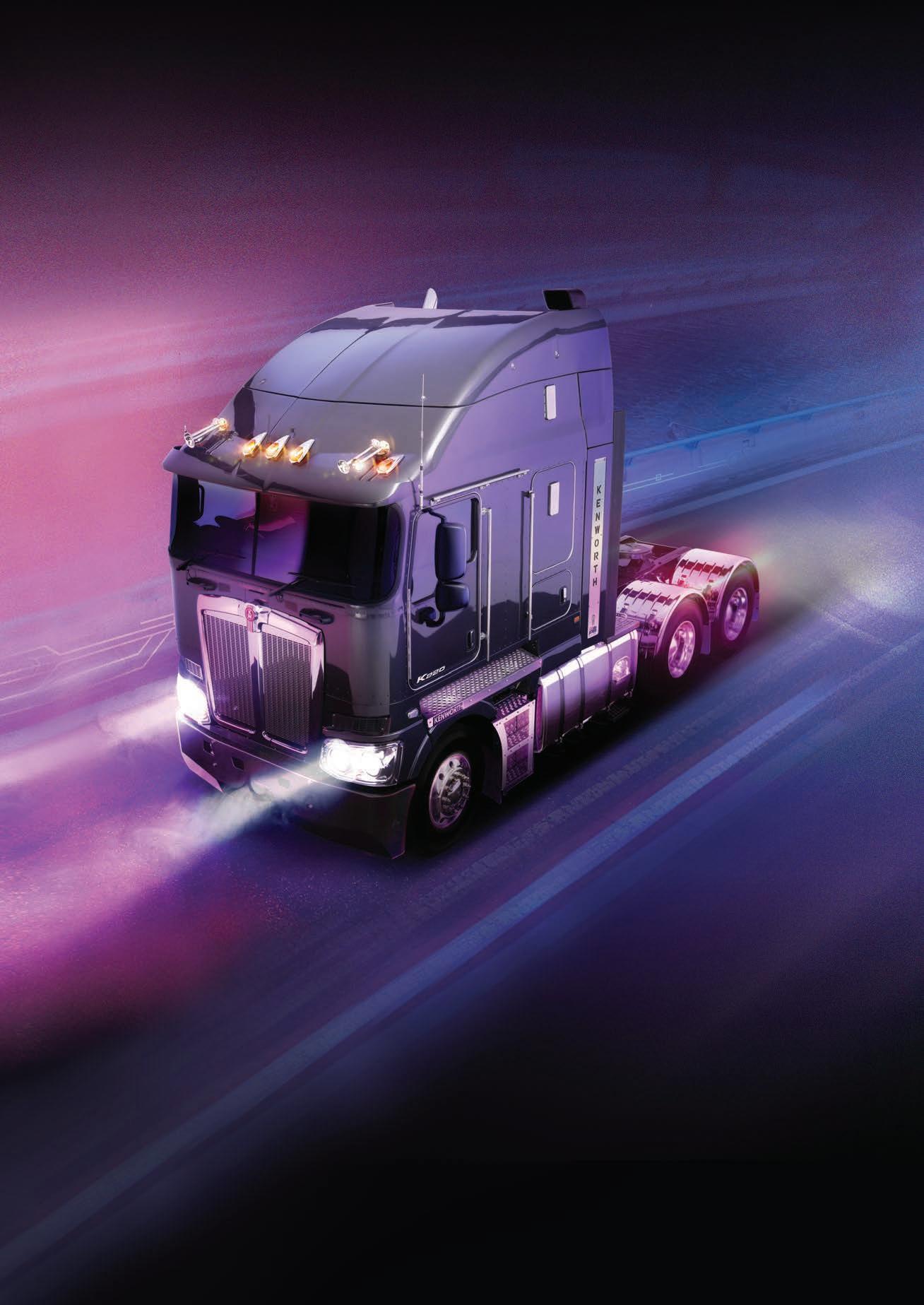
 Daniel Wood, Jack Ollerton, Adam Pritchard, Gareth Edwards and Gary Edwards.
Left: This Faymonville VarioMAX low loader is quite a piece of kit. Right: The ex-Singapore military V10 Mercedes 6x6 – what a machine for recovering dead plant!
Daniel Wood, Jack Ollerton, Adam Pritchard, Gareth Edwards and Gary Edwards.
Left: This Faymonville VarioMAX low loader is quite a piece of kit. Right: The ex-Singapore military V10 Mercedes 6x6 – what a machine for recovering dead plant!




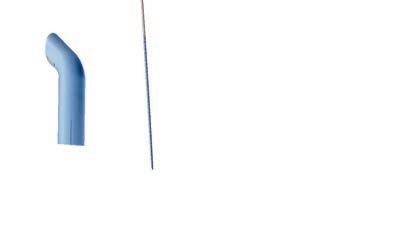

 Izaak Kirkbeck
Izaak Kirkbeck
Deep in the heart of America is Louisville, Kentucky, home to the Mid-America Trucking Show. An annual event with a pilgrimage-like following, it’s a showcase of the latest and greatest, as well as all that shines and glows.
The first Mid-America Trucking Show was held in 1972, and since then the event has steadily grown to a point where it is now recognised as the world’s largest and longest-running heavy-duty trucking event. And with everything on display including the latest models from various marques and the latest technology advancements, MATS truly covers all bases.
This year, there was again plenty to see, with no fewer
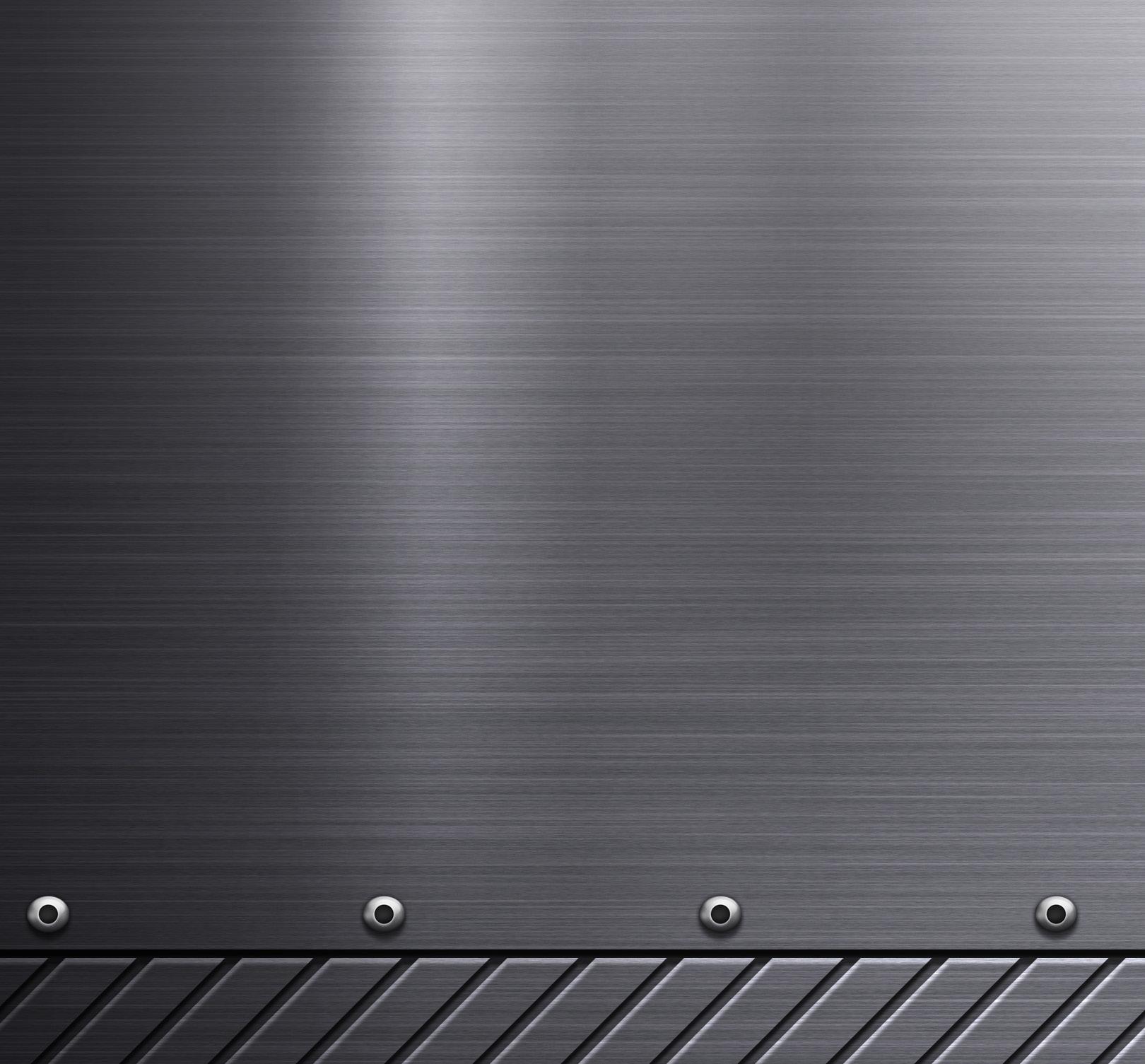
than 877 exhibitors from 47 states as well as 15 countries, and all housed in a touch under 93,000m2 of exhibition space – so you had to keep things moving to have any chance of seeing it all. Live events are also held over three days to enlighten and entertain. President of MATS, Toby Young, was extremely pleased with the event’s achievements, citing this year’s show had elevated MATS’ commitment to education and events; building upon past successes,
and delivering invaluable insights, opportunities, and connections for participants and patrons alike.
Kenworth and Peterbilt both had a solid presence at the event, with impressive display stands loaded with a respectable array of their current models. For Kenworth, there was still a hint of continued 100-year celebrations, and why not? It is quite the milestone.
Having the classic W900L as well as the new W990 on the stand certainly grabbed
attention. The opportunity to explore and experience the pair side by side was invaluable, especially for the staunch old-skool operators, who are slowly growing to appreciate the extra room that the new 2.1m wide cab affords.
For Peterbilt, it was a slightly harder row to hoe. With the complete demise of the historic alloy-cabbed, two-piece windscreen 389 and the arrival of its replacement, the 589, it was never going to be an easy show for







a 400 Caterpillar with ‘6-anda-4’ transmissions – check out the gear-shifters (right), a cool western theme going on.

Above: Tarik Al-Amin (24) of Crete, Illinois, grabbed first place ‘best paint and graphics’ in the working truck and trailer combination class. The W900L he drives for the family business is a standout.




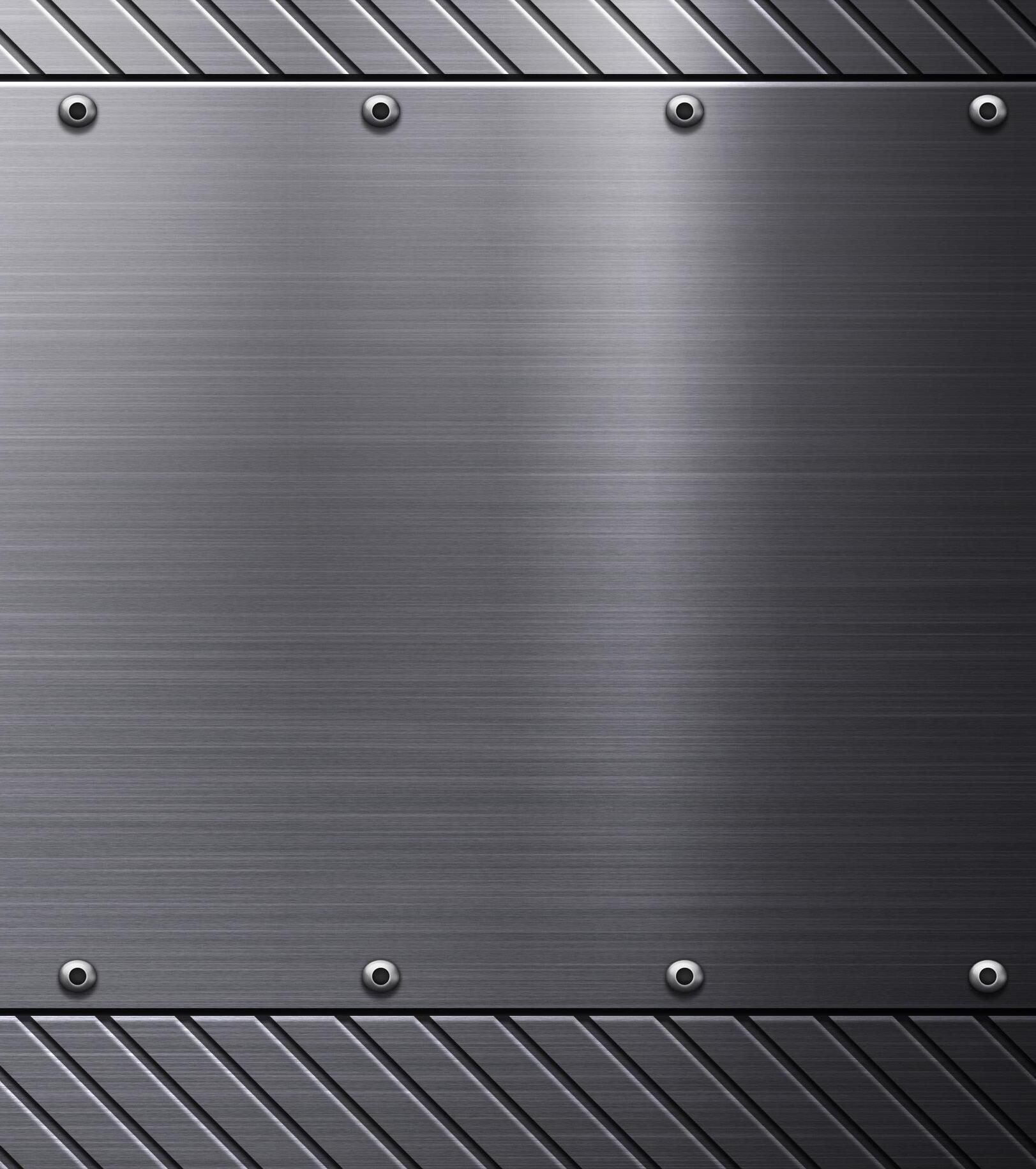


 Owned by Brant Arnold of Adamsville, Tennessee, Twister is a 1970 359 Peterbilt, running
Home away from home, some sleeper cabs defy the laws of physics.
Left: A crisp flat-roof double bunk 1982 Kenworth K100 owned by Greg Kendall of Orleans, Indiana; a very rare animal nowadays.
Plenty of old iron on display to jog the memory banks.
Owned by Brant Arnold of Adamsville, Tennessee, Twister is a 1970 359 Peterbilt, running
Home away from home, some sleeper cabs defy the laws of physics.
Left: A crisp flat-roof double bunk 1982 Kenworth K100 owned by Greg Kendall of Orleans, Indiana; a very rare animal nowadays.
Plenty of old iron on display to jog the memory banks.

them. However, to soothe the wounds, Peterbilt had a vast array of new, shiny bolt-on accessories on hand to show punters of the old skool that all was not lost; they could dress a new 589 in a fashion that helped it resemble the old 389.
Also aiding in the transition to the 589 was the team from Semi Casual/Fitzgerald Peterbilt with a heavily modified pair of 589s on display. The choptopped conversion that the team completed just in time for the show demonstrated that with a little imagination and a ton of determination, the 589 can be transformed into a real head-turner. They just need to find a way now to fit a twopiece windscreen to the 2.1m cab for the diehard 389 fans.
The highlight of the show for any truck enthusiast visiting from the bottom of the Pacific has to be the PKY Truck Beauty Championship. This show ’n’ shine-style event, held alongside the main show, had 175 of North America’s most elite show trucks on display. The level of detail is absolutely phenomenal, and the dedication to the cause next level.
As you walk about the participants, you have to continually pinch yourself to remember that these are not show ponies; they are all mostly working rigs that, come Monday, will be reversing up to a dock to grab a load of fresh produce or the like.
MATS most definitely has something for everyone. Much of the New Zealand trucking scene is influenced by the USA, so this is definitely an event to add to your bucket list.
On that note, the dates for 2025 are 27 to 29 March, so start thinking about tickets now.




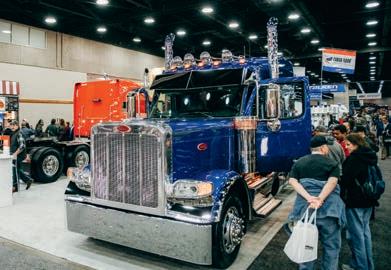


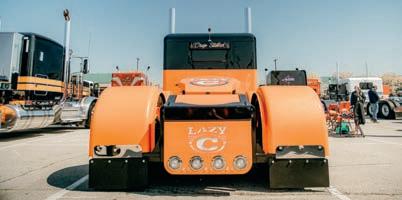




 Classic W900L or New Gen W990 – which would you take?
Peterbilt’s new 589 dressed in classic style. A rugged-looking W990 Kenworth with a serious military feel about it.
Classic W900L or New Gen W990 – which would you take?
Peterbilt’s new 589 dressed in classic style. A rugged-looking W990 Kenworth with a serious military feel about it.

With UD Trucks you get the best of both worlds – a robust build with all the advantages of European innovation, technology, and design – at a price point that makes business sense.
We have stock of both the heavy duty Quon and medium duty Croner models on the ground right now, ready for immediate delivery. Get on the road quickly and take advantage of the fuel efficiency, reliability and safety that UD Trucks is renowned for. UD Trucks - truly your premium everyday truck.



To find out more, contact your nearest UD Trucks Dealer:
To find out more, contact your nearest UD Trucks Dealer:
To find out more, contact your nearest UD Trucks Dealer:
Northland/Auckland/Waikato 09 250 1800 | Rotorua/Thames/Coromandel/BOP 0274 912 793 | Manawatu/ Horowhenua/Wanganui/Taranaki/Hawkes Bay 027 446 6374 | Wellington/Hutt Valley /Kapiti Coast/Wairarapa 021 284 7788 | Nelson 027 589 5552 | Blenheim/Canterbury/Timaru 03 349 0044 | Southland 03 215 8250 or visit udtrucks.com/newzealand
Northland/Auckland/Waikato 09 250 1800 | Rotorua/Thames/Coromandel/BOP 0274 912 793 | Manawatu/ Horowhenua/Wanganui/Taranaki/Hawkes Bay 027 446 6374 | Wellington/Hutt Valley /Kapiti Coast/Wairarapa 021 284 7788 | Nelson 027 589 5552 | Blenheim/Canterbury/Timaru 03 349 0044 | Southland 03 215 8250 or visit udtrucks.com/newzealand.
Northland/Auckland/Waikato 09 250 1800 | Rotorua/Thames/Coromandel/BOP 0274 912 793 | Manawatu/ Horowhenua/Wanganui/Taranaki/Hawkes Bay 027 446 6374 | Wellington/Hutt Valley /Kapiti Coast/Wairarapa 021 284 7788 | Nelson 027 589 5552 | Blenheim/Canterbury/Timaru 03 349 0044 | Southland 03 215 8250 or visit udtrucks.com/newzealand.



Improvising is deeply ingrained within the Kiwi DNA. This most definitely rings true for three young truck enthusiasts from Southland.


This month we pop into Winton and catch up with local 12-year-olds Cooper McDowall, Isaac Davis and Flynn Harland. The three mates are mad keen up and coming truckies, who share a passion for the transport industry that is off the scale. Silent reading time for these young lads is not your Alex Rider or Harry Potter … no, these guys will be found nose deep in a copy of the latest New Zealand Trucking magazine.
Cooper’s mum, Melissa McDowall, alerted us to a

project that the three boys had embarked upon, inspired by a task their teacher had set for them.
“Our teacher had the class make some shoes out of cardboard,” says Cooper. “This gave me an idea, so I said to Isaac and Flynn we should make a truck each out of cardboard and stuff, and then have a competition to see which one is the best.”
The following weekend they were all into it, scavenging about for various shapes and forms of
cardboard boxes, as well as all other manner of usable items they could lay their hands on around the house. A visit to the local $2 shop for materials was also a must.
There was no stopping the lads. “You should have seen it, there were hot glue guns and glue sticks all over the place,” Melissa says with a laugh.
Looking over the models the dedication to detail is on point, from underbody exhausts through to CTI systems, it’s all there. Chatting to Isaac about his
K104 we asked what the hardest part to build was.
“Probably the cab, getting the Aerodyne sleeper cab roof right. But the deck was easy, that’s just an empty Lion Brown beer box cut up to fit.”
From all of us here at New Zealand Trucking magazine, we congratulate the three of you on your creativity and dedication to completing the builds. Your eye for detail is spot on; we cannot wait to see your next projects.


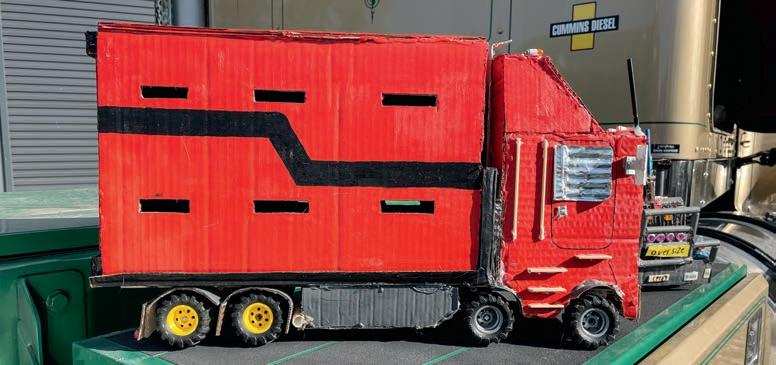
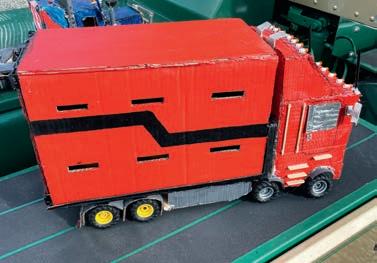








Happy Easter! I hope you all had a fantastic Easter, It’s back to school. I sure hope you enjoyed your school holidays. What did you all get up to? I had my granddaughter come stay. We rode the horses and went down to the beach. Elise is five years old, and it was her first time on a horse, and she said it was AMAZING!
Congratulations to 10-year-old Hunter Pearce, who found the Little Truckers’ Club logo on page 76 of the April issue. And well done, 12-year-old Talia Antill, for winning the FindA-Word missing word, COURIER. Keep an eye on your mailbox, kids; something awesome is heading your way.

Don’t forget, if you would like to see yourself here in Little Truckers’ Club all you need to do is email your stories, jokes, photos, and/ or drawings to me at rochelle@ nztrucking. co.nz with a wee paragraph telling us about them along with your name and age. We love seeing them all!

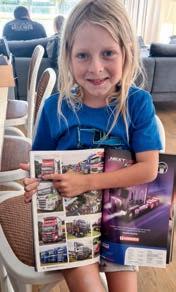
WHY DID THE TAXI DRIVER LOSE HIS JOB? ANSWER BELOW JOKE OF THE MONTH
Here we have a list of questions. The answer starts with the letters spelling ‘Volvo’ and ‘Scania’ down the left side. The questions are in the correct order of the spelling. Have fun kids!
BONUS ENTRY for anyone who can also tell me any other jobs that I may have missed!
The Little Truckers’ Club logo is hidden somewhere in this issue. Find it, and you may win a prize. Email rochelle@nztrucking. co.nz with your name, age and where you found the logo.
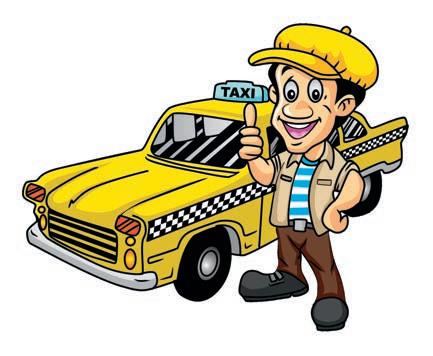
Thank you for your amazing colouring competition entries in the April 2024 issue! Our winner is nine-yearold Blake MacMillan. Great job, Blake, and CONGRATULATIONS!
Special mentions to Callum Beel and Emma Blackburn – cheers for the photos, fantastic work!
Congratulations, Blake MacMillan, lovely job colouring in the Volvo!



1: Another name used for trucks and cars
2: The opposite of closed
3: When you are unable to find something it is
4: Trucks are _____ cool
5: Some trucks have these on the hood
6: Some drivers like this in their coffee
7: Shipping __________
8: Kids do this to get honks
9: Day and _______
10: This is done before turning a corner when driving
11: A truck and trailer often has nine _______

Great job, Callum Beel and Emma Blackburn. Thanks for entering!
 Hunter Pearce found the hidden logo in April. Well done!
Hunter Pearce found the hidden logo in April. Well done!
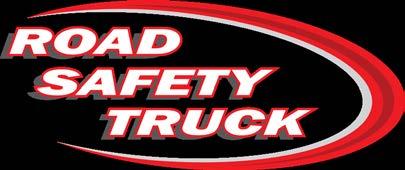


The Road Safety Truck took centre stage at the Teletrac Navman Technology, Maintenance, Safety (TMS) Conference and Exhibition, presenting an impressive sight!
It not only provided a fantastic backdrop for the conference stage but also played a crucial role at the event. Over 100 secondary school students, attending as part of a careers event, had the opportunity to enter the truck and engage with the SafeT360 virtual reality programme. This programme is designed to offer them the perspective of a truck driver, highlighting various road hazards and increasing awareness of the truck driver’s blind spots.
As a non-profit organisation, we are continually seeking sponsors for the Road Safety Truck. If you’re interested in supporting this vital initiative to improve outcomes for New Zealanders, please don’t hesitate to contact us at 0800 338 338 or via email at info@trucking.nz.

p 0800 338 338 w www.trucking.nz
Thanks to all our Partners & Sponsors







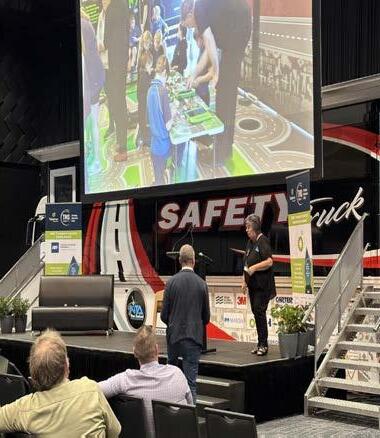





Show organisers
Please send your event details, at least eight weeks in advance, to: editor@nztrucking.co.nz for a free listing on this page.
Wood Transport and Logistics 2024
22-23 May 2024
Distinction Hotel, Rotorua
Contact: woodtransport.events/event/wood-transportlogistics-2024/
McDonough Contracting Gore Truck Show
1 June 2024
Transport Repairs yard, Falconer Road
Contact: goretruckshow@gmail.com
Facebook – Gore Truck Show
Southland Hug a Rig
10 August 2024
Southern Field Days site, Waimumu
Contact: hugarigsouthland@gmail.com, Facebook – Hugarig
All scheduled events may be subject to change, depending on weather conditions, etc. Please check websites for updates before setting out.
Special Rigs for Special Kids
25 August 2024
Edgar Centre, Portsmouth Drive, Dunedin
Contact: specialrigs.org.nz, Facebook – Special Rigs for Special Kids
2024 South Island Long Lap
14-26 October 2024
Redwood Hotel, Christchurch
Contact: Donna Hardie, 0274518585
siclassictrucks@gmail.com
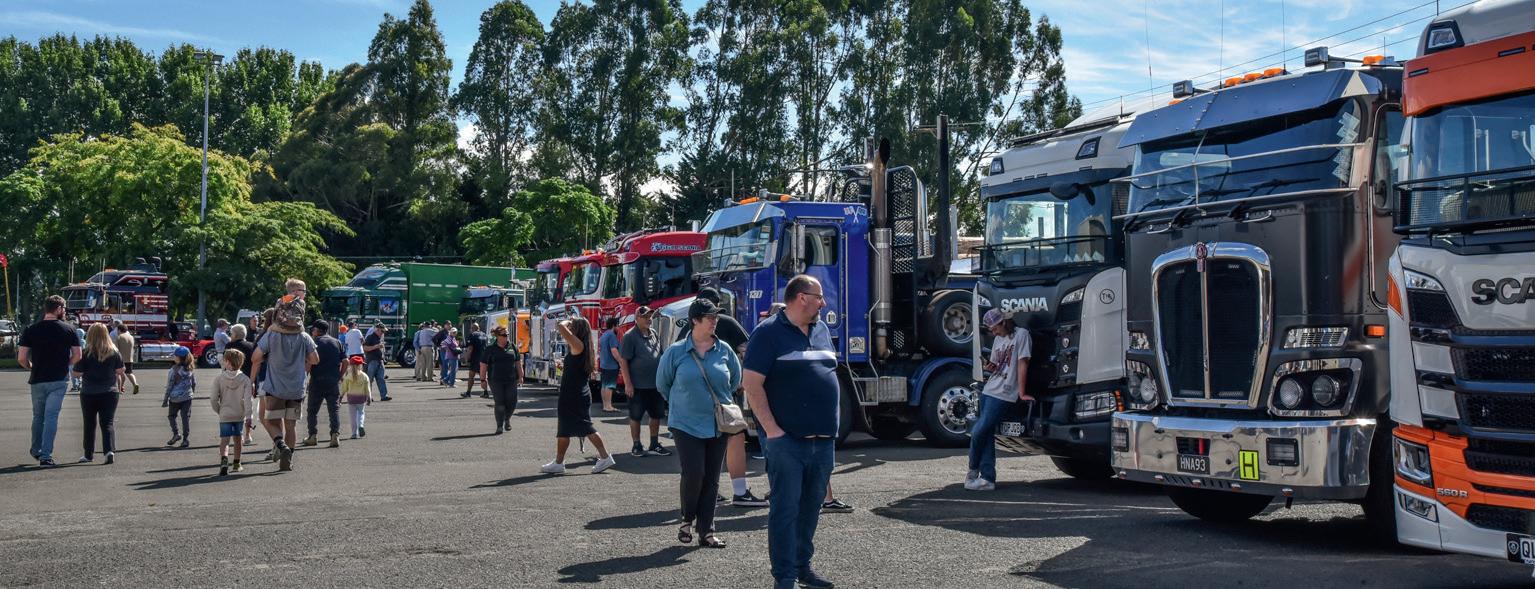

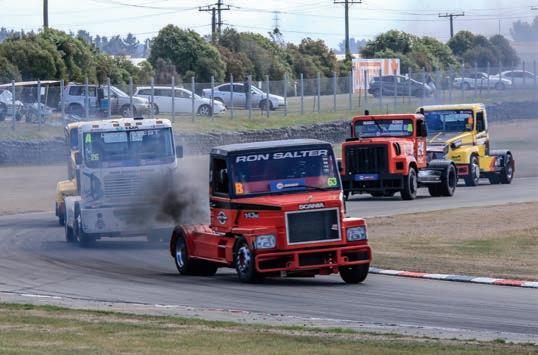


620hp 18 speed manual
Available Now
Complete with 2016 12.1 metre Fruehauf 5 axle curtainsider –38 pallet unit BPW axles, disc brakes, 19.5 DuraBright alloys right throughout. 50 tonne rated and 23 metre permitted, 930,000kms.
Fully integrated into TN360, our diverse range of cameras deliver you real-time footage and data to help you improve safety, streamline coaching and protect drivers Now that’s choice







New Zealand Trucking reveals how the economy is travelling via key metrics from the road transport industry.
This information is compiled by Russell Walsh from information provided by the NZ Transport Agency statistical analysis team and through the Open Data Portal.
The data used in this information reflects any amendments to the data previously reported.
This summary includes data from two heavy-truck classes and one heavy-trailer class.
A goods vehicle is a motor vehicle that:
(a) is constructed primarily for the carriage of goods; and (b) either:
(i) has at least four wheels; or (ii) has three wheels and a gross vehicle mass exceeding one tonne.
Note: Vehicle classes are not the same as RUC vehicle types or driver licence classes.

NB
(medium- goods vehicle)
NC
(heavy-goods vehicle)
TD (heavy trailer)
A table of all vehicle classes is in Table A of the Land Transport Rule Vehicle Dimensions and Mass 2016 Rule 41001/2016 https://www.nzta.govt.nz/assets/ resources/rules/docs/vehicledimensions-and-mass-2016-asat-1-October-2019.pdf
A goods vehicle that has a gross vehicle mass exceeding 3.5 tonnes but not exceeding 12 tonnes.
A goods vehicle that has a gross vehicle mass exceeding 12 tonnes.
A trailer that has a gross vehicle mass exceeding 10 tonnes.
First registration of NB, NC and TD class vehicles year on year, to date
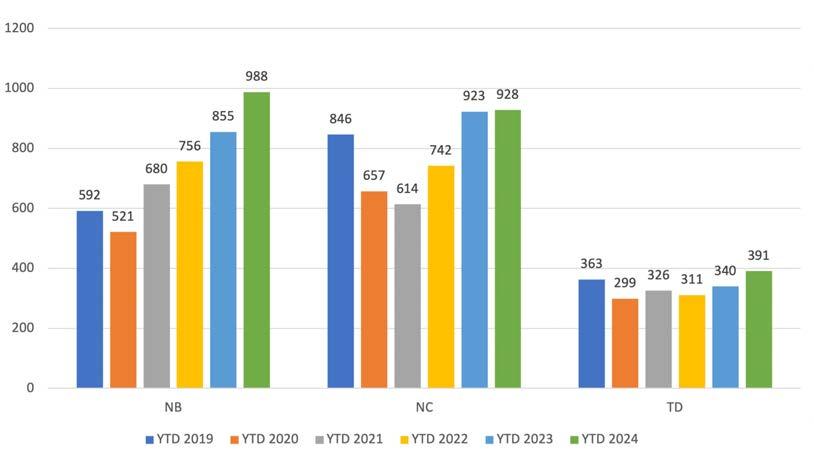
First registration of TD class heavy trailers for March, year on year by major manufacturer

First registration of NB and NC class vehicles for March, by major manufacturer

First registration of NB, NC and TD class vehicles for March, year on year
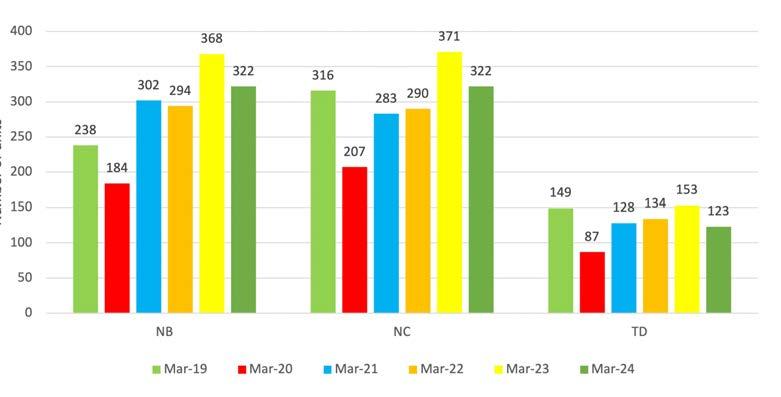
First registration of NC class vehicles year to date 2018 –2023, by major manufacturer

First registration of TD class heavy trailers year to date 2018 –2023, by major manufacturer

This information is put together compiled by Russell Walsh from metrics provided by the NZ Transport Agency. New Zealand Trucking acknowledges the assistance of the media team at NZTA in providing the data.

Total value and distance of road user charges purchased per year and year to date
Summary of RUC transactions for March 2024
Number of individual RUC licences issued for month 304,247
Total kilometre RUC distance purchased (All types) 1,324,306,742
Total value of all RUC purchases (All types) $180,956,418
1 Jan 2019 – 31 Dec 201916,166,434,103 $2,041,939,272 1 Jan 2020 – 31 Dec 202015,421,400,378 $2,069,615,049 1 Jan 2021 – 31 Dec 202116,204,803,262 $2,249,341,814 1 Jan 2022 – 31 Dec 202217,683,361,155 $1,710,831,998
1 Jan 2023 – 31 Dec 202316,687,053,002 $1,655,078,736
1 Jan 2024 – 31 Mar 20243,854,457,767 $520,486,725
RUC distance purchased for RUC type 1 vehicles
1
1
RUC type 1 vehicles are powered vehicles with two axles (except type 2 or type 299 vehicles. Type 299 are mobile cranes). Cars, vans and light trucks that use fuel not taxed at source (i.e. diesel fuel) are generally in this RUC type.
The top eight RUC type purchases, other than type 1, in descending order RUC Type Description
2Powered vehicles with one single-tyred spaced axle and one twin-tyred spaced axle
6Powered vehicles with three axles, (except type 308, 309, 311, 399 or 413 vehicles)
43Unpowered vehicles with four axles
14Powered vehicles with four axles (except type 408, 414 or type 499 vehicles)
951Unpowered vehicles with five or more axles
H94Towing vehicle that is part of an overweight combination vehicle consisting of a type 14 RUC vehicle towing a type 951 RUC vehicle with a permit weight of not more than 50,000kg
33Unpowered vehicles with three twin-tyred, or single large-tyred, close axles (except vehicle type 939)
408Towing vehicles with four axles that are part of a combination vehicle with a total of at least eight axles
RUC distance purchased year-to-date March for selected RUC types

A description of RUC vehicle types is available at https://www.nzta.govt.nz/vehicles/licensing-rego/road-user-charges/ruc-rates-and-transaction-fees/ Please note data October differ slightly from that reported for the same period previously due to adjustments being made to the base data.
RUC purchases (All RUC types)

Average monthly RUC purchases by year (All RUC types)

RUC purchases during March for selected types

Total number RUC Licences issued for month (All RUC types)


It is people who create sloppy business practices, so it is up to people to cure them.
My family involvement with the trucking industry goes back to 1870 – and so I do not intend to disrespect that history – but it first started to become more established and grow after World War II. The highway system was expanded, and it became relatively straightforward to acquire a truck, so a number of men who had an enthusiasm
for things mechanical and moving set up local businesses. The next generation grew up mucking around with Dad’s truck waiting until they were allowed to drive. And so the industry evolved.
I may be simplifying things, but the road transport industry is largely run by practical people who know a lot about the handson elements of their businesses and have
a lot of relationships they can use. Still, in many cases, they fight the constriction they feel from strongly managed business processes. For example; a rural carrier north of the Harbour Bridge generally was slow at charging clients as the oldest generation insisted that the only way it would survive was if he priced every job personally. On one occasion, the company had an order for a full load to go up north, which was completed. The old fella’s daughter spotted the consignment when the driver

dropped it off at the office. She realised that it would be at their normal rate, so she priced the job herself and sent off an invoice.
A couple of days later, the customer rang to say how embarrassing this was. He had only given them the job because he usually got at least six months to pay, and yet this time, he had been invoiced straight away. Money was tight but he would see what he could do; but could they at least warn him if they intended to invoice on time in future?
Most transport companies have moved on from this sort of process, with the third and fourth generations moving into the industry with a broader base of training and experiences. This has led to most companies doing the basics of charging clients, paying costs of various sorts and possibly receiving some level of monthly reporting. Where there is scope for improvement of processes is in obtaining and using detailed, yet practical, information that can assist a company to refine and increase the productivity of its fleet and the company as a whole.
When reading the business section of your local paper, you will read how our nation’s productivity has decreased, and
Obtaining and using detailed, yet practical, information can assist a company to refine and increase the productivity of its fleet and the company as a whole.
we need to do something about this. We cannot all fix the country, but we can improve our company’s productivity, and the first step is to understand what economists call productivity.
The definition is basically revenue divided by staff numbers – the more you earn with less staff, the more productive you are. Now, who said economics was hard? Overpaid, maybe, but not hard.
Productivity comes into play in many areas of a transport company – obviously, in driving freight on a trip but also in loading freight, operating a warehouse, administering operations and so on. There is obviously a lot of data needed to start providing meaningful pictures of productivity, such as the number of kilometres travelled, the time it took, the number of tonnes carried, the number of storemen at the depots and so on.
To perfect business processes, we need to close the circle, starting with the loading of
Ron Wood was a prolific truck painter in the 70s and 80s when Macks, Kenworths, and Volvos were all assembled at Palmerston North. He amassed a collection of truck photographs, now long lost, which his family would love help in recovering.

freight on a truck and finishing with paying a dividend to shareholders. We need to put in place the analytics, at fleet and company levels, that provide the information that enables productivity to be lifted at the most minute level of operation.
This information can help you increase revenue in a controlled manner and indicate where you might be carrying a bit of ‘fat’. The processes that will provide you with this information must be focused on providing understanding to the multiple generations involved with your company; if both your grandfather and your son can understand the picture presented, then you are making real progress.
Computers don’t cure sloppy business processes but they will certainly help you to not only cure these yourself but also to develop processes that will move your company forwards over the next period, increasing productivity for all stakeholders.

collection of albums to a visitor looking for some pictures of his own trucks. Unfortunately – and quite possibly without ill intent, they were never returned.
We would LOVE to get these back – or even just borrow them, just so that we can scan the pictures. If anyone has seen these or know where they might be, we would be forever grateful.
The Albums were actually pretty rough (as were the photographs!) –cheap, plastic seventies ring binders in bright colours like blue and orange …and covered in over-spray from the paint shop. One surviving example can be seen above.
If you can help, please contact:

The Teletrac Navman Technology Maintenance Safety Conference and Exhibition was held at Te Pae Christchurch on 13 and 14 March and promised a refreshed format to the usual standard of conferences and exhibitions. Organised by the New Zealand Trucking and National Road Carriers associations, it was designed to engage delegates and inspire conversation with more than 50 exhibitors and eight conference sessions.
Peter Brown, national manager – maintenance and operations, at Waka Kotahi NZTA, gave delegates good news: the agency has money to spend on roads and a plan for the future.
“The current state-highway network is generously described as fragile. Significantly, there has been underinvestment in rehabilitation and resurfacing of our state highway network over the past decade.”
Brown said that while cars consume road capacity, trucks consume the asset. One 10-tonne axle is equal to 10,000 cars.
“If we accept a greater freight task and heavier freight loads that will consume the roads faster, we have to strengthen the state highway network, focus on drainage, because water is not our friend, and use treatments such as deeper pavements instead of chipseal, foam bitumen (three times the cost of chip), and structural asphalt (four times the cost).”
Brown outlines the task.
“Over the next 10 years, we need an increasing programme
of maintenance renewal. We have to stay in the available funding envelope provided by the National Land Transport Fund, and that’s to return the network to an acceptable level of service, comparable to what it was like in 2014. How? The first step is the draft Government Policy Statement that says the government intends to reform the system through a national infrastructure agency, which will take a 30-year view, reform how we fund transport infrastructure and have a 10-year investment plan and funding pipeline, which is really important.
“The part of the draft GPS that really spins my wheels is ‘maintenance and resilience’, focusing on resealing, rehabilitation and drainage over the next 10 years. The government is signalling to NZTA to take a more proactive approach. The targets set expect 2% of the network to be rehabilitated per year. Currently we achieve 0.7% of the network.”
Brown says NZTA is looking at a new maintenance delivery model
that will give it more say in what’s delivered by providing contractors with a blueprint for what it wants, and also looking at Tier 2 and Tier 3 regional providers to grow the capacity. “We will take control of the asset management – we own it.”

He said catalogued designs that can be modified depending on location, instead of individualised designs per site, will be used. “That requires NZTA to take more risk, but it’ll be more efficient to get the process moving and contractors delivering on the volume of improvement needed,” he said.
“Over the last decade, we’ve been guilty of patching up what we can afford at the time – which is not efficient or effective. We’re going to have longer and more secure planning cycles, 10-year pipelines for funding. It will require significant upfront cost and we need to shift thinking to wholeof-life costs; over time, it’ll mean a lower maintenance cost over the life of the network – and less disruption.
“We’re on the way.”





Brown was joined by Geoff Taylor, regulatory manager at Waka Kotahi NZTA, who spoke about oversight and permitting.
He said an increase in applications for 54-tonne HPMV permits indicated people are stretching existing gear to improve capacity across the sector.
He said the agency is:
• Working on ways to do compliance checking as part of renewals of higher mass permits more efficiently to reduce the admin burden on operators.
The agency has:
• Removed attribute sheets for overlength, 50MAX and HPMV.
• Applications for high-mass permits can now be done on the VIN, shortening the time for a vehicle to hit the road.
• Extended the number of combinations to 10 per application, initially with 50MAX.
• Agreed on policy for overwidth loads on HPMV, responding to industry concerns.
The agency will:
• Canvas industry groups about extending the validity of permits across the board for HPMV and 50MAX.
• Roll out a centralised permitting system by mid-year.
Addressing the challenges of a slowing economy, James Smith, GM Policy & Advocacy, National Road Carriers, and David Boyce, CEO New Zealand Trucking Association, discussed the importance of understanding business costs and the advantages of cost modelling. They were joined by Gareth Kiernan, chief forecaster at Infometrics, who talks about the Customisable Cost Index.
Infometrics worked with National Road Carriers to identify the main costs that go into a transport business. Kiernan said the problem is that each of those costs moves very differently.
“You look at the variation in fuel, for example, and you’ll know that it goes up and down, all over the place, from any one month to the next. Diesel prices have gone up on average by 28% a year,” he said. “Yet on the other end of the spectrum, you’ve got RUC, which hasn’t changed since 2020. It’s been up and down, and now it’s back at that pre-Covid level. Costs such as labour and other overheads have risen more rapidly than we’ve seen in the past, but still nothing compared to fuel.”
Kiernan said the Customisable Cost Index enabled businesses to identify proportions of each different cost and how they fed into the overall cost structure.
“You can then use that with the index, which is available online, to see how costs have changed for your specific business.”
Kiernan then discussed where costs may go over the next 12 months.
“Market forecasts suggest that diesel prices should gradually drift down. But there are risks around that – world events can impact international shipping costs, and there’s the availability of oil coming out of



the Middle East,” he said.
Kiernan said it was certainly not a done deal in terms of interest rates. “It could be some time before interest rates start to be cut by the bank. Our view is that probably from August this year, interest rates could start to be cut, but it may be a little bit longer than that before it comes through.”
The current unemployment rate of 4% was an improvement from a business point of view in terms of the availability and supply of labour, Kiernan says. “Some of those critical staff and skill shortages, which businesses were screaming out about through 2022, have become much less acute, and we are expecting to see that feed through into less wage inflation and less pressure on labour costs.
“The other point to bear in mind around the labour market is that we’ve had really strong net migration through 2023, and the rate of job creation is not keeping pace with the number of people coming into the country now. So that suggests that this sort of pressure will continue to ease. Add in the fact that the new government is lifting the minimum wage at a much slower rate than the previous government, which will take some of the pressure off at the lower end of the market.”


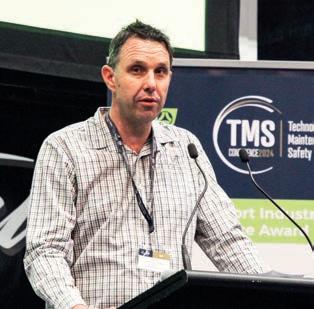


Ian Newey, MD of Newey Transport, said innovation was at the heart of logging. “As a sector, a lot of what we’re seeing today has come out of the Log Transport Safety Council’s desire to push the envelope on stability, load height and technology. In the past five or six years, we’ve seen a steep increase in innovation in log trailers.
“The curve is at a point where you think, ‘How much further can we design these things?’ But EVs and hydrogen-powered vehicles will bring in the opportunity to redesign again.
“The VDAM rule is going to have to be modified so we are not compromising the safety gains made with low and long vehicles to offset emissions gains.”
Newey suggested fleet standardisation to make maintenance programmes a lot easier. “We understand the trucks, front to back, and as many truck owners will be aware, if you have an issue with one truck, typically you’ll have that with all of the same model.” He said the company had found AMT was the way to go, “especially when older drivers extend their careers because of it”.
Newey said community engagement was key. “In the logging sector, we’re always looking for permission from the community to operate. That public support from the rural sectors is really important.” He said engagement had been advanced through the nationwide Wood is Good programme.
Adam Norman, GM of Normans Transport, spoke about running a family owned provincial carrier. “One thing we’re trying to change in our business is to turn our energy to the people that are helping us deliver day-to-day. They are the ones helping us be successful and deserving of our attention.”
He said recent psychometric assessments for the management team
had led to real gains for the company. “It helped us understand how we all operate and how to manage different people, what their strong points are and where to get people internally or externally to fill the gaps.”
He spoke about managing staff levels for business continuity and growth. “There are fantastic operators who are hard to replace. We try run a lean operation but also spend a fair bit of time on succession planning.”
Norman spoke about the company’s focus on technology. “Investing in a transport management system, especially if you’re coming from a paper system, is a whole new way of living. Embracing technology as a tool to help automation of administrative tasks is a focus for us; punching in jobs is not a great use of time.
“So, my key learning is to attract and retain talent that allows me to play to my strengths as a leader, and overall as a team, so we can achieve the outcomes we strive for.”
Don Wilson, owner of OnRoad Transport, said livestock transport was one of the most demanding sectors in the transport industry, but its importance was huge. “It contributes $6.2 billion to the economy (2.2% GDP). Beef and lamb exports alone are worth $5 billion. The sector contributes $2 billion to household income. He said the industry included about 250 operators running approximately 2500 crates.
He said infringement notices were a real challenge for the industry despite the amount of compliance. “These normally go to the transporter and not the farmers, when they are often the ones responsible. Our sector is too weak. Compliance agencies need to reward hard-working transporters more than they do.”
He said taking advantage of future opportunities required each player to
take ownership of the outcome. “We do our utmost to provide quality service to the farmer and meat processing plants. Understanding each other’s difficulties and issues will lead to better solutions. Enforcement should be geared to enabling the export sector to thrive.
He said there were a lot of initiatives involving the livestock transport industry, but a change of attitude was needed. “The people we deal with need to start realising how important our sector is. All the players in the chain need to understand our issues and start applying ‘how can I help’ rather than ‘that’s not my problem’.”
Grant Lowe of consulting firm Glow 45, discussed the work of the South Island Port User Group, “However, there are a lot of common challenges throughout New Zealand,” he said.
“Ports need to manage space well. It’s difficult and expensive to build more space. Peaks present challenges, and they have to keep containers moving. Processing takes seven to eight minutes per container, it’s important for efficiency at the ports that we start finding ways of transporters just taking the top containers.”
He said wind events presented big challenges. “Restacking in heavy winds can require between 100 and 500 moves, at seven to eight minutes per move, creating backlogs. These events are happening about 12 times a year and growing.”
He said the South Island Port User Working Group aimed to promote the key values of health and safety, productivity and chain of responsibility compliance for all South Island port companies and their users; to focus on and prioritise issues of concern affecting South Island road freight operators utilising port facilities; and to improve communication and accountability between all stakeholders involved in the South Island supply chain.
Ian Newey. Adam Norman. Don Wilson.
“This is an incredible sector in the way it all hangs together – the innovation, coordination and hard work. We tend to undersell ourselves and we must recognise the great work that gets done. In some ways, the sector is its own worst enemy; it’s so efficient that the decision-makers take it for granted.” – Justin TigheUmbers, National Road Carriers Association CEO.
“Dealing with government depends on the response you get … The approach we’re taking now as opposed to the previous government is very different.
“The ministers are across numerous portfolios, so relationships with their aids is very important. They want to be seen as successful in their role, so
how can we work with them, so everyone gets what they want?”
– Sarah Toase, CEO, Crane Association of NZ.
Should there be some form of practical competency audit for class 2 pilots?
“Yes, you can do that, but it’s optional. We appreciate there is a benefit to doing it. Once you have your certification, it’s for life. We would say at least every five years, you should reapply. Ideally, practical assessments are something we want to move to.” –Jonathan Bhana-Thomson, CE, Heavy Haulage Association.
“Years ago, we’d go to Parliament, but the previous government really didn’t want to know what we had to say. We were involved

with primary industry, dirty dairy, synthetic fertilising, fossil fuels to drive our trucks, we’re all bad people … I didn’t lose a lot of sleep over it.” – Simon Pedersen, chair, Groundspread NZ.
“The real problem is the fact we have a three-year government cycle. Long-term planning happens, and two years later, someone else comes in and changes it. Unless the government decides to take infrastructure seriously, the whole multi-modal supply chain is going to be affected.” – Diane Edwards, NZ president, CILT.
“There are opportunities and challenges with all governments. They have their agenda, and we have to work out how that
fits in with our agenda … But governments change. Don’t underestimate the value of having friends in Parliament who are sympathetic, and understand the industry. A champion to rely on is worth their weight in gold.”
–Mathew Munro, CEO Australian Trucking Association.
“The No.1 issue facing the broader supply chain is our licence to operate with the community, taking ownership of our own safety and walking the talk instead of making it someone else’s problem … We need to lead by example and do the right thing.” – David Boyce, CEO New Zealand Trucking Association.
 Dave McCoid leads the discussion between the association heads.
Dave McCoid leads the discussion between the association heads.
Bede Cammock-Elliott, founder of seedigital, shared some insights on how AI is shaping the future of health and safety in the transport sector.
“This industry deals in danger. Transport operators have no doubt worked tirelessly designing and identifying critical risks and creating controls around them,” he said.
“A huge challenge for all of us is how do we know that these efforts actually make a difference without waiting for harm to occur? And in a world where we are awash with data when it comes to health and safety, we can often suffer from a complete lack of it,” he said.
“That’s the central promise of AI, to know about pre-harm behaviours, know how your environment may be unwittingly contributing to unsafe behaviour: employees knowing how their behaviour might be putting themselves at grave risk and knowing if your efforts to change are actually making a difference.”
Seedigital developed a solution called seeo, an AI-driven video analysis service as a system offering that tracks workplace safety and hygiene compliance.
“No one comes to work with the intention of doing a crappy job or being harmed,” he said. “What AI shows the
people doing the work is how they put themselves in harm’s way unconsciously.
“AI takes you from a reactive stance into a proactive, pre-harm stance,” he said. “Solutions like seeo enable you to become proactive in mitigating risks by knowing about the extent of your risk before someone gets hurt.”
Leigh Farrow, transport solutions specialist at Teletrac Navman, discussed the role of video telematics and AI in modern fleet management.
“Telematics and AI enables businesses to automate administrative tasks that slow down improvement. And with a driver app and real-time notifications, you can keep your team engaged and focused on optimising performance,” he said.
“There are multi camera options available, but driver-facing cameras are a really important video solution because they provide status monitoring. Cameras use algorithms to detect whether something has gone wrong –for example, the driver is on the phone or there has been eye closure for a number of seconds. The solution gives the driver a warning via an alert that says, you’re getting a bit distracted, you need to change the behaviour, or pull over and take a break, get refreshed. All


those things that are really important to keeping it safe.”
Farrow said most of the cameras were fully connected so that camera data fed into a business’ telematics platform.
“You can use tracking data for other purposes or other compliance tools, so your electronic diaries and other things are all connected together. It becomes a one-stop-shop where you can view all of that data together.”
Farrow said transport operators needed to encourage drivers to understand that cameras were not the enemy.
“They’re there to gain an insight of what might have happened on the road,” he said. “Be transparent. Have a company policy about how you’re going to use the data, so drivers know that when something happens, here’s how the business is going to manage it.
“Some cameras analyse every minute of driving time and give the driver a score, which businesses can use to incentivise good driving behaviour. Use the data to accelerate your driver improvement, to incentivise drivers to perform.
“Technology alone is not the silver bullet. It’s only good if you use it. You need to get the most out of the solution.”


 Bede Cammock-Elliott.
Leigh Farrow.
Bede Cammock-Elliott.
Leigh Farrow.


Three awards were introduced at the 2024 Teletrac Navman TMS Conference

Justin Tighe-Umbers accepts the award on behalf of TDRI Solutions.

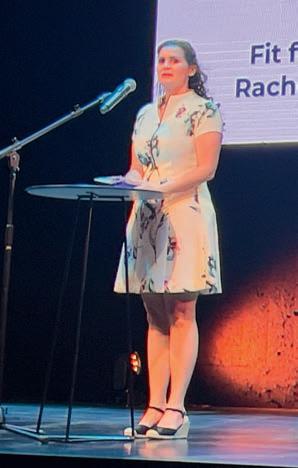
Teletrac Navman TMS Conference
Transport Industry Technology Award, sponsored by PartsTrader
Finalists: CCS Logistics, TDRI Solutions
TrackIT, Engage Solutions
Winner: TDRI Solutions


Teletrac Navman TMS Conference
Transport Industry Maintenance Award, sponsored by BP
Finalists: Josh Verity, Truck Works
Mechanical and Engineering. Grant
Jefferson, MC Transport Repairs. Sam Mason, MC Transport Repairs
Winner: Josh Verity
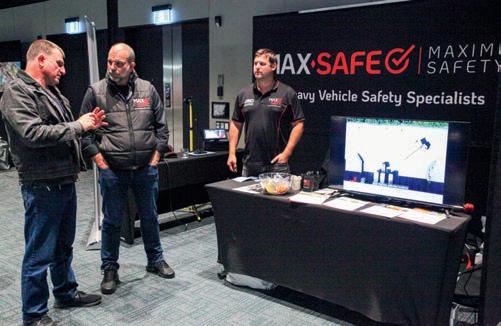
Teletrac Navman TMS Conference
Transport Industry Safety Award, sponsored by ACC
Finalists: Waimea Engineering, Protranz, Viewtech, Fit for Duty Winner: Fit for Duty

Travelling around the country is usually a big part of a transport operator’s business, and knowing you can get the same level of service you expect from your local tyre guy while in a different part of the country is crucial for successful operations.
The National Tyre Assistance Group is New Zealand’s largest support network for the growing number of independent commercial tyre dealers.
The initiative was developed to support New Zealand’s independent commercial tyre dealers by providing a networking platform where members can liaise with each other and offer customers a reliable 24/7 backup and callout service nationwide. More than 50 independent businesses are currently signed up.
This networking platform provides customers of NTA members the same high level of service and professionalism no matter where they are in the country.
“We can offer our customers a national tyre service whilst keeping our independence. The majority of our

customers are privately owned and want to support another locally owned companies,” says Greg Nicholson, owner of Havelock North Tyres and Alignment.
“Being a member of National Tyre Assistance means if one of my customers is in, say, Auckland, I’ve got a guy there to do the job for me. In turn, I might be helping him out next week,” he says.
“So, my customer has peace of mind that wherever they are in the country, I’ve got someone who can help them.”
Havelock North Tyres and Alignment is an independent tyre supplier specialising in all types of tyres – from high-performance cars to farm tractors. The company operates four fully equipped tyre service vehicles with a 24/7 callout service.
Greg says being a member of National Tyre Assistance allows him to provide his
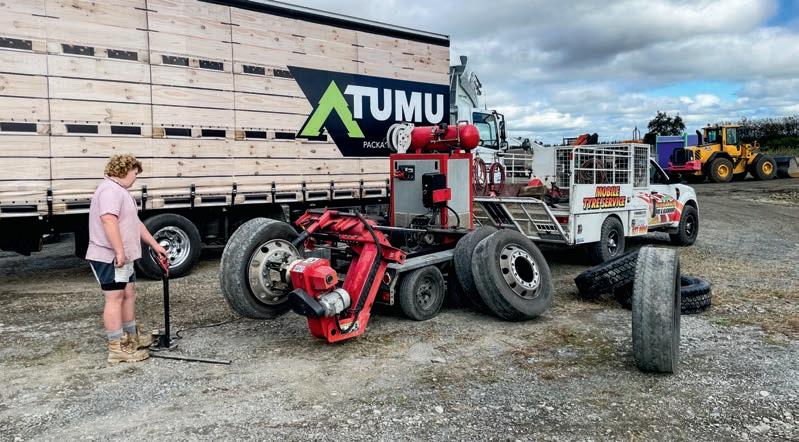
customers with a complete tyre package, wherever they are.
“Local tyre businesses are going to be able to provide a national service to their customers. It’s having the benefits of a big national chain, but the service of a local, and the business retains its independence.”
Greg says there are many benefits to becoming a member of the National Tyre Assistance programme.
“We can order stationery in bulk, printed with National Tyre Assistance, which would otherwise cost a lot of money. There’s also a training programme organised by one of our members, which enables you to get your staff trained independently, so you can show they know what they are doing.
“If you’re new to the tyre business, as a member, you can bring in a trainer to train yourself or staff on site.”
Power Retreads sales manager Paul Campbell says the National Tyre Assistance Group provides independent dealers with a united purpose and a national identity link, giving them the confidence to compete for local fleet accounts travelling nationwide.
“All members of the National Tyre Assistance Group provide a high level of quality service and professionalism to other members of the group, using the inter-dealer charge-back structure, thereby giving confidence and reassurance to their customers on the road,” he says.



Reliable lights are essential when it comes to driving at night, and this is especially true for truck drivers who are often behind the wheel for long periods facing dark roads and unpredictable weather.
Great Whites LED lights feature advanced LED technology, which produces an intense beam that can reach far ahead, illuminating the road and any potential hazards. This is particularly important for truck drivers carrying heavy loads or driving on unfamiliar roads. The high-quality beam produced by Great Whites LED lights ensures drivers can see obstacles and react quickly to avoid them.
Great Whites has unveiled two new innovative headlight solutions to its catalogue, the 7in LED Headlight (GWF1005) and 7in High Beam Headlight (GWF1010).
The 7in GWF1005 and GWF1010 headlights deliver greater performance with long-lasting LEDs. As with the previous Great Whites headlights, they are certified as ADRcompliant for right-hand drive vehicles.
The GWF1005 incorporates park and indicator lights and includes class 1 amber strobe lights that can be synchronised across both headlights. This innovative advancement allows for greater visibility and ensures you are safe on the road without the need for installing additional warning lights or strobes and beacons on your truck.
The GWF1010 features LED park lights and is an ideal replacement for factory-sealed beams or 7in halogen lights.
Offiering a smarter, more intense light source, Great Whites feature a new design with improved UV stabilisation.

Great Whites has also unveiled its innovative Adjustable Beam Technology (ABT). ABT allows you to fully control the beam pattern to best suit driving conditions with the turn of a two-stage dial. Easily switch the lights between full flood light, full spotlight, or both, and separately control the brightness of each, for a perfectly tailored combination beam.
Kits include two driving lights, a driving light harness, a dial switch, and two amber covers. Available in 170mm kits or 220mm kits.

Great Whites LED headlights offer a more intense light source from longerlasting LEDs.

Great Whites are available for purchase through NAPA Auto Parts. They are available at your local NAPA branch. Contact your local rep or call 0800 800 073 for more information.
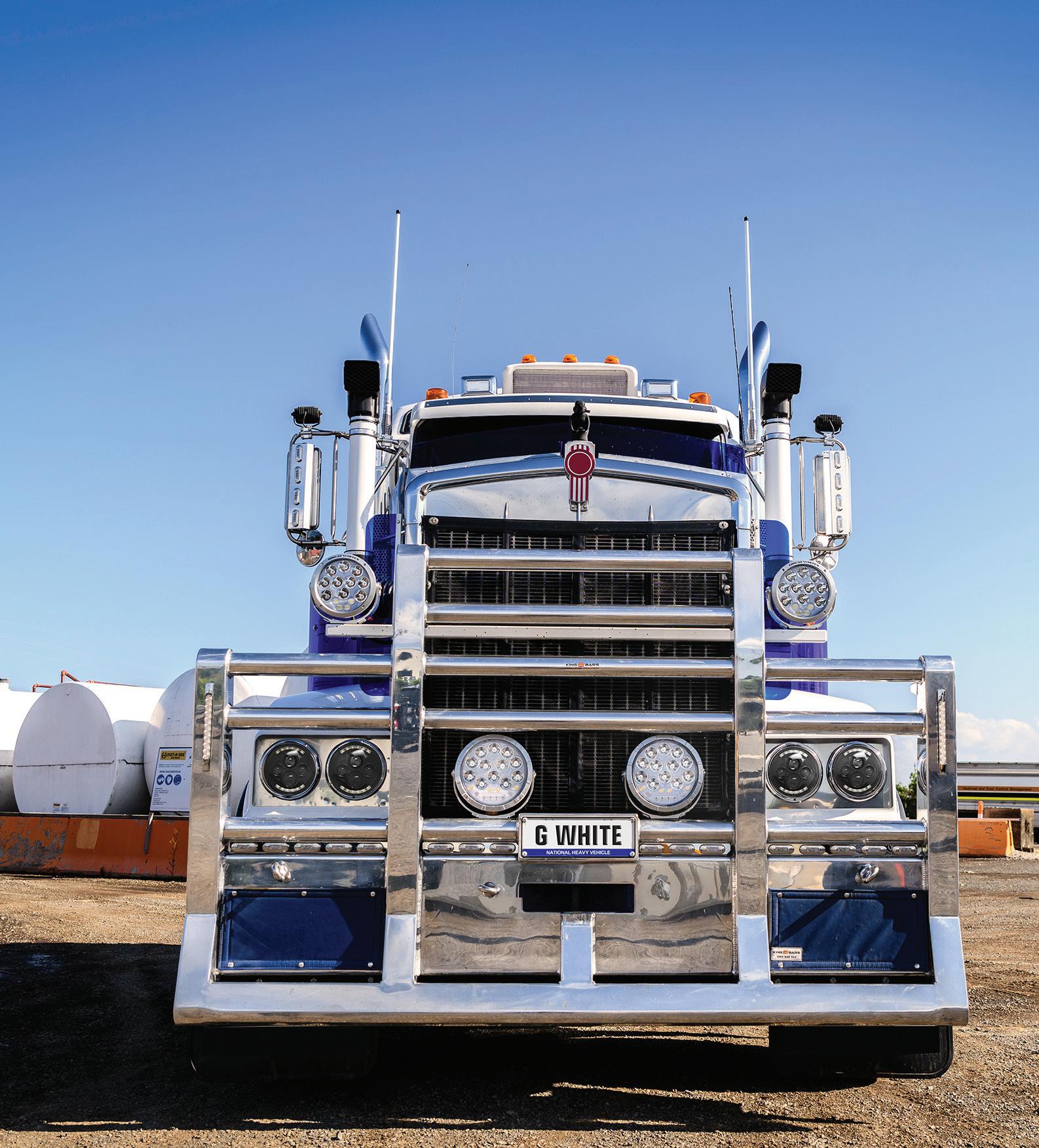




why driver education is so important.
Iwas recently asked to comment on the Easter weekend road toll, which again surpassed expectations and garnered media attention for all the wrong reasons – tragedy rather than holiday festivity. Seven people died in the four days, our worst Easter in three years.
At the time, my initial commentary focused on the increasingly two-tiered roading network emerging nationwide. There are the modern, well-designed, expansive sections of the likes of Orewa to Warkworth, the Waikato Expressway, Transmission Gully, the Christchurch Southern Motorway extension, and then that category of ‘also rans’ lurking at the very end of the exceptional pieces of roading outlined above. You know the roads – where a mere coat of paint separates opposing road users from each other, offering little to cushion the impact of a fellow driver’s poor decision, challenging conditions, or sheer incompetence behind the wheel.
Upon thinking about this further, though, two things emerged – first, our individual risk profile and consequential driving manner, and, second, what I’ll term the ‘outlier’ effect.
In the case of the first, there’s no denying that, as with an array of other fatalitymeasured activities, such as drownings, our disposition to risk and safety plays a significant role.
What I may personally view as safe conduct may be quite the opposite to the driver following me as though they’re determined to hitch a ride on my towbar, yet here we are attempting to cohabitate at 100km/h in the tight confines of a highway. It’s the ‘outlier’ effect I’m more interested in today, though. The term emerged from a book entitled Outliers by Malcolm Gladwell. After observing humans in a range of pursuits, the author perceived a situation where those who had committed 10,000
hours or more obtained a level of mastery difficult to achieve without such time spent. This mastery put those 10,000-hour-plus disciples of the task in another league, and these he deemed outliers.
In the book, the references relate to professional athletes, academics and the like. But the ability to apply this logic to more mundane tasks, such as competently controlling a car at 100km/h, still rings true.
Think about it this way – as a professional
The saying goes that “good judgement comes from experience, and experience comes from bad judgement”.
driver, you’re likely spending north of 40 hours per week on the road in all manner of conditions. In doing so, you’re potentially gaining eight times the amount of experience and exposure as someone whose only time behind the wheel each day is a 10-minute urban commute to work and a trip to PaknSave on a Sunday.
More than that, though, you’re likely to be driving on a variety of roads, exposed to differing hazards, and resultantly learning how to cope with a far wider range of events and scenarios on which to call when things do have the potential to go a little pear-shaped.
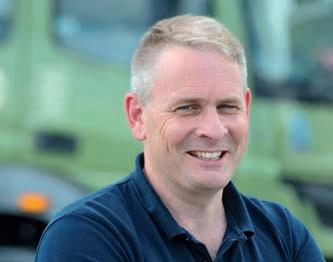
Take this very situation I was exposed to while travelling over Easter myself … Amid a row of convoying tractors travelling between farms, a John Deere perched directly in front of me indicated its intention to turn right. An impatient youth in the vehicle to my rear saw the tractor slowing as his opportunity to pass, not even considering what was about to occur.
To this day, I can’t work out how the said youth wasn’t propelled sideways as he pulled into the path of the turning tractor, but suffice to say, the car stopped a short distance down the road, presumably to change his undies and do a quick stock take of his blessings!
It was a crystal-clear example of a lack of experience jeopardising so many people’s safety. I also know I’m not alone in my experience, and countless readers have tales like this. Sadly, many with far more tragic consequences.
The saying goes that “good judgement comes from experience, and experience comes from bad judgement”. There’s been much dialogue, particularly from the likes of industry supporter Greg Murphy, about much greater emphasis being placed on our driver education system and truly equipping us all a whole lot better from the outset. Until we take driver education as seriously as the true risks we all know exist with it, I fear we’ll continue to see more of these records being broken.
And that’s definitely not an occasion where we want to be an outlier.


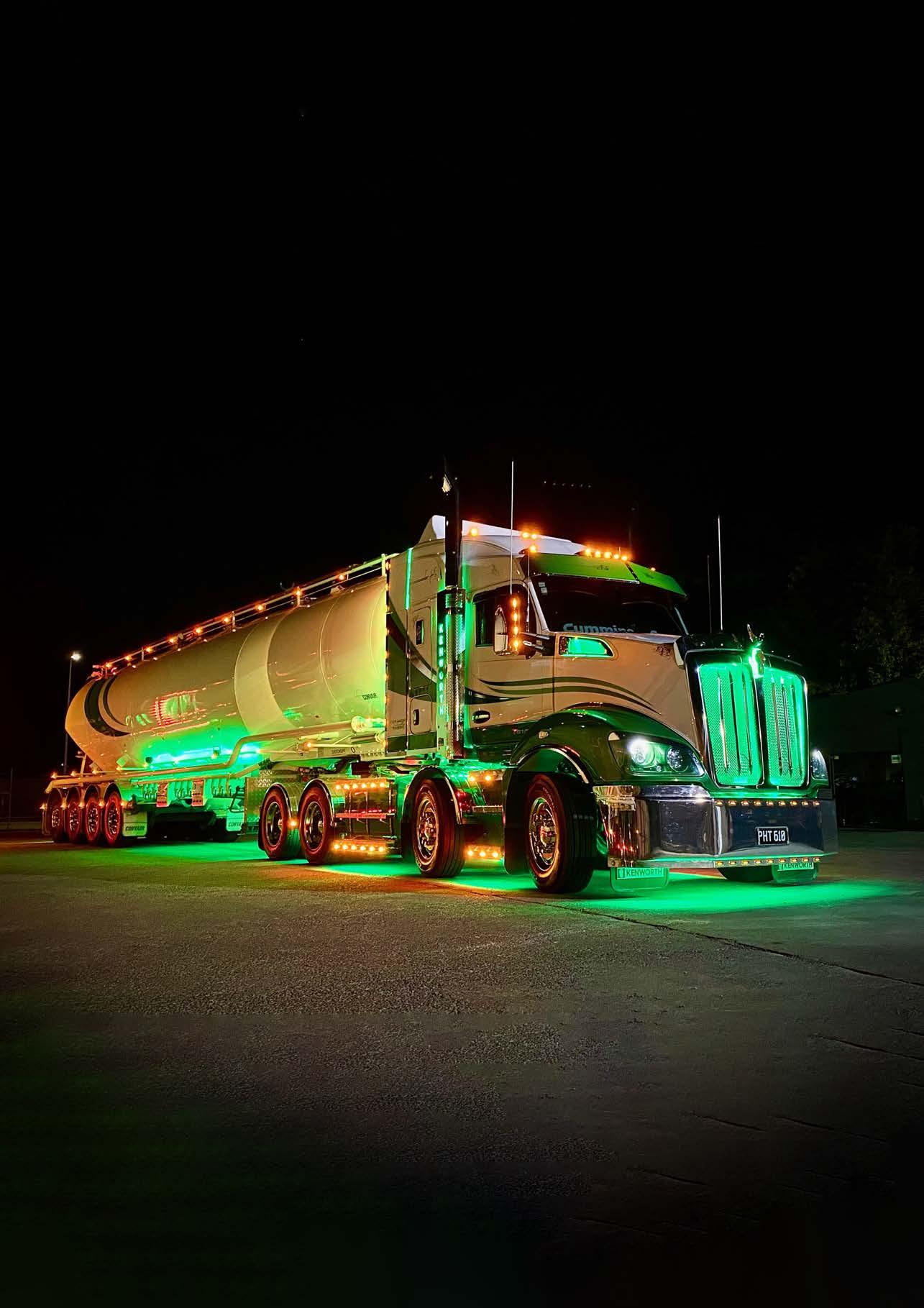




It is tough to stop comparing yourself to others in many facets of life (career, house, car, wealth, relationships, health, body, friends, family, travel and success). It is also true for our appearance – how our bodies look, feel and perform. This can be on a superficial level like, “That guy is more ripped than me”, or on a more performancebased level, “That girl is a lot fitter than me”. Although it can be positive and healthy to aspire to be like someone or to strive towards the milestones they’ve achieved in their health and fitness, it can also be disheartening and detrimental to your progress and journey.
At the risk of stating the obvious, we are all different. Not one body is the same as the other. How we burn fat, store fat, build muscle, lose muscle, etc, is completely different from our friends and family. If I were to do the same workouts and eat an identical diet to all my friends, we would all look completely different.
This can be a bitter pill to swallow when you feel like you’re working hard, harder than your best mate, who always seems to be slimmer or fitter than you and barely has to work for it. It’s also important to understand that outward appearance doesn’t always reflect inward health. People who eat junk food and live an unhealthy lifestyle but still appear to be slim may look the part, but as a whole, they’re unhealthy and unfit if they’re not partaking in exercise and eating a healthy diet. I don’t know about you, but I would rather genuinely be fit and healthy than just look fit and healthy.
There is absolutely nothing we can do to change this fact. The upside is that how someone else’s body reacts to diet and exercise is none of our concern. What we need to focus on is our own backyard – don’t



Find out more about the new tyre stewardship scheme.




Safewise consultant Kaye Byrn examines what to do when mistakes are made in business, and what procedures can be implemented to prevent them.
We all make mistakes, it is part of being human. Some mistakes can be more consequential than others. Hitting someone with a forklift can have more tragic consequences than leaving paperwork back at the yard.
Putting procedures in place to catch these errors and prevent unfavourable consequences is the responsibility of the business owner and manager. Mistakes are not made on purpose; mistakes occur from a lack of awareness, training, processes and complacency.
Here are two scenarios:
1. A mechanic is operating beneath a truck. He motions to the truck’s driver to turn on the engine. It is done by the driver from outside the cab. The mechanic is severely injured when the truck runs him over while it is in gear.
2. A forklift operator wants to drive through a truck’s parking space. The forklift
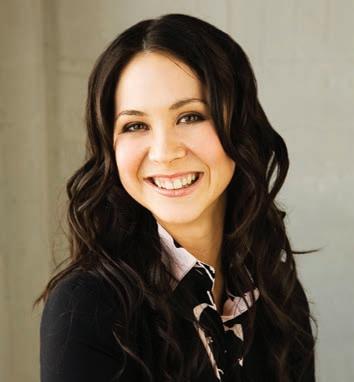
operator turns on the truck to move it. Unknown to the forklift driver, the mechanic working under the truck quickly must roll out of the way.
What errors in judgement led to these incidents?
• The vehicle is in drive. When performing maintenance on a vehicle, it is occasionally required to remove the handbrake and for the vehicle to be in gear.
• From outside the cab, the truck is started. If the truck driver had been in the cab, he would have noticed the truck was in gear.
• In both cases, when the truck is started, the mechanic is underneath it. In the second instance, the forklift operator is unaware of his presence.
• The forklift driver is too preoccupied with his work to consider the truck’s purpose. What could have been done to stop the injury?
The obvious answers are:
• take the keys out of the truck and store them in a safe place, such as the mechanic’s pocket;
• if the keys are in the ignition, mark them with a “do not use” tag;
• always start a vehicle from the driver’s seat, and;
• make sure no one is underneath or behind the vehicle when it is started.
Every one of these safety measures establishes a framework to prevent human error. It would be best to check and ensure
that nobody was underneath the vehicle. Using two or more of these decisions decreases the ‘fail space’ where errors exist. People are going to choose the least resistance path. This must be acknowledged; the pathways must be identified, and the systems in place must safeguard the workers.
Kaye Byrne is a health and safety consultant who works for Safewise, a health and safety consultancy organisation.

Kaye has been in the health and safety field in one way or another for the past 10 years, most recently as a consultant. Kaye has experience working with many different industries and people. She holds a New Zealand Diploma in Workplace Health and Safety Management (level 6) and is a member of the New Zealand Institute of Safety Management.
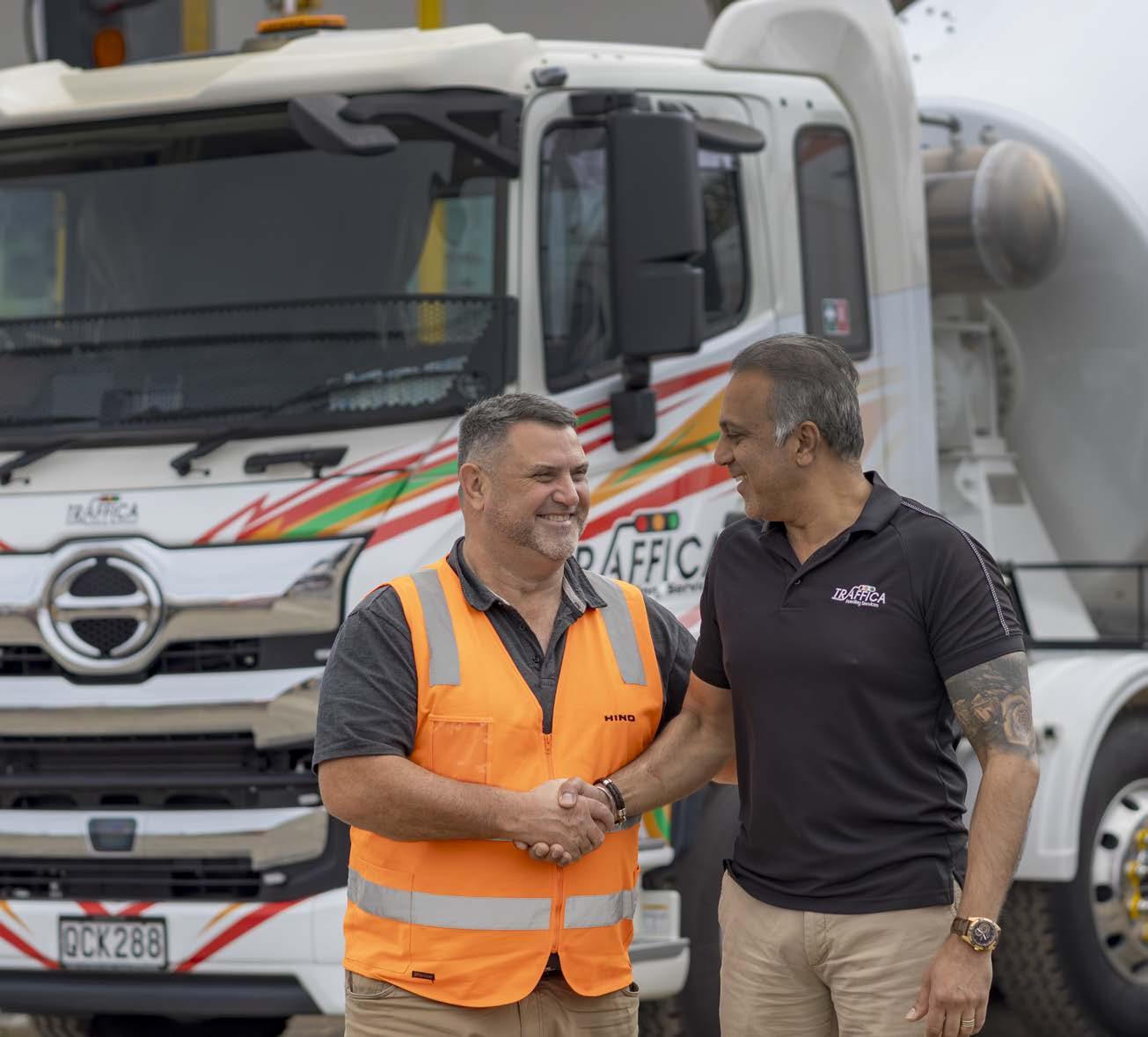
Telephone: (09) 985 5609 mobile: 021 326 642 danielle.beston@trafficlawyerauckland.co.nz



“I’m
Beston discusses the broader implications of a staff member’s employment classification.
An employee can seek a declaration from the Employment Court regarding their employment status. A recent example is the case of E Tū Inc v Rasier Operations BV (2022) 19 NZELR 475. In her judgement, Judge Inglis found the four drivers who drove for the global rideshare platform Uber to be employees rather than contractors under section six of the Employment Relations Act 2000 (the “ERA”). The court identified that the contracts given to the drivers were presented as non-negotiable, emphasising the power imbalance between the employer and the drivers who were granted declaratory relief. Although the chief judge of the Employment Court emphasised that her decision was just about the four drivers named in the case, it was clear that several companies have interpreted it as having broader ramifications because they have appealed against the judgement. There is a fear that the floodgates will open for thousands of workers to claim rights and protections such as holiday pay, sick leave and minimum wage so employers will eagerly await the Court of Appeal’s decision.
Before delving into the case specifics, Judge Inglis outlined the legal framework for determining employment status, stressing the importance of interpreting job status with a purposeful lens. The judge said that the ERA served as social legislation with a broad protective aim in regulating the labour market and ensuring minimum standards. Referring to precedent, she noted the absence of a definitive test for distinguishing between employees and non-employees, highlighting the need for a nuanced and contextual analysis guided by the act’s overarching purpose and objectives to determine if an individual qualifies for these safeguards.
The judge examined and scrutinised the dynamic between Uber and its drivers, considering various factors. While Uber’s operation structure acknowledges traits of independent contracting, such as drivers having the flexibility to choose their own hours, the prevailing evidence highlighted Uber having significant control over its drivers. Such control encompassed Uber enforcing an array of rules, determining trip fares and a contractual arrangement exclusively written by Uber without input from drivers.
Despite the drivers having flexibility, the judge found that they were bound by Uber’s terms and conditions and were assimilated into Uber’s operational structure, indicating an employer-employee relationship. Uber’s argument that they were not the employers of these drivers but merely a ‘facilitator of business arrangements’ between drivers and customers, was rejected.
The drivers maintain that Uber’s misclassification of them as contractors denied them the minimum wage, holiday pay, protection from unjust dismissal, KiwiSaver contributions, and the right to unionise and collectively bargain. Union lawyer Peter Cranney, who represented the drivers in the Employment Court, said, “The most important element is that Uber determines completely the price of the trip. Completely. And in relation to the so-called driver-passenger contract, if there is one, it’s a very strange contract because every aspect of it is decided by Uber, not the passenger.”
Uber has argued it does not have as much control over drivers as the unions suggest and wants a judgement ruling that drivers are employees and not contractors set aside and sent back to the Employment Court. Lawyer for Uber, Paul Wicks KC, said, “Each driver had complete flexibility and choice over when they worked, for how long and where, and that freedom is wholly different to an employment relationship, which is

typically structured around a clear obligation to work certain hours … They had other work commitments and chose to log on to the Uber app when and where it suited them.”
He also asserts that the Employment Court failed to appropriately consider the intention of the drivers when they signed up to work for Uber, arguing drivers knew what they were getting into. But more importantly, Judge Inglis had put too much weight on the drivers’ vulnerability and used this to tip the scales towards them being deemed to be employees.
The Employment Court decision marks a significant step in acknowledging workers’ rights. It establishes a precedent that puts employers under heightened scrutiny regarding the classification of their workers, which could lead to financial, reputational, and legal liabilities and challenges. As a result, employers, especially those using similar flexible work arrangements to Uber, may need to review their practices and operational structures in light of this decision.
Traditionally, having little control over a worker’s schedule and location was often considered a sign of that worker being a contractor rather than an employee. However, the recent ruling in this case suggests that flexibility is now less crucial in determining the level of employer control over their workers and, thus, their employment classification.
Instead, employers should prioritise ensuring that their workers receive minimum rights and entitlements, and should be mindful of the need for fair negotiation and transparency in employment contracts, regardless of the worker’s skill or position. This is crucial for addressing the imbalance of bargaining power between businesses and contractors vulnerable to unfavourable outcomes.
Please note that this article is not a substitute for legal advice, and if you have a particular matter to be addressed, you should consult with a lawyer. Danielle Beston is a barrister who specialises in transport law, and she can be contacted on (09) 985 5609 or 021 326 642.

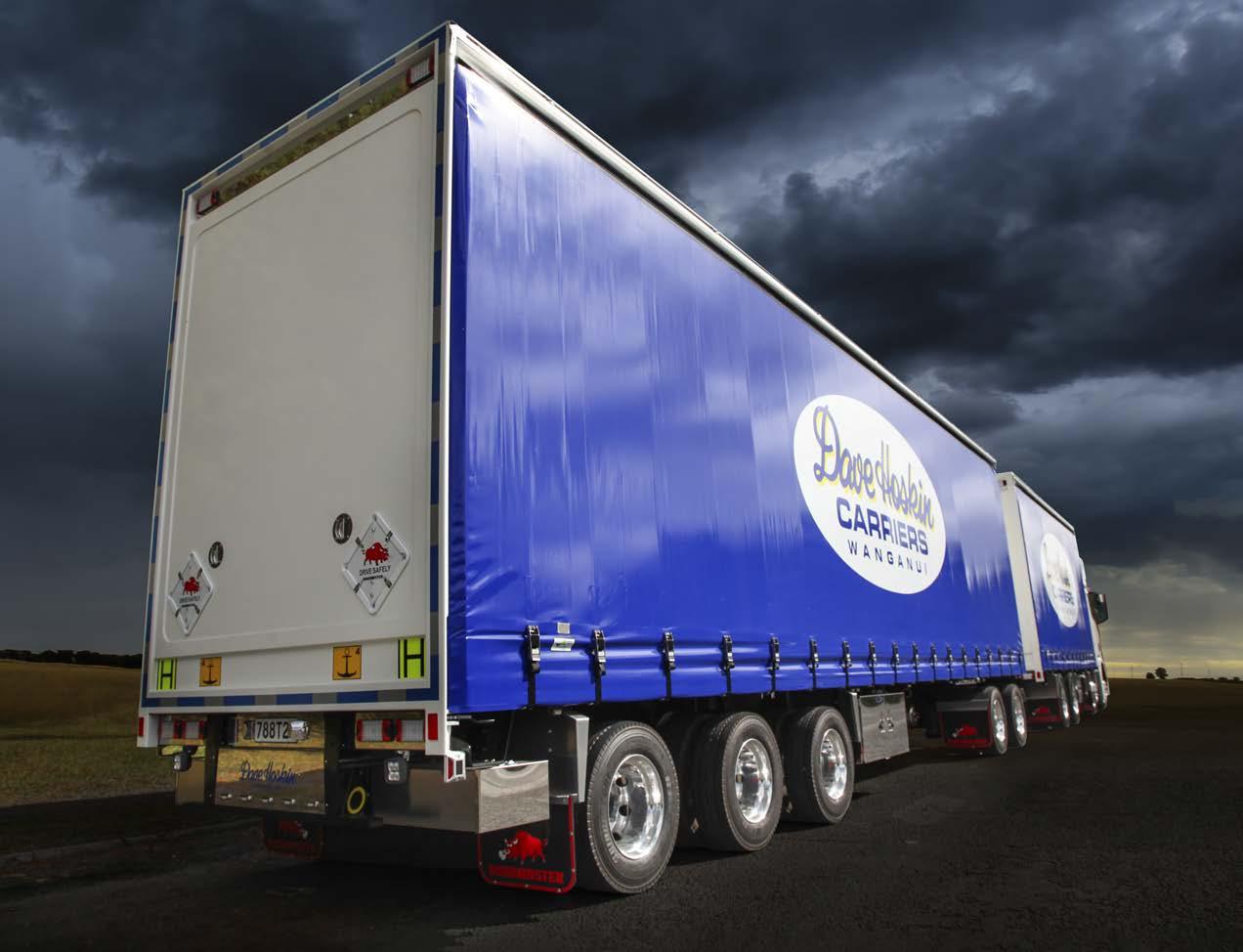

‘WET SPEC’ GLIDEMASTER 9-AXLE TRUCK & TRAILER COMBINATION, 11.500MM 5-AXLE TRAILER & 7.500MM TRUCK BODY


Customised FOr:



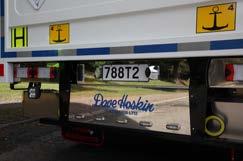
FEATURES:
• Upstands with waste effluent system
• Custom stainless steel dock cart infill
• Twin 1200mm alloy tool boxes with shelves and stainless steel doors
• Alloy half guards
• Custom rear mounted dunnage box
• Hella lighting package

Really big climate stuff happens in the oceans … In this first of a two-part analysis, we look at sea-level rise and how warming oceans buffer us from the worst of climate change.
We might imagine that overheated air, drenching storms and parched or swamped land epitomise the climate emergency. But the places we see least, the vast expanses and depths of the oceans, are almost ground zero (water zero?) for climate impacts.
Although the climate emergency concerns rising temperatures, because less heat escapes into space, we rarely hear about ‘stored heat’. Where does that extra heat actually go?
NASA can answer: “About 90% of global warming is occurring in the oceans.” Wow! And it seemed the atmosphere was doing the heavy lifting. NASA then explains the extra heat in the oceans is an eyewatering “360 zettajoules since 1955. A zettajoule is a sextillion joules or 1021 joules.”
Got that? Me neither! But I figured out that to heat the sea that much since 1955, we’d need 300,000 Benmore Hydros running full bore, 24/7. Eyewatering on steroids.
Regardless of the numbers, we should be seriously worried and profoundly grateful. Our home planet would be unliveable if that heat had gone straight into the air. “The top few metres of the ocean,” NASA adds, “store as much heat as Earth’s entire atmosphere.”
But that doesn’t make it okay; it just buys precious time (time we’re busy squandering). And hotter oceans cause enough problems as it is, such as escalating “ocean heatwaves” that stress ecosystems everywhere – like killing countless penguins in Northland, millions of farmed salmon in Marlborough, and bleaching sponges in Fiordland.
“If sea-surface temperatures … are warmer than normal,” says heatwave expert Luke Harrington, “that will generally increase the risk [of severe weather].” Hotter seas make for hotter air and wetter, wilder weather.
So when we’re next at the beach and find the sea nice and warm, let’s remember there’s a big price tag attached.
Another price is sea level rise (SLR). As glaciers and ice caps melt at record rates, they release vast quantities of water that had been

Lindsay Wood, MNZM, is founding director of climate strategy company Resilienz Ltd, and in 2024 was made a Member of the New Zealand Order of Merit for services to climate awareness and environmental sustainability. Lindsay is active in policy arenas, develops tools to support decarbonisation, and speaks, writes and broadcasts widely on climate issues.


safely locked away. Lynley Hargreaves, in Vanishing Ice, describes New Zealand glaciers melting a staggering seven times faster than at the start of this century. Really? Seven times faster than 20 years ago? “Every 500m we drive,” she reports, “melts a kilogramme of glacier ice.” Gulp.
Meltwater deepens the oceans by about 2mm per year. Factor in that water expands as it heats, adding 1mm-plus per year, and the current SLR exceeds 3mm annually.
And SLR brings other consequences – for example, saltwater intrusion into aquifers, groundwater and low-lying horticultural land. And, incredibly, the redistribution of vast volumes of meltwater is affecting the Earth’s rotation, and distorting its crust.
And talking of distorting the crust, New Zealand’s SeaRise programme created waves with the above map. In places, coastal land is rising and counteracting SLR (brown). But, in a double-whammy, most of it is sinking (blue) at rates that effectively double SLR or worse. Out-of-sight oceans offer heaps of food for thought, and next month, we’ll explore more when we dive into freezing water and acid seas to explore two super-important but less-discussed changes to our oceans.

Contacts:

As the financial year in New Zealand wrapped up on 31 March, it’s time to get our ducks in a row. For businesses, it’s more than just crunching numbers – it’s a chance to reflect, plan, and set the stage for the year ahead.
First off, let’s get the dates straight.
Unlike the regular calendar year, New Zealand’s financial year runs from 1 April to 31 March. This gives smallbusiness owners a chance to take stock of their finances, plan ahead and ensure they’re ticking all the tax boxes.
Tax time is a big deal. You must file your annual income tax returns and pay any dues before the deadline hits. Good recordkeeping and clear financial reports make this process a whole lot smoother. Accounting software like Xero and Hubdoc have eased this burden since I started in accounting 20 years ago, when it was the norm to receive boxes full of paper to work through. Now we have live access to what is happening, and
you can even file your invoices in the system to save time digging them out later.
Prep work is key. A handy checklist can help you dot the ‘i’s and cross the ‘t’s, from checking your financial records to tidying up your stock inventory.
My advice is to get this done as quickly as you can, then you can look at the year ahead. How did the past year go? Are there any trends you noticed in your income and spending? Budgeting and planning are all about learning from the past and setting yourself up for success.
And, hey, if all this number-crunching has your head spinning, don’t sweat it. Accountants are there for a reason. They can take the stress out of financial management

work is key. A handy checklist can help you dot the ‘i’s and cross the ‘t’s, from checking your financial records to tidying up your stock inventory.
and help you make smart decisions for your business.
So, as the financial year closes, roll up your sleeves, get organised, and set your sights on the road ahead.
• If your accountant hasn’t contacted you already with a checklist – be proactive and reach out to them and ask what you need to provide to get your accounts prepared quickly.
• Don’t procrastinate – although some questions could relate to one year ago, it is better to tackle this now, it’ll only get further away. Also, for those businesses that only catch up with their accountant once a year, the sooner you do this, the more valuable it will be to make any necessary changes.
• Look into budgeting and forecasting – If you haven’t before, this type of planning can be invaluable to a business’ success and a great measure throughout the year as to how you are tracking.
• Finally, remember to stop, take stock and celebrate what you have achieved.

Roylance Watson is a chartered accountant and associate at Vazey Child Chartered Accountants in Hamilton.
Email: roylancew@vazeychild.co.nz
Phone: (07) 838 5988 Website: vazeychild.co.nz
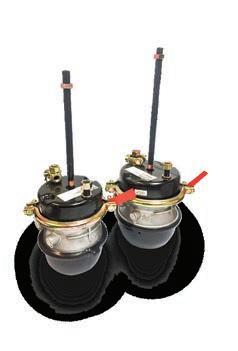


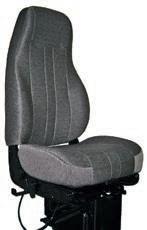




















NZ Trucking Association can be contacted on 0800 338 338 or info@nztruckingassn.co.nz

John Sansom, HARMfree Transport and Logistics Programme Manager, NZ Trucking Association, speaks on championing innovative work design principles.
In the bustling world of transport and logistics, embracing Good Work Design is like discovering the industry’s holy grail. It’s a quest not for the faint-hearted but for those willing to dive deep into the nitty-gritty of tasks, procedures, processes and worker competency. This approach transcends the mere avoidance of physical mishaps, venturing into the realm of psychosocial hazard mitigation, redesigning work processes and ensuring a well-rounded safeguarding of worker wellbeing in an industry that never hits the brakes.
Good Work Design’s success hinges significantly on senior leaders’ commitment. By championing innovative work design principles, they can substantially improve operational efficiency and worker wellbeing. Engaging workers becomes crucial in a world where operating heavy machinery and enduring long distances is just another day at the office. High levels of engagement do more than boost productivity; they also lead to a noticeable decrease in safety incidents. Cultivating a work environment that values open communication, recognition and growth opportunities ensures that drivers and operators are not just physically present but are fully invested in their roles. Making engagement a priority is key to ensuring a safer and more productive journey on the road.
In the ever-evolving landscape of transport and logistics, continuous improvement and success are achieved with a robust feedback loop. Actively listening to workers and acting upon their feedback is critical. Adopting a ‘Manage By Walking Around’ approach allows leaders to engage directly with their teams on the ground,
gathering invaluable insights. This dedication to turning feedback into action cultivates innovation and inclusivity.
Advancing the industry requires a holistic approach to work design, integrating physical, biomechanical, cognitive and psychosocial aspects of work with the unique needs and capabilities of the workforce. This comprehensive strategy ensures that every job aspect is tailored to promote health, efficiency and satisfaction among drivers and team members. By prioritising holistic work design, we don’t just optimise operations; we become more resilient, adapt and thrive.
The discovery phase is a critical time for innovation and improvement. Creating a psychologically safe atmosphere during this phase is paramount, laying the foundation for openly understanding worker experiences and identifying potentially harmful work features. Ensuring teams feel secure in sharing their thoughts and concerns allows for the uncovering of invaluable insights into making operations safer, more efficient and more supportive of workforce wellbeing.
Transitioning from the discovery phase requires a strategic shift towards defining specific problems or opportunities. This critical step involves evaluating the value and impact of the chosen focus areas, directing efforts toward initiatives that promise significant benefits for operations, safety and workforce satisfaction. Identifying a problem is just the beginning. When initial discovery reveals issues, a deeper dive – via direct observation, engaging conversations with workers, or thorough data analysis
– is necessary. This deeper understanding enables the development of more effective and sustainable solutions.
After pinpointing a specific problem, the next step is implementation. Developing and delivering tailored solutions, tracking their impact and being ready for necessary adjustments are key to success. This dynamic process allows for the refinement of strategies in real time, enhancing efficiency, safety and satisfaction across operations. Designing out problems before they arise not only prevents harm and costly disruptions but also leads to significant cost savings and ensures your operation remains competitive and sustainable.
As the workforce in the transport and logistics industry becomes older and more diverse, there’s an opportunity to redefine Good Work Design to accommodate and embrace this diversity. Creating an inclusive environment that values the unique perspectives and needs of every worker positions businesses as employers of choice. Good Work Design that caters to workforce diversity enhances satisfaction and retention, driving innovation and adaptability.
The journey of Good Work Design in transport and logistics is not just about streamlining operations, redesigning work processes and enhancing safety protocols. It’s about creating a future where the industry not only meets the current challenges head-on but does so with an eye towards innovation, inclusivity and resilience. By ensuring committed leadership, continuous feedback, holistic work design and embracing workforce diversity, our sector is well on its way to not just navigating the present but guaranteeing we thrive in the future.
For more information and resources on Good Work Design, check out harmfreetransport.nz.



GCA8
• Superior sidewall cut resistance.
• Long tread life, exceptional casing durability.
• Enhanced stability and riding comfort.
• The extra-deep tread pattern is specially designed for loaders.
• Excellent performance on extremely rocky surfaces, in open pits, quarries, and underground mines.
GCA2
• Non-directional deep tread pattern designed for muddy and soft surfaces.
• Excellent traction and floatation offer comfortable handling.
• Superior long tread life and excellent puncture resistance.
• Low rolling resistance and fuel economy.




GCA7
• Unique non-directional traction patterns ensure optimum traction and prolongs tread life.
• Superior sidewall cut resistance.
• Good self-cleaning with groove stone ejector.
• This deep tread is particularly suitable for loaders and dump trucks operating in quarries or mining.
GCA3
• Applications: Articulated dumper, dozer, loader, and graders.
• Non-directional traction and standard tread depth pattern design.
• Excellent performance supported with heat resistant compounds.
• Primarily designed for mining, off the road, and muddy surfaces.








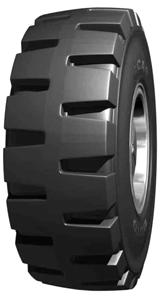









National Road Carriers Association can be contacted on 0800 686 777 or enquiries@natroad.co.nz
James Smith GM policy and advocacy
James Smith, GM policy and advocacy, National Road Carriers Association, discusses what accredited employers need to demonstrate to meet Immigration
As our workforce ages (the average age of Kiwi truck drivers is 59), an increasing number of employers have started sourcing staff from overseas. This became easier with the accredited employer programme in 2022 and then the sector agreement that allowed class 4 and 5 drivers a pathway to residency after two years.
Both policy shifts resulted in the surge of overseas workers who arrived in 2022 and 2023.
Many employers seized upon the opportunity to fill vacancies across all parts of their businesses where there was no local supply of skilled workers.
While the current economic situation has eased the pressure with more staff looking for jobs, we know that when the economy lifts, the skill shortage will return, and due to the ageing domestic workforce, it is likely to be more acute than before the slowdown.
On 1 July, the first wave of visas issued to overseas workers will expire, as will the expiry of many employer accreditations.
If you are an accredited employer or if you employ staff in New Zealand on a work visa, you need to take action as soon as possible to ensure this continues smoothly.
Immigration New Zealand will not just roll over accreditation. Employers will need to demonstrate they meet the requirements. There has been exploitation and it is also clear many employers did not fully understand their ongoing obligations
or the obligations of their workers should they wish to stay in New Zealand. It is acknowledged that the process of reopening New Zealand was rushed through to address the demands from businesses that were constrained by a lack of staff.
• Your business has not made a loss over the past two years.
• Your business has had a positive cashflow each month for the past six months.
• Your business has enough capital or external investment to remain viable.
• Your business has a credible two-year plan to ensure it remains viable – for example, a revenue forecast or cashflow projection.
• Your business must also comply with New Zealand immigration law, employment and business standards.
• You and any key people in your organisation cannot be on the Labour Inspectorate’s stand-down list or permanently banned from hiring migrants.
You will also need to demonstrate you are a reasonable employer and have processes to ensure all workers comply with the conditions on their visas.
If you have employed under the sector agreement that leads to residency for
class 4 and 5 drivers, you must prove you are meeting the minimum hourly rate of pay and the employee is meeting their requirements.
Do not wait until July to get this review process underway because, if you have gaps, you will not have time to rectify them before your accreditation expires. If your accreditation expires, any workers you employ will have to leave your business upon the expiry of their visas.
Self-assessment tools are available on the Immigration New Zealand website, or if you think you may have a challenge, reach out to one of the NRC team who can put you in touch with an immigration specialist who understands transport.
Now, while the economy is soft, is an opportunity to review whether you have the right people in your business and access to the right skill sets for when the economy recovers and the workload increases.
National Road Carriers has access to experts in this specialised field, so if you feel something may trip you up, or if you require more information, contact one of our team as soon as possible so we can either answer the question directly or put you in touch with someone who can.



VARTA ProMotive AGM is designed to optimally support drivers and their trucks during their time on the road. Since the demand for nonstop transportation services requires trucks to be on the road every day, drivers spend more time in the cabin than ever before. The Varta A1 AGM truck battery leads with high vibration resistance, excellent charge acceptance, extended cycle life and increased depth of charge, allowing fleets to equip drivers’ cabins with hoteling functions without draining the battery, avoid downtime and maximise productivity.

It all starts with




Visit our portal to find your local supplier. www.varta-automotive.com/en-nz

Transporting New Zealand can be contacted on (04) 472 3877 or info@transporting.nz
Dom Kalasih interim chief executive
Too often there are singlesolution goals, writes Dom Kalasih, Transporting New Zealand interim CEO.
There were a lot of happy faces in the room when I attended a recent meeting at Transport Minister Simeon Brown’s office.
Almost all the transport sector acronyms were there – the MIA, VIA, AA, MTA – plus the three trucking organisations, and everybody was right behind the Government Policy Statement on Transport.
One of the things popping up at the meeting was the proposal to apply road user charges to all motor vehicles instead of using petrol taxes to fund roading. (That brought about the only real sign of dissent at the meeting, as the AA wasn’t too keen on that idea. But it has a membership base to represent, and that’s fair enough.)
The reason for the suggestion is that the improving fuel efficiency of new cars allows them to travel further on less gas, so they are actually paying less per kilometre covered to maintain the roads via a pure petrol tax.
But the MTA, the importedvehicle folks and Transporting New Zealand all liked what was being said because, from a user pays
perspective, the current system isn’t really fair, and revenue is dropping.
The change in how things are being done with infrastructure is happening thick and fast. The only problem with that is this change can occur with every regime change MMP throws our way.
That’s why the freight sector groups support the creation of the National Infrastructure Agency We need something with a vision of infrastructure that lasts for 30 years. It takes time to plan, budget and build these significant projects. Having
them chopped and changed every three or six years isn’t the way to spend our roading money wisely.
On a very similar subject, we are also pleased with the proposed fast-tracking of project consents. New Zealand’s had a long history of having many projects being bogged down in expensive bureaucracy.
That’s not to say rapid consenting isn’t contentious. My daughter was planning to take part in climate protests. Forest & Bird, which at least one of our staff members belongs to, promoted the demonstrations as a way to “show politicians that we contest the Fast-Track Approvals Bill”. You have to love democracy! Which kind of brings me round to what I call the ‘World of And’. Too often there are singlesolution goals put out as one group’s reason for existence in the transport sphere. Either everything has to be about safety, or everything has to be about productivity, or everything has to be about saving the planet right now, and not next Tuesday, because then it would be too late, and we’d all be doomed.
How about we love productivity (which we do) and we care hugely about safety? Which we do.
The change in how things are being done with infrastructure is happening thick and fast.
And how about we care about our environment and we care about building an infrastructure that is free-flowing and resilient? And is what people should aim for. And is good.







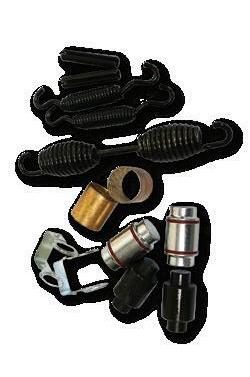












It did not come as a great surprise to read on 16 February, the statement from the chair of National Road Carriers (NRC) that it and its ally, New Zealand Trucking Association, will no longer collaborate with Transporting New Zealand (TNZ) on road freight industry-related issues. It has been evident for some time that there was a level of animosity between the two groups, but exactly what it was is difficult to fathom, especially when both groups claim to have the same overall objectives.
I certainly hope the attitude towards each other we now see resulting in the industry’s joint representation being ripped apart is not simply a result of conflicting personalities. Looking back at the origins of the NRC and TNZ, there is perhaps some irony in what has happened. TNZ has its origins in the mid-1920s as the Master Carriers Association to lobby the then government, very much focused on rail transport, to give more consideration to the growing road freight industry. NRC was established in the mid-1930s because of the belief that the Master Carriers were dominating while smaller, mainly town carriers, struggled.
Let’s hope that somehow common sense prevails because all I can see is that the industry will be the loser. Any organisation heavily reliant on membership and sponsorship for income risks being moulded by its backers, particularly in today’s economic climate.

And let’s hope that we do not see the emergence of a new player, as this could further split industry representation.
I cannot figure out what has happened to this country. Several recent revelations are unbelievable to the point of being almost laughable. The train tracks on part of the line through the Wairarapa are about 6mm too close, causing vibrations that will take some time to fix. In the meantime, there is a speed restriction on parts of this line. We have several police stations that are mouldy and well past their use-by date. We know the roads, particularly the state highways, are a mess and will take years to fix. Many of our hospitals are in urgent need of refurbishment. Recently, we were told that some school refurbishment programmes may have to be put on hold because there is insufficient money to do the work.
It is not unusual for an incoming government to blame the previous administration for the issues they have inherited, but playing the blame game will only work for a short time, and that time is almost over. The voting public will soon get sick of it. We don’t want to hear endless stories about whose fault it was. What we want is the detail of how and when the issues will be fixed. The infrastructure that is collapsing almost before our eyes does not need to look pretty, be gold-plated or designed with an architectural award in mind. It needs to be functional and do its job efficiently. How difficult can that be?
Seasoned readers will recall that before Roger Douglas and Richard Prebble spread their capes over New Zealand, there existed an organisation called the Ministry of Works. The MOW was into most things that involved building and looking after the key infrastructure required to keep the country going.
From getting funding to the design and building, the MOW was the government of the day’s go-to organisation. It built roads, power stations and state houses, did maintenance on hospitals, schools and police stations. It had several standard designs that could be easily adapted to suit the needs of the community and location it was involved with. Many of these are still around today if you look. Sadly, some have been allowed to deteriorate over the years to the point that the only option is to knock them down and start again.
The MOW, along with several similar organisations such as the Post Office and Railways, provided numerous employment opportunities for school-leavers who, after gaining experience, would go on to work in the private sector. Under Messrs Douglas and Prebble, however, these organisations were deemed to be too expensive and private enterprises could supposedly do things quicker and cheaper. It would be an interesting exercise to look back now and see if this philosophy worked.
Yes, the system back then was very hierarchical and overly bureaucratic, and change was needed, but things got done; the system worked. We cannot say this about the state of things we are confronted with today.
Looking at history can teach us a lot but, unfortunately, the decision-makers don’t appear to be prepared to do this. Instead, they are content to box on with their views regardless of the outcomes and what history tells us.
The Accidental Trucker







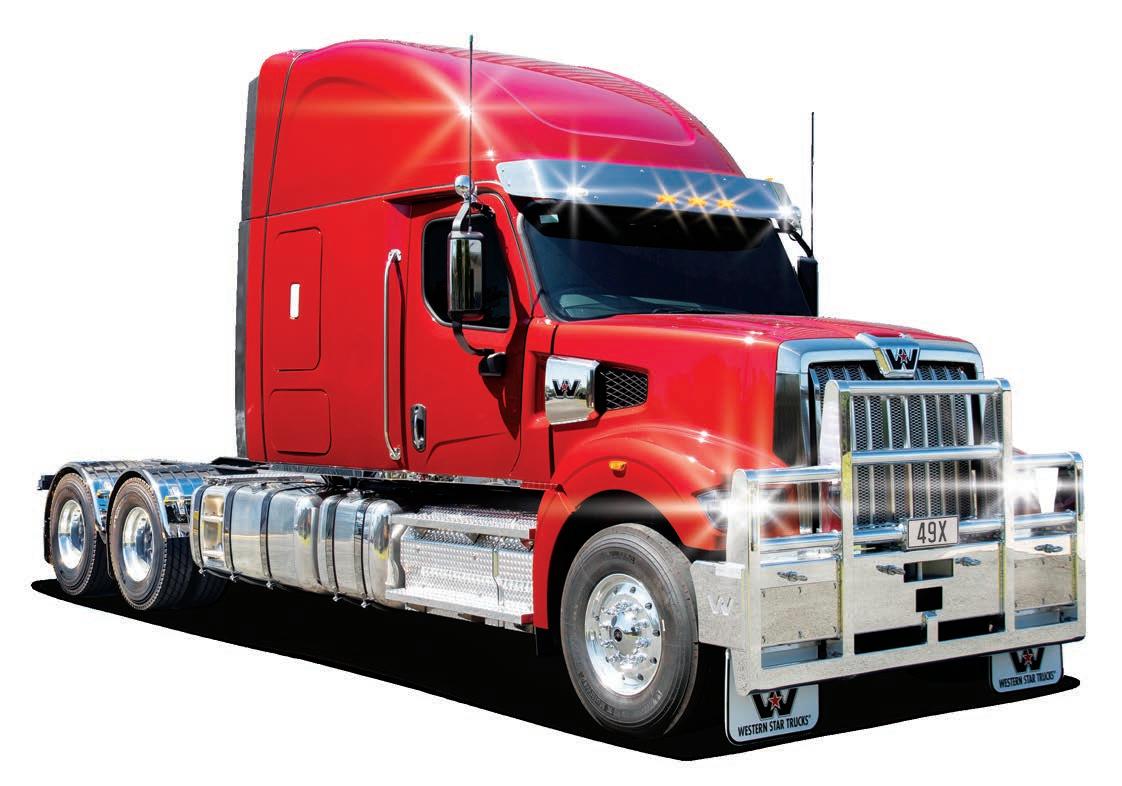
scania.co.nz


